 |
Travels across North India
with temples, holy rivers, bathing ghats and traces of the Raj
Feb-March 2014
|
We started by revisiting a couple of old favourites, Daman and Udaipur, then went searching for 'hidden traces of the Raj' in Old Delhi. Then we headed into new territory; monkey-ridden Vrindavan which we didn't like because the monkeys were so threatening, Gwalior which we liked because of the interesting monuments and the relative peace and quiet up in the fort, and Orchha which is definitely one of our favourite places; compact, manageable and full of interesting sights. Then Khajuraho world heritage temples site, little-visited Chitrakoot with the first of the bathing ghats, Allahabad where sacred rivers meet and Varanasi, with its fantastic river-front. Finally to Calcutta and a river-boat trip through the Sundarbans mangrove forest. Red route is overland, blue is flying. |
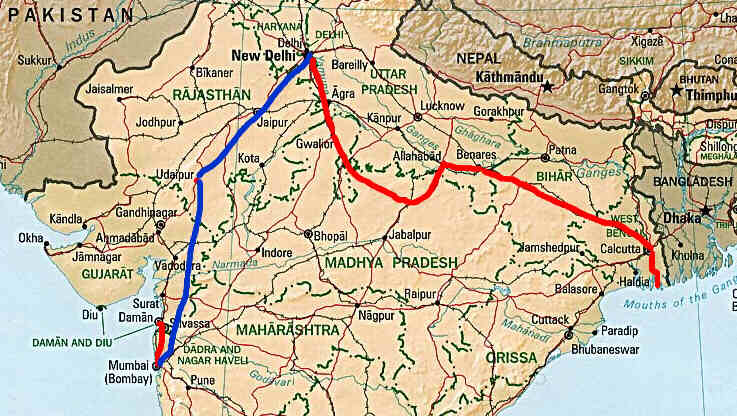
|
Daman
|
Sun 23 Feb. We had a very nice flight on Qatar Airways to Mumbai via Doha.
Mon 24th. We arrived in Mumbai at 3am but our pre-arranged taxi wasn’t there to meet us. We phoned him and he claimed he thought it was tomorrow, so we got an airport taxi after an awful lot of haggling for 4,500 Rupees (45 pounds – the exchange rate is so easy, 100 Rs to the pound) for the 180-km drive through the darkness to Daman. The Marina Hotel, a historic wooden-beamed Portuguese merchant's house, was just as nice as we remembered and they kindly let us relax in a spare room until the nice room 10 that we’d requested was ready. We did a couple of chores like buying a sim card for the phone, which took ages and involved all sorts of form-filling, photocopying and photographs, then went and relaxed in the heat of the afternoon in the cool wooden ambience of room 10. Just outside the room in the lofty hallway were two big wooden lounging chairs with long arms nicknamed ‘Bombay fornicators’, where I had a cup of tea and read a book while Sheila snoozed as is her wont. In the evening we went to Daman Delite restaurant which was just as good as we remembered and Sheila celebrated the start of the holiday by having lobster thermidor and Indian sparkling wine.
Tues 25th and Weds 26th. Lazy days in Daman, with lunch at the Marina Hotel and dinner at Daman Delite with very reasonably-priced bottles of wine. I went for a walk across the bridge and round the battlements of the big fort while Sheila had another snooze. Below, the impressive entrace to 'Big Daman' fort (first picture) and the old jail in Moti Daman (second picture). Note the sign on the doorway - no admission without permission! |
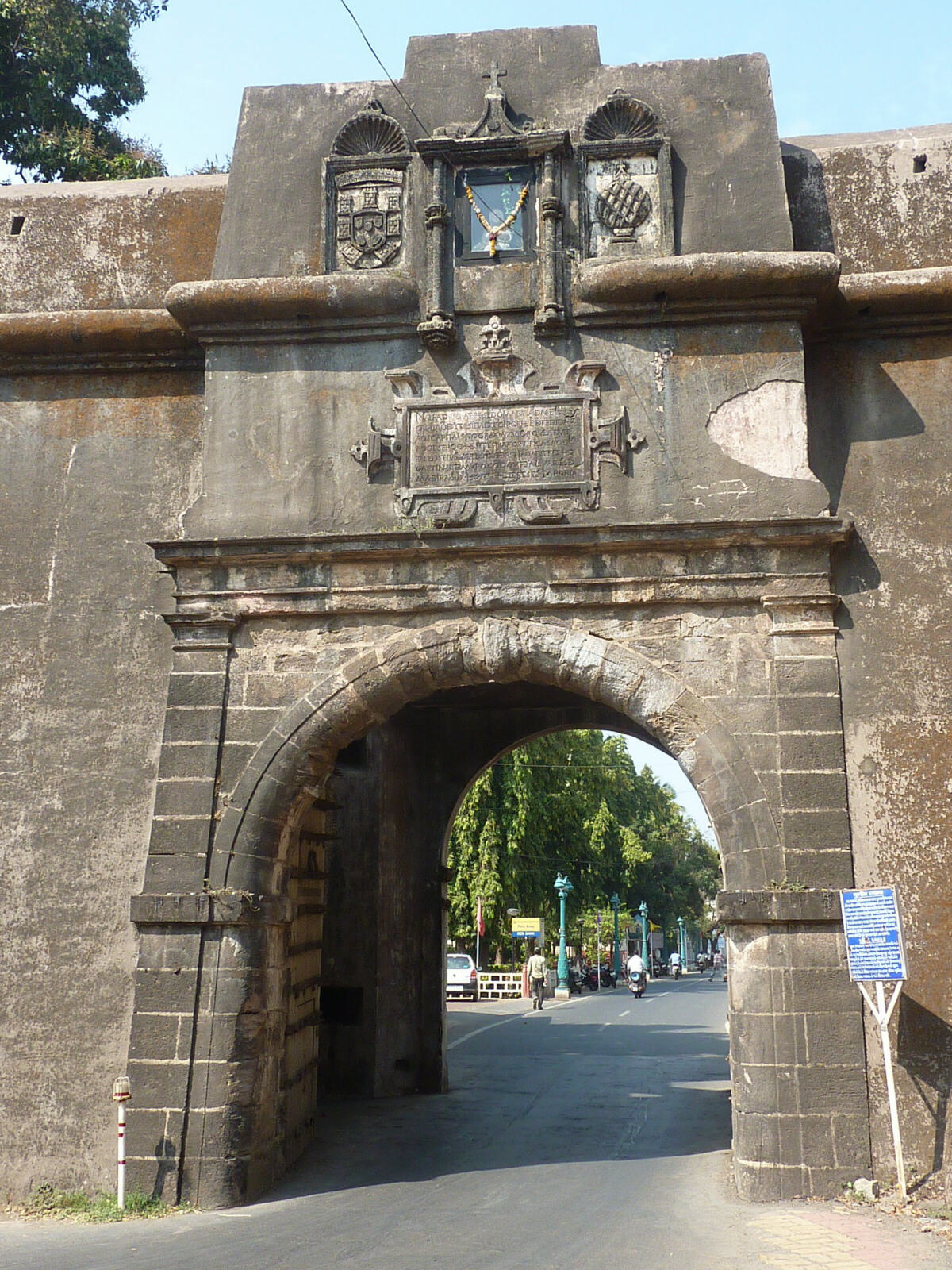
|
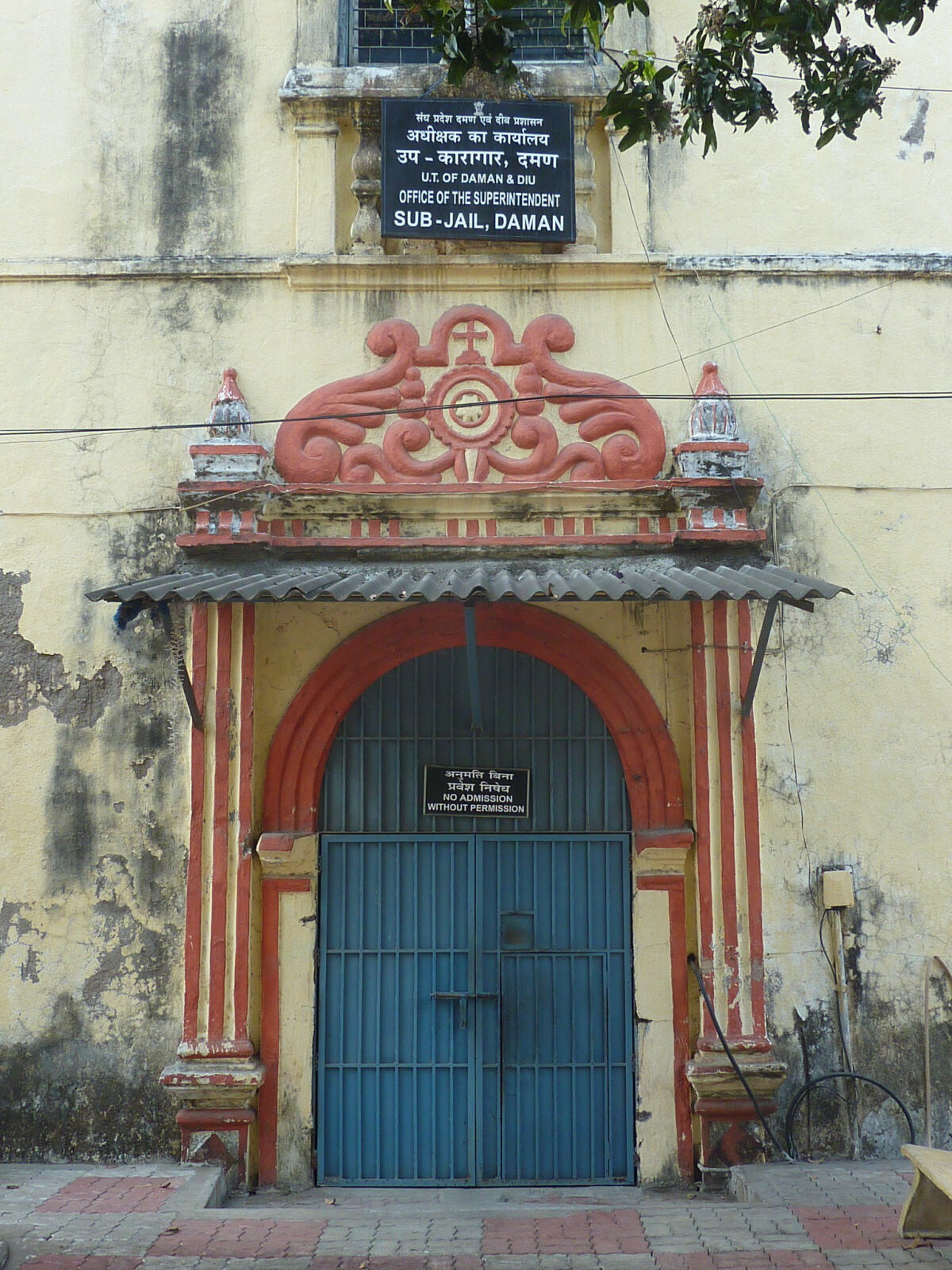
|
Udaipur, Rajasthan
|
Thurs 27th. We got a car with a crazy driver for the 3-hour drive back to Mumbai domestic airport – at one point Sheila had to tell him to calm down as he was trying to overtake lorries on the grass verge with horn blaring while two inches away from the car in front. At least it only cost 2,500 Rs this time. We had a nice flight to Udaipur and checked into the lovely room 212 with a lake view at Kankarwa Haveli on Lal Ghat by the lake. We went to meet Mr A, our friend and travel arranger from several previous visits to Udaipur, then walked round to the Ambrai restaurant for our favourite meal of butter chicken and charcoal-smoked chicken with significantly more expensive bottles of wine (20 pounds), at our favourite table 9 in the corner with the lake on two sides and sweeping views of all the glittering palaces and havelis. |
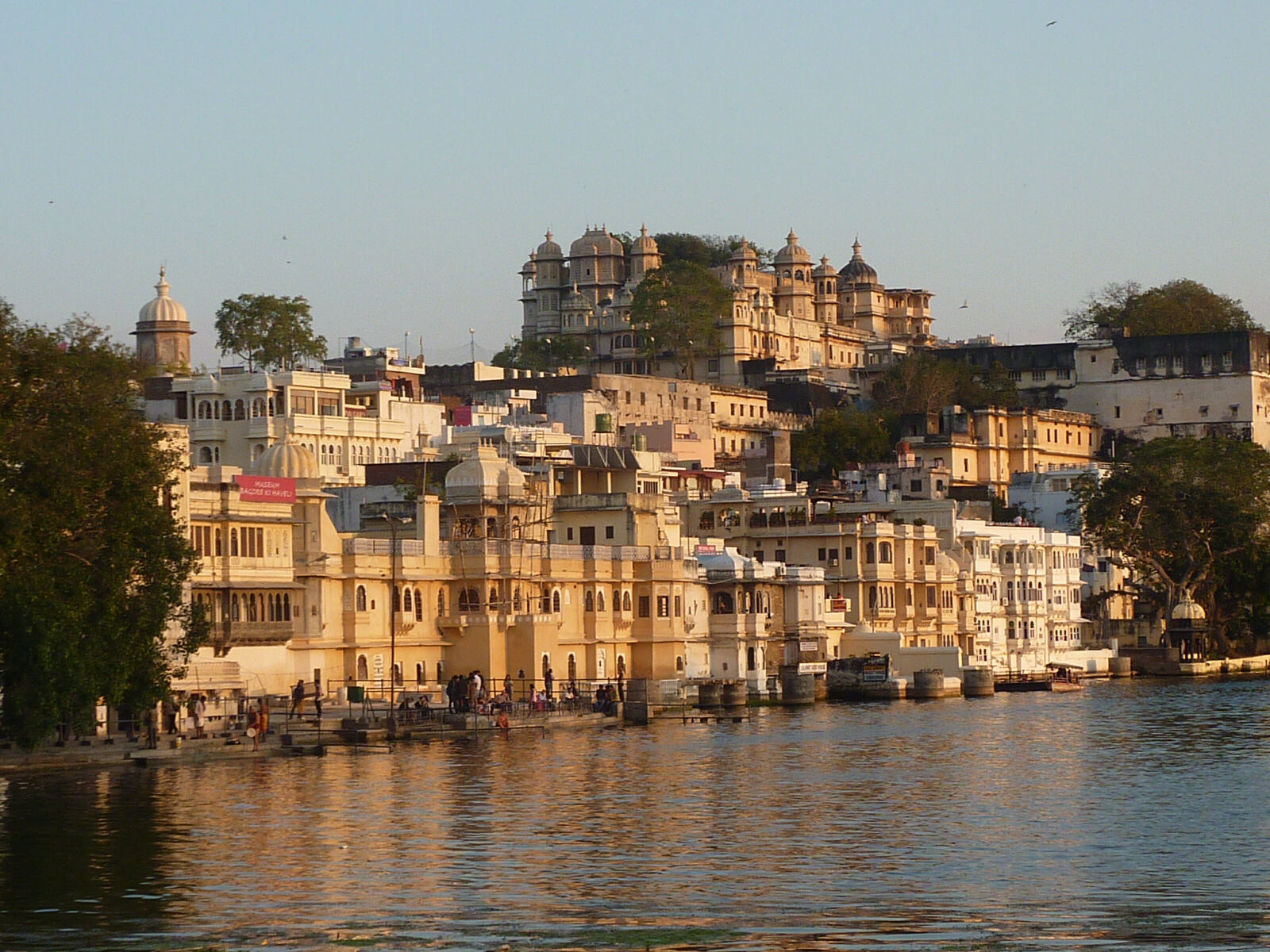
|
Fri 28th. We had a nice breakfast at Kankarwa Haveli, overlooking the lake in the morning sun, but an unattended breakfast on the next table was quickly spotted! |
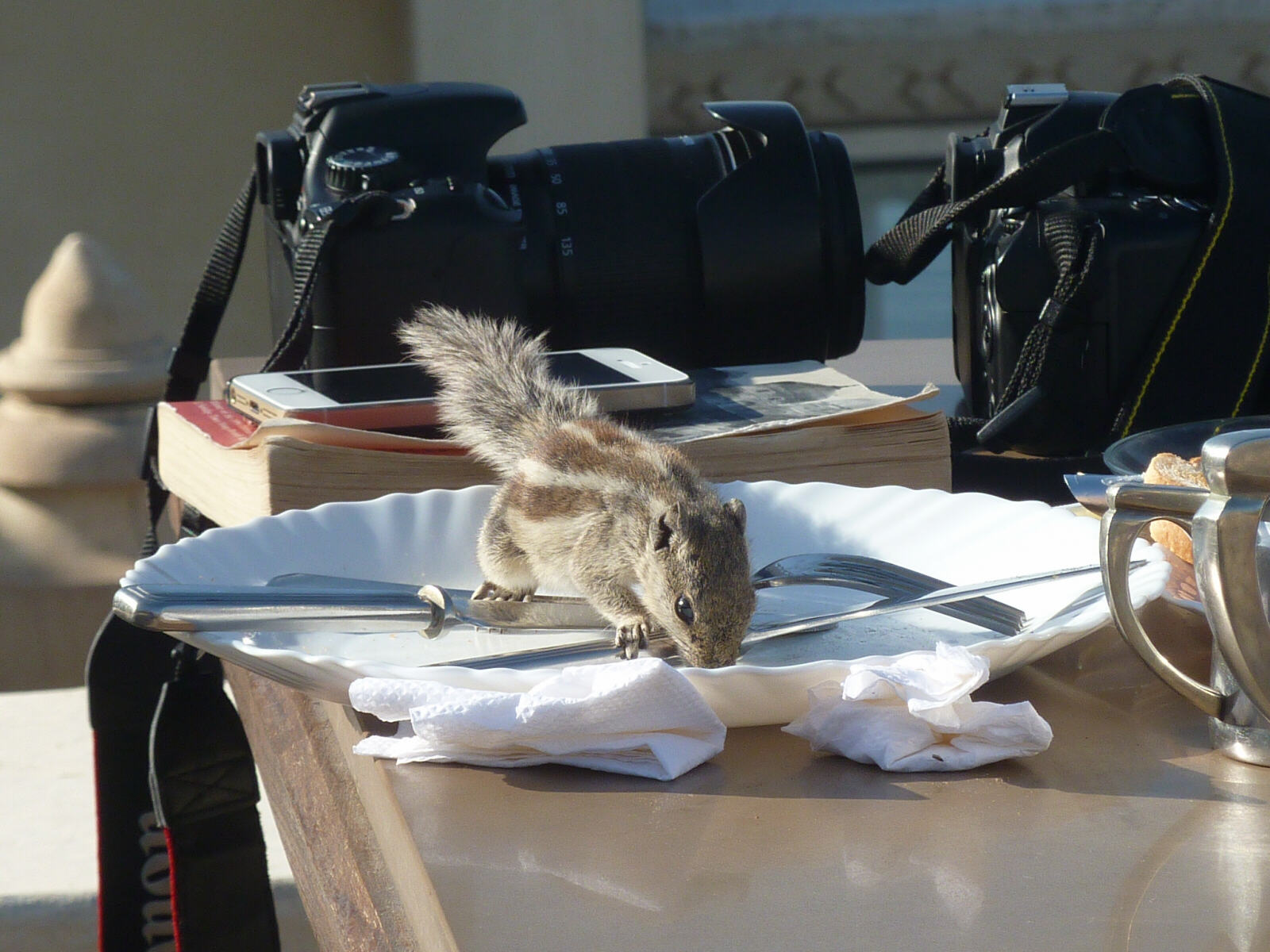
|
We walked down to the old clock tower and along what we’re now calling Menders Street, to get Sheila’s necklace mended at one little hole-in-the-wall shop, some earrings mended at another one and a couple of watches mended by the man who also fixes the clock tower clock. By the time we set off down Bara Bazaar it was lunch time so half-way along we stopped in our favourite little tea shop for samosas and chai (60 Rs altogether), sitting next to granddad while son and grandson (and possibly great-grandson) brought the chai to the table and topped up the samosa sauce. We think the samosas are always so tasty because the oil is passed down from generation to generation!
|
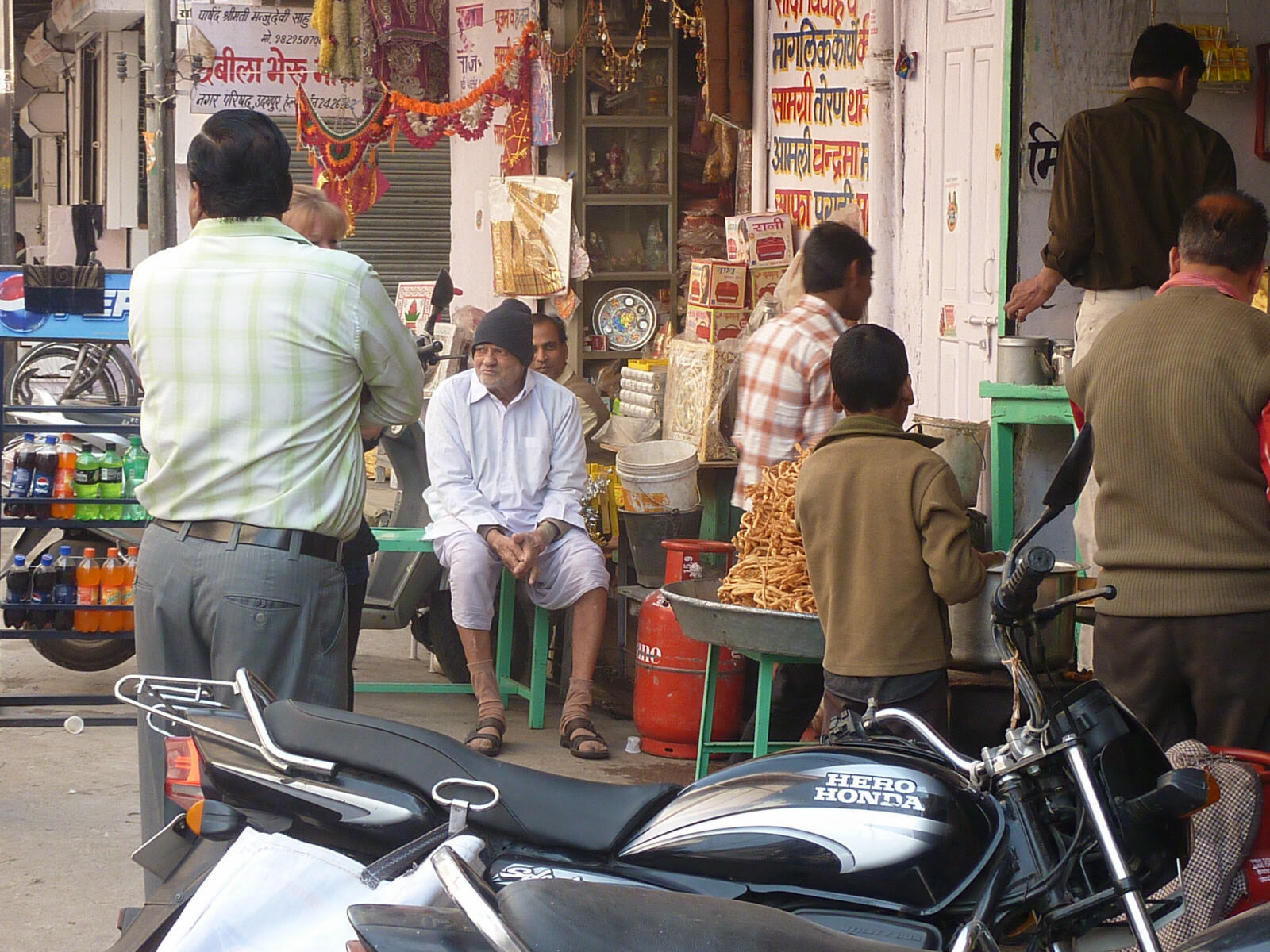
|
Along the way we saw a 'donkey train' carrying rubble through the streets, away from some building works.
|
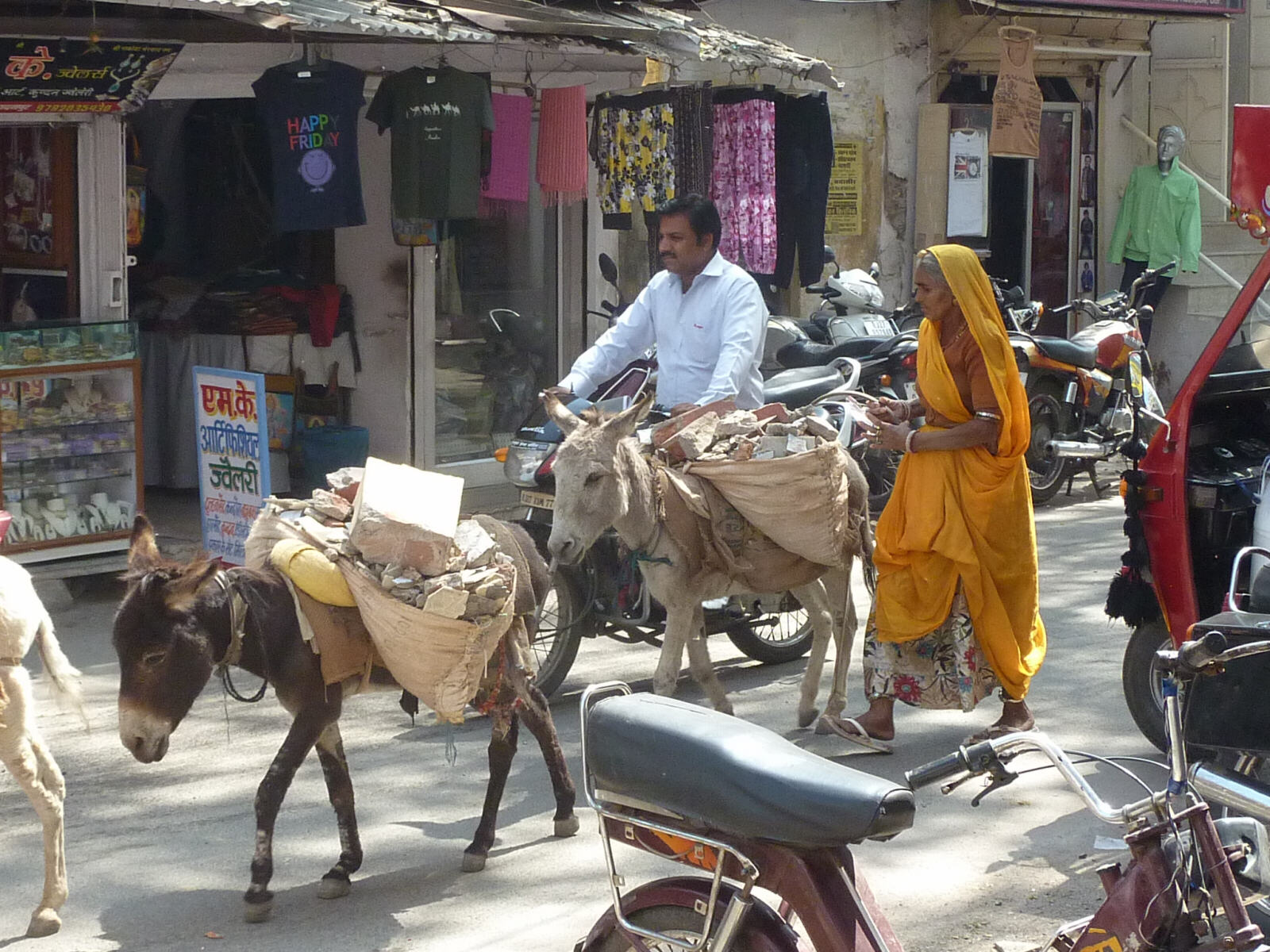
|
We continued down to the new clock tower and the fruit and veg market, then went past Delhi Gate and Court Circle to Chetak Circle in search of flower shops, but couldn’t find anything Sheila wanted although she really tried. An autorickshaw back to Lal Ghat cost 80 Rs which seemed about the right price for tourists. In the evening we had a very nice meal and more wine under the ‘canopy’ or turret in the Udai Kothi hotel restaurant although the service was terrible.
Sat 1st and Sun 2nd March. We moved into our best favourite room 219 right at the top of Kankarwa Haveli, with sweeping views of the lake, palaces and restaurants. |
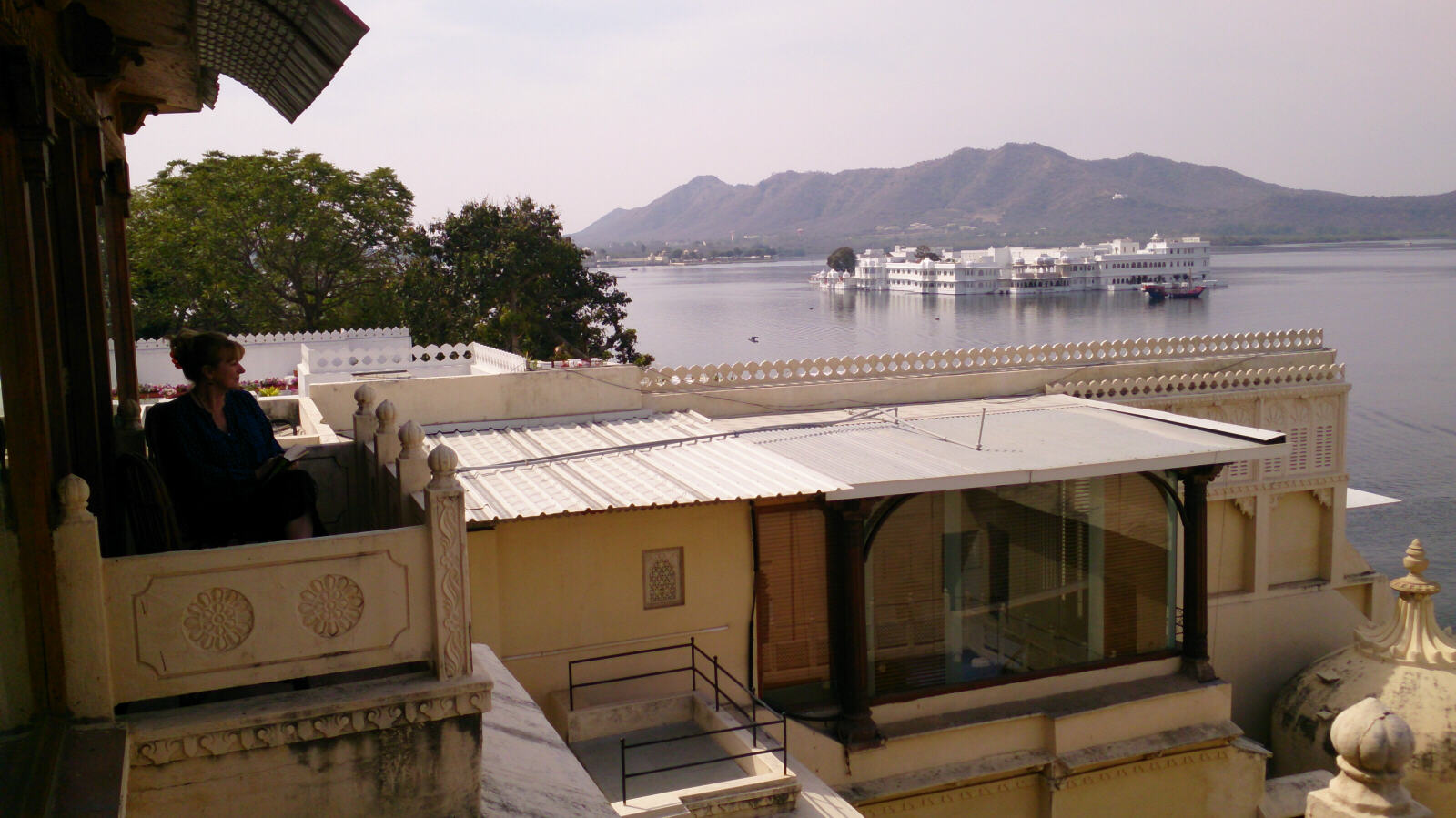
|
We had another walk round the markets to collect Sheila’s mended items, then over to the Natraj restaurant near the railway station for a Thali lunch. I had a walk to the botanical gardens, lunch of fresh peas and cucumber from the market with chat masala from a spice shop, and a coffee by the lake at Little Prince café. In the evenings we had a very tasty chicken lababdar and couple of glasses of wine at the Food Club, by the lake opposite the Udai Kothi, and another wonderful meal at the Ambrai, washed down with a bottle of Sula’s best Dindori shiraz.
Mon 3rd. We went for another walk around the fruit and veg markets which are so colourful and fascinating, and had samosas and chai at grandad’s tea stall, then got Mr. A’s car to the airport. |
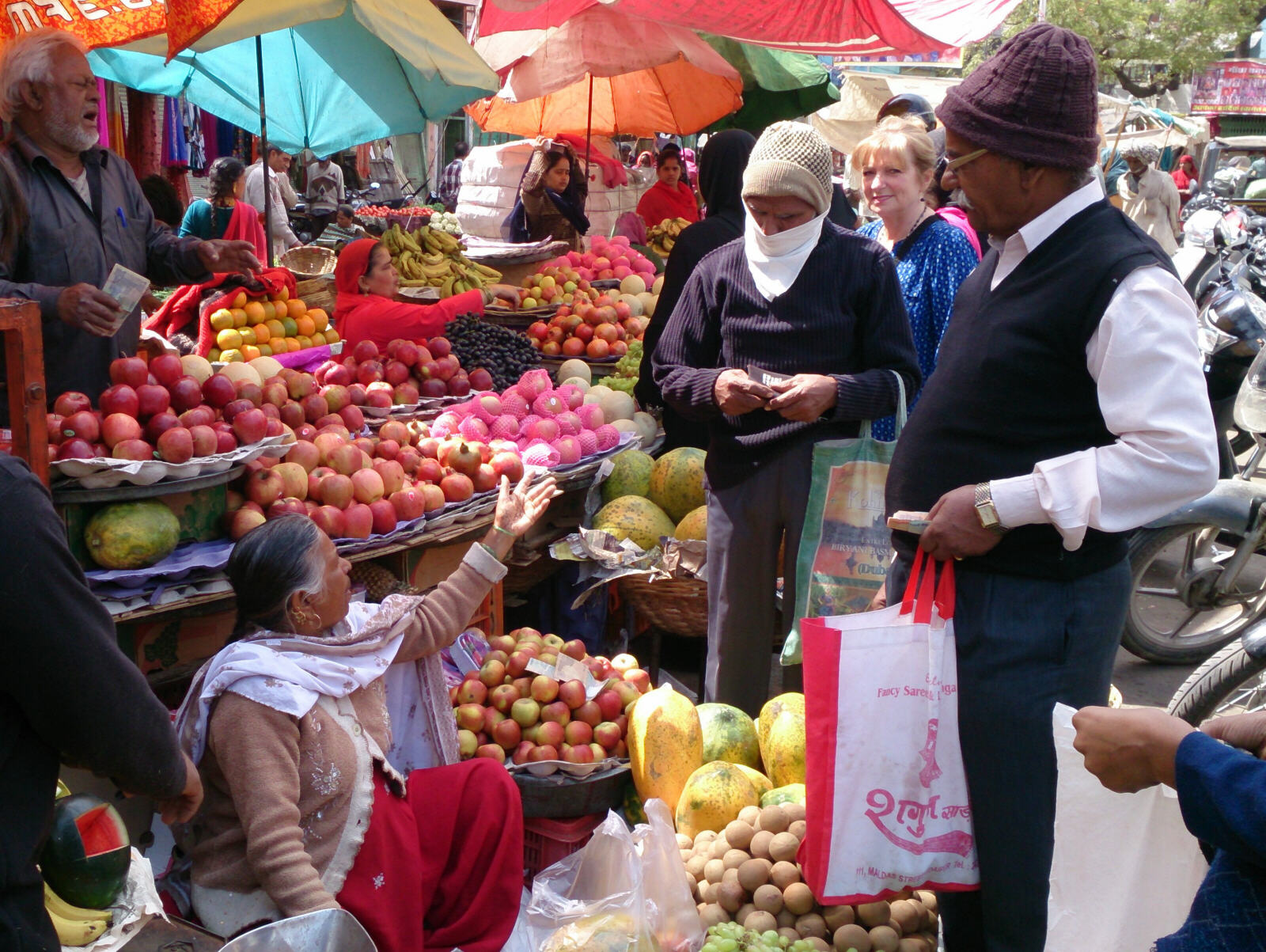
|
Delhi
|
We flew Jet Airways to Delhi and got the express metro to Shivaji Stadium (240 Rs for two) and an autorickshaw to Swati Hotel in Karol Bagh (150 Rs) – thanks to the metro the whole journey was less than half the price and probably twice as quick (judging by the traffic jams we saw from the train) as a taxi from the airport. The Swati is another favourite where we always stay in Delhi, then we went round the corner to Crossroads, our favourite restaurant where we always eat in Delhi, for a meal that was just as good as we remembered, with half a bottle of Sula cabinet shiraz for me and Sula sauvignon blanc for Sheila.
Tues 4th. We started our search for traces of the British Raj by doing the ‘Siege of Delhi 1857’ walk. First we got the metro via four changes to Pulbangash station (in this case a taxi probably would have been quicker) then walked up the hill onto the Ridge to the Mutiny Memorial, where the inscriptions to the fallen British soldiers are still in excellent condition. |
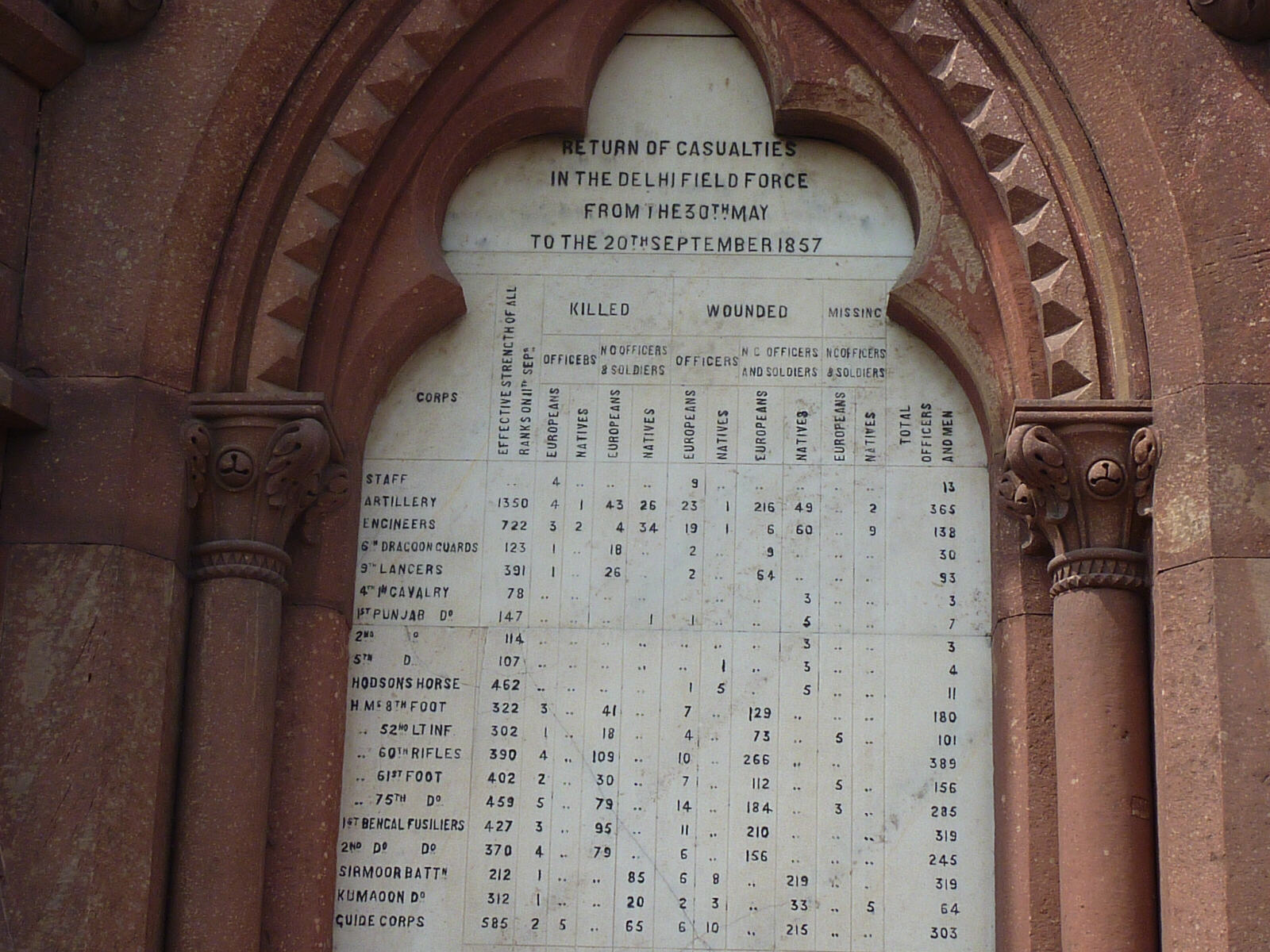
|
We carried on along Ridge Road past ‘Hindu Rao’, now a hospital, and explored an old palace nearby called Pir Ghaib, then along Magazine Road which is now closed to traffic and a blissfully tranquil park (except for the monkeys) as far as Flagstaff Tower, which is well-preserved but closed up. We then went down the hill and tried to find Ludlow Castle, formerly the Governor’s mansion, without success even though it was marked on the very detailed Eicher street map. Later we found out it had been demolished and a school built in its place. |
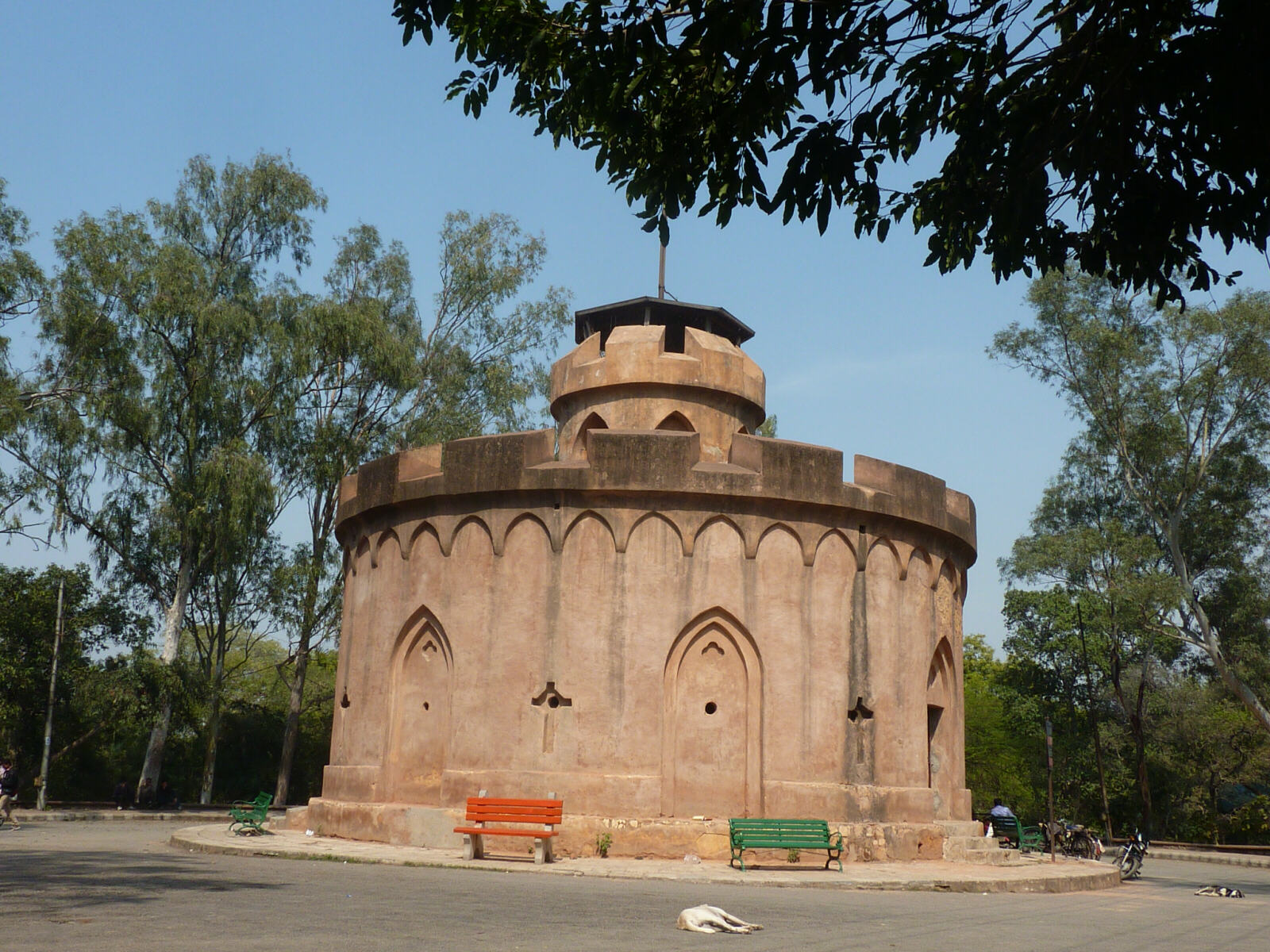
|
Weds 5th. Firstly we got the metro way out to Kulkaji in the suburbs and had our suitcase zip and handle mended by the same mender who fixed another zip last year. While we were waiting we visited the nearby Baha’i Lotus temple which was serenely spectacular. |

|
Then we negotiated with Santuk the autorickshaw driver, a really nice chap, that he would take us all the way back to Karol Bagh on the meter (it’s unheard of for a rickshaw driver to turn the meter on for a foreigner!), from which we deduced that the meter charges about 9 rupees (pence) per kilometer. After dropping the case we got the metro to Kashmir Gate and continued our Traces of the Raj walk, aided by William Dalrymple’s excellent book 'City of Djinns'. We walked down Lothian Road, once Delhi’s classy shopping street but now a rather run-down area strewn with rubbish and smelling of urine. Behind St James Church we found the former British Resident’s bungalow, now the office of the Chief of Northern Railways. The long, low bungalow was still recognizable but somewhat disfigured by a big new dome on top. |
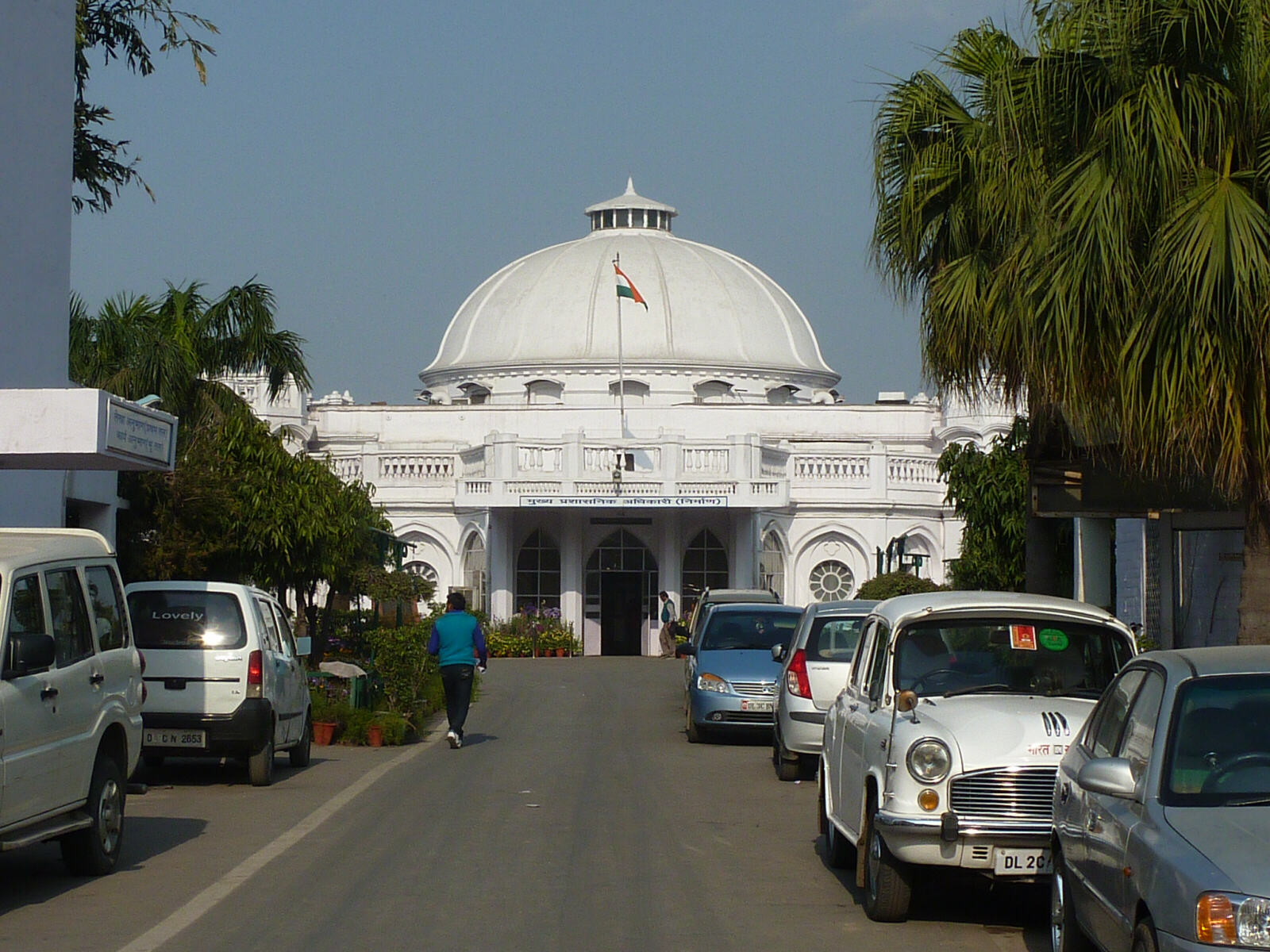
|
A bit further down the road we found the former British Residency inside the gardens of a college. Still an imposing building with Ionian columns in its façade and an elaborate Mughal doorway inside, it now contains a small, dusty archaeological museum. It was all locked up of course, but the guard kindly called someone who let us in. |
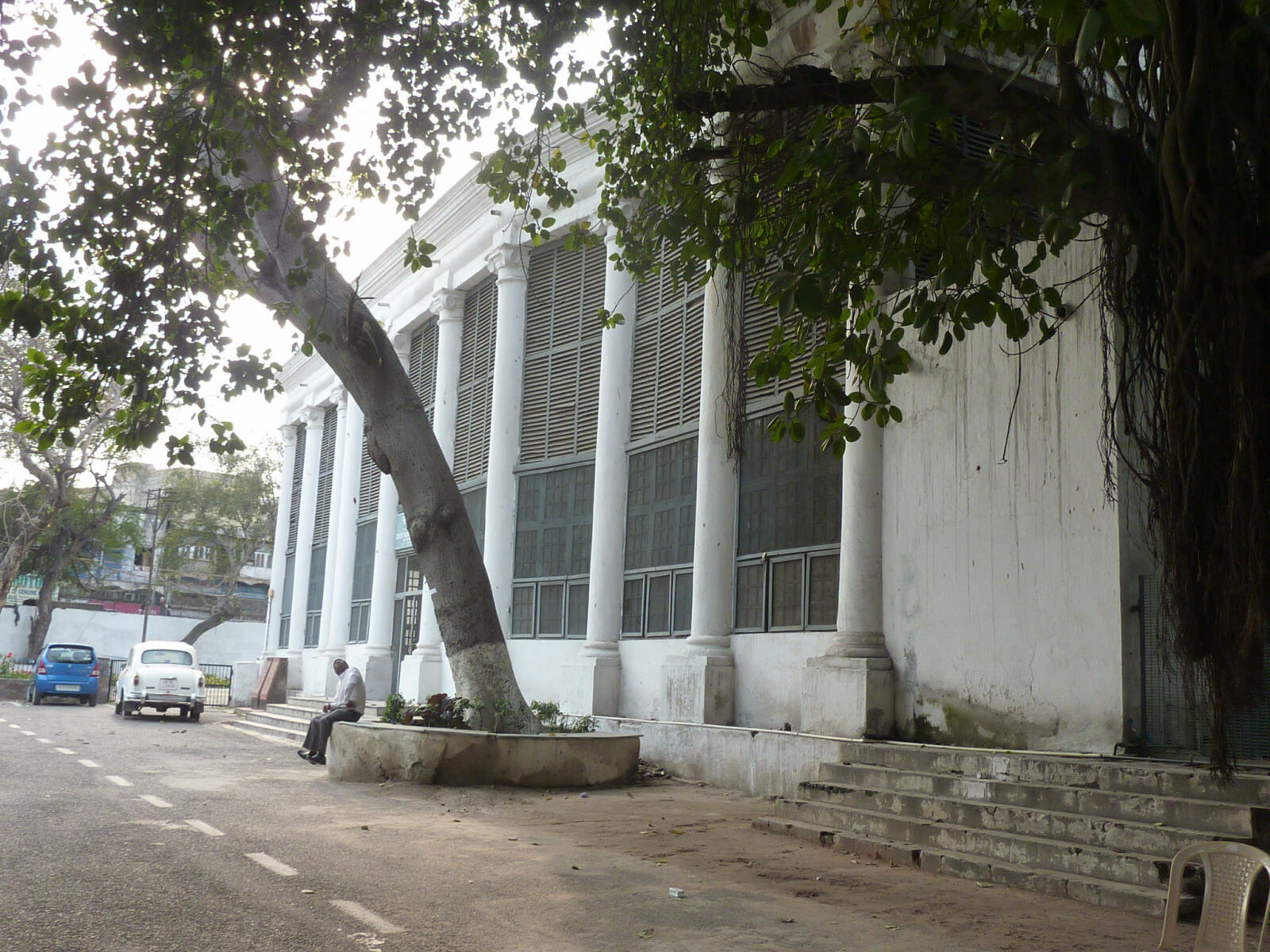
|
We failed to find the old British Cemetery because we were looking in the wrong place (we found it the next day), so we got an autorickshaw down the road to Chandni Chowk, the busy and bustling main bazaar of Old Delhi. Half way down Chandni Chowk we stopped at Sisganj Gurdwara, fairly plain outside but a beautiful Sikh temple inside. |
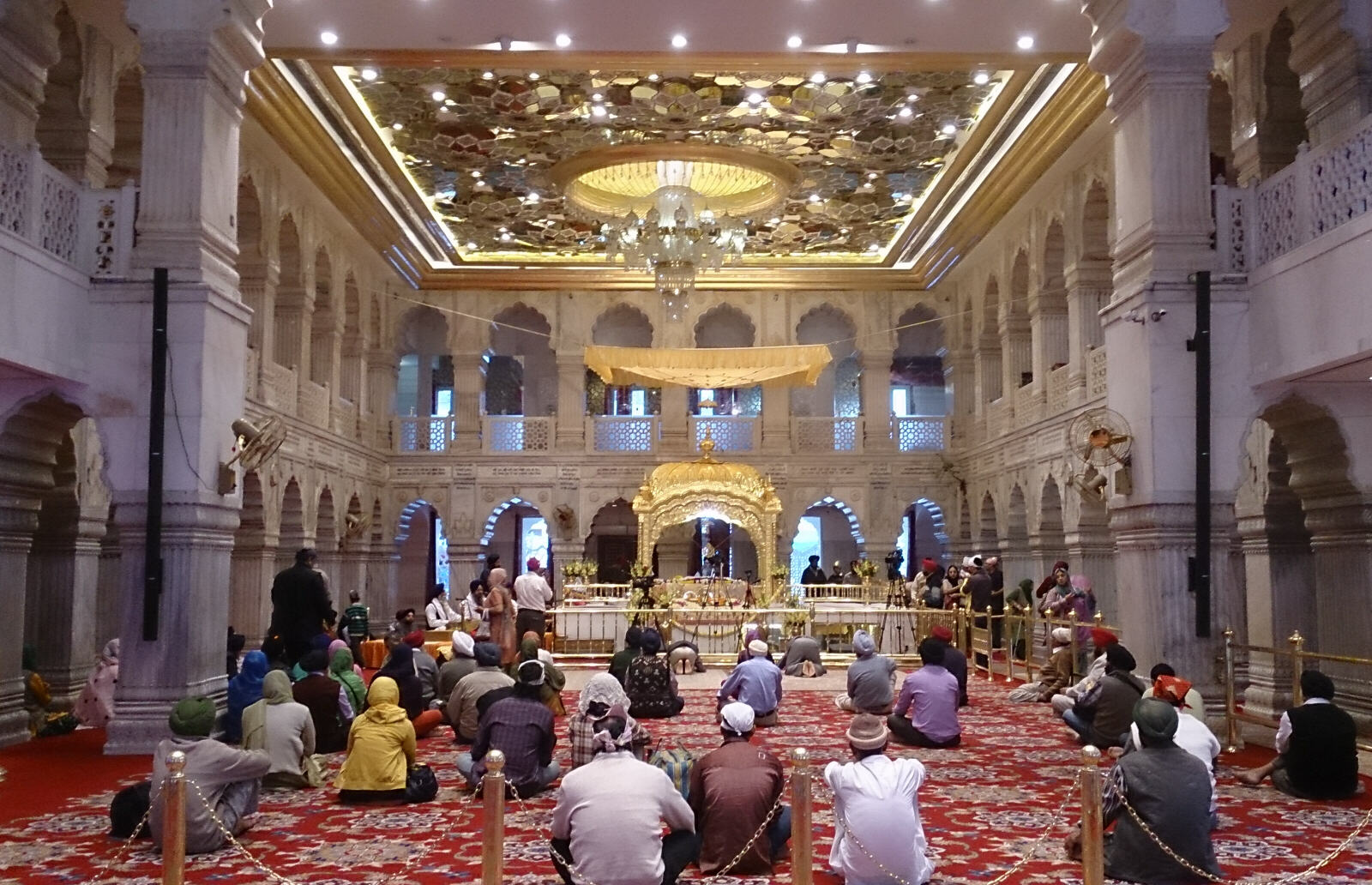
|
About three-quarters of the way down Chandni Chowk we turned left into a small road called Balli Maran, then some way down turned right into an alleyway called Gali Qasim Jan, where after walking right past it the first time we found the old house, now a little museum, of the renowned poet Mirza Ghalib. After a quick look round because it was just closing, we carried on down a succession of fascinating alleyways until we emerged near Ajmere Gate where we asked a cycle rickshaw man if he would take us to Karol Bagh. This was a mistake because he said yes and asked for 50 Rs, but set off in completely the wrong direction. We sent him in the right direction but then all got lost, until after a lot of asking directions and asking for more money, he abandoned us somewhere on the edge of Karol Bagh district, where an autorickshaw driver charged us an excessive 50 Rs to take us the last few blocks to the hotel. A strong, cold wind had blown up and we were covered in dust and grit, so we cleaned up a bit and went for another great meal at Crossroads.
Thurs 6th. We went to the amazing Akshardham Temple, a ‘modern wonder of the world’. After some pretty stringent security (including being frisked and handing in all cameras and mobile phones unfortunately) we wandered around the lovely gardens and elaborate sparkling temple resting on an impressive frieze of carved elephants. Eventually we left and got the metro back to Chandni Chowk and found our last ‘trace of the Raj’, the old British Cemetery a little way up the road, with lots of elaborate monuments and plaques from the first half of the 19th century. We got an autorickshaw to Pahar Ganj, the ‘travellers’ street’ and walked up and down a bit, before getting one of the silent, new electric autorickshaws back to the Swati Hotel.
Fri 7th. After a leisurely pack and breakfast next door at the Swati’s complimentary breakfast buffet, and a stroll to the metro station to get a refund on our tourist cards, we got an autorickshaw to Nizamuddin railway station. Unfortunately the rickshaw ran out of petrol after a few minutes and he had to flag down another rickshaw to take us the rest of the way. The second driver was pleasantly slow and knew all the shortcuts. He even used his mirror which is quite unusual because most rickshaw drivers just use them to watch themselves pick their teeth. We found our platform, the train arrived and we found our seats all without fuss, and had a pleasant two-hour ride to Mathura with a couple of teas from the on-board chai-sellers. |
Vrindavan, Uttar Pradesh state
|
The autorickshaw wallahs waiting on the station platform wanted 400 Rupees, on the pedestrian bridge 300 Rs, on the station concourse 200 Rs and in the car park we negotiated 150 Rs to drive the ten or so km to the Hare Krishna Orchid Resort in Vrindavan, which was very pleasant but a long way from the town. Also, because Vrindavan is a holy pilgrimage town it is pure-veg and alcohol-free, so we had lentils and chick-peas for dinner and an early night.
Sat 8th. We did our temple tour of Vrindavan. We got an autorickshaw to Ranganji temple, an interesting mixture of Mughal and South Indian styles with groups of pilgrims processing round each of the shrines. From there we walked through the streets of the old city to a samosa and chai house that looked like the black hole of Calcutta, in an interesting old building on a fascinating corner where we could watch the world go by. Along the way we passed nice doorways .... |
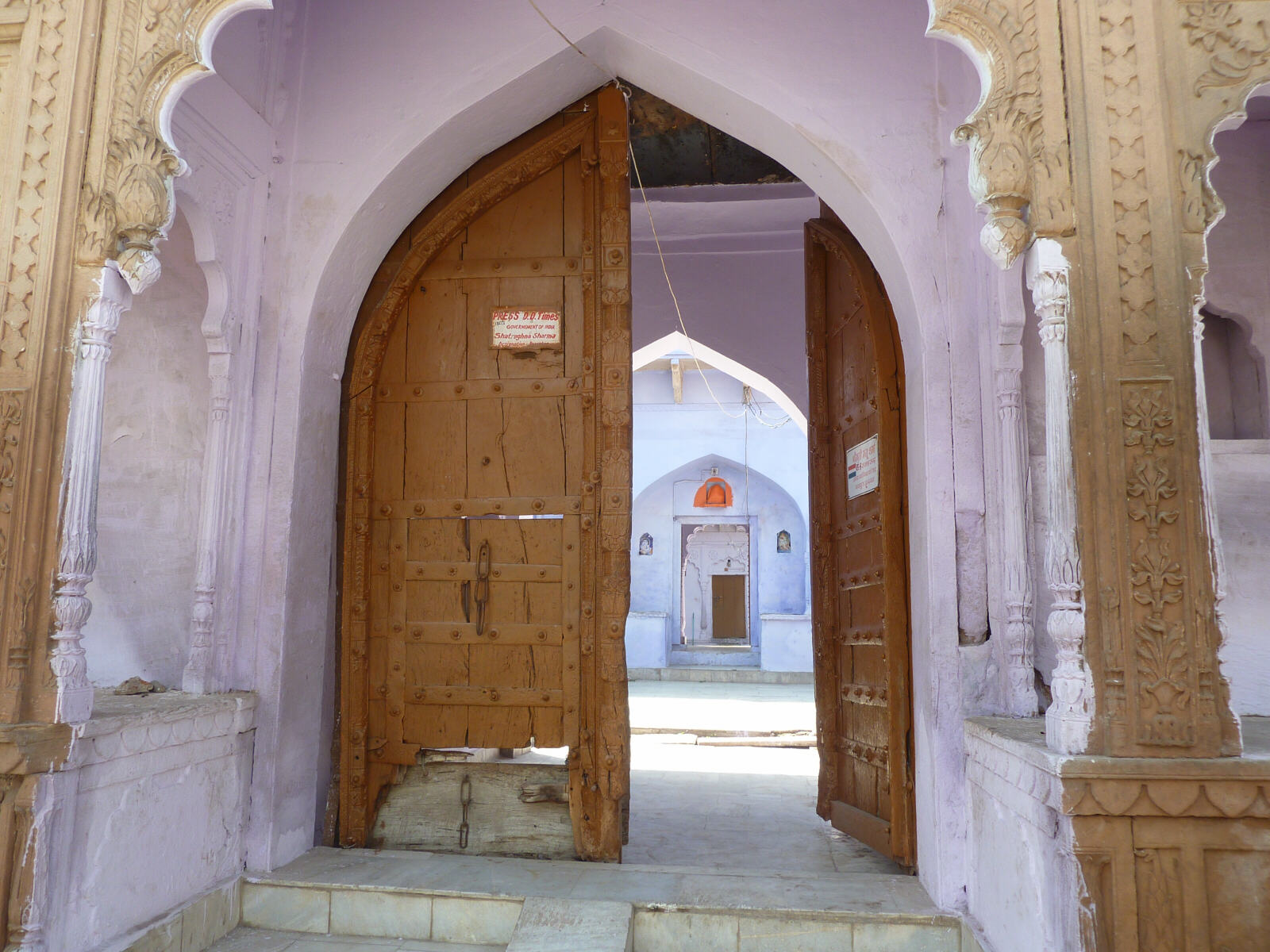
|
This town is the centre of the Hare Krishna movement and people seem to use ‘Hare Krishna’ as a greeting as you pass by, instead of ‘Namaste’ or ‘Good morning’. It was only a short walk from there to the bank of the Yamuna River where people were going on boat rides and we set a little floral offering with a candle afloat on the river, and a big monkey leapt on my back but didn’t steal anything. From there we got a cycle rickshaw but while we were stuck at one of the jams where the narrow street was clogged with rickshaws, cycles and shoppers, a monkey leapt out of nowhere and stole the glasses off my face. Sheila immediately leapt into action and chased the monkey and eventually had to pay a man 100 Rs to bribe the monkey with a juice drink to give them back. We had been warned that this was likely to happen and I had been holding on to them, but my concentration lapsed for a moment; luckily I was wearing my old pair, which was just as well as they came back all dirty and chewed. We went to Sri Bankey Bihari temple but it was closed and seething with monkeys and cows so we walked down a tiny street and by chance found the more picturesque red-brick Madan Mohan temple, up some steps overlooking the river. An autorickshaw from there back to the hotel, some way out of town, cost 150 Rs. Later I had a long, dusty walk to Prem Mandir which we revisited the next day.
Sun 9th. After breakfast we got an autorickshaw to ISKON, the International Society for Krishna Consciousness, otherwise known as the Hare Krishna temple. It was lovely, with picturesque buildings, shady courtyards and devotees chanting and playing musical instruments. |
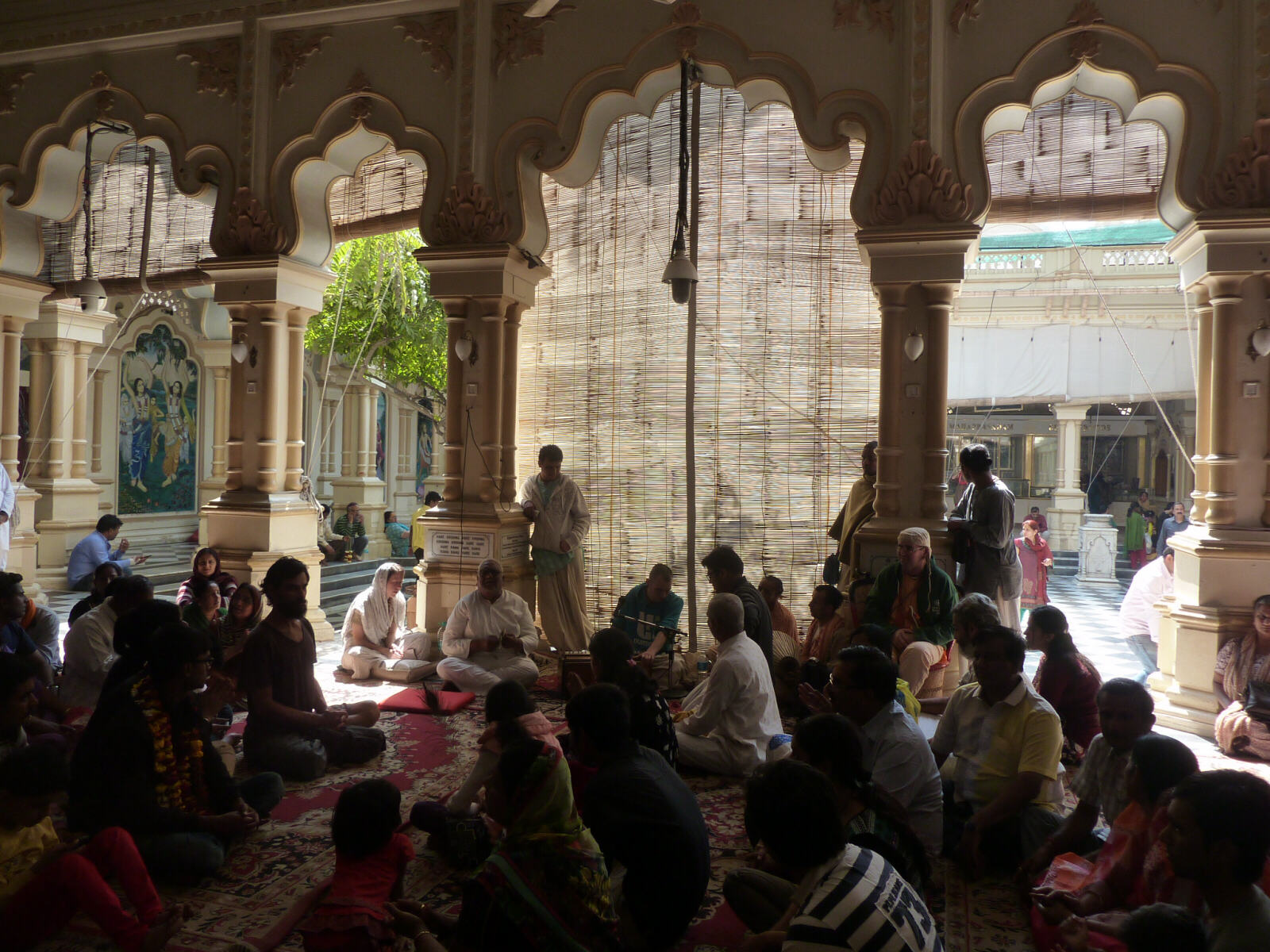
|
A short walk down the road we went to Prem Mandir, a very new, bright, white marble temple surrounded by well-kept gardens full of tableaux of animals, birds and people,
to see Krishna and his consort, and had to look around as quickly as possible before the whistle-blowing guards herded everybody out for the midday closure. |
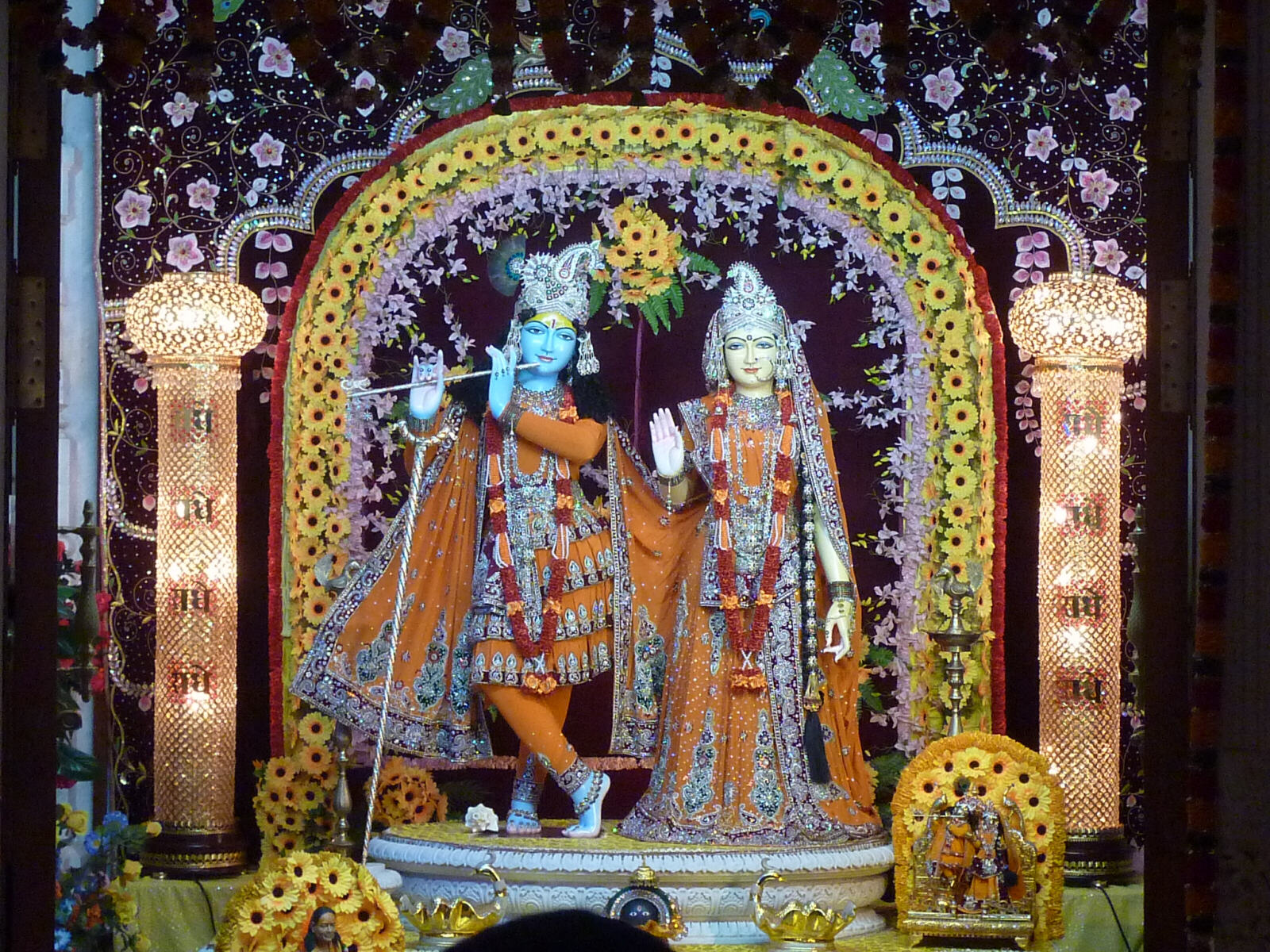
|
Gwalior, Madhya Pradesh state
|
In the afternoon we went to the station for the two-hour train journey to Gwalior, and went to Hotel Royal Inn. At first they couldn’t find any record of our booking and gave us a very ordinary room, but thanks to Sheila’s persistence things improved and they moved us to a very nice deluxe room with lots of space and a lounge area. The restaurant was closed so we went to the bar for dinner of Kingfisher light beers and a selection of very tasty spicy snacks.
Mon 10th. We went and visited the spectacular Gwalior Fort which occupies the whole of a 3-km long hilltop. The autorickshaw dropped us at the Urval Gate on the west side and we walked up the hill past huge rock-cut Jain sculptures in the cliff face. Once on top the fort is quite flat and we walked to Man Singh palace, a riot of turrets and mosaics on the outside but rather plain inside. |
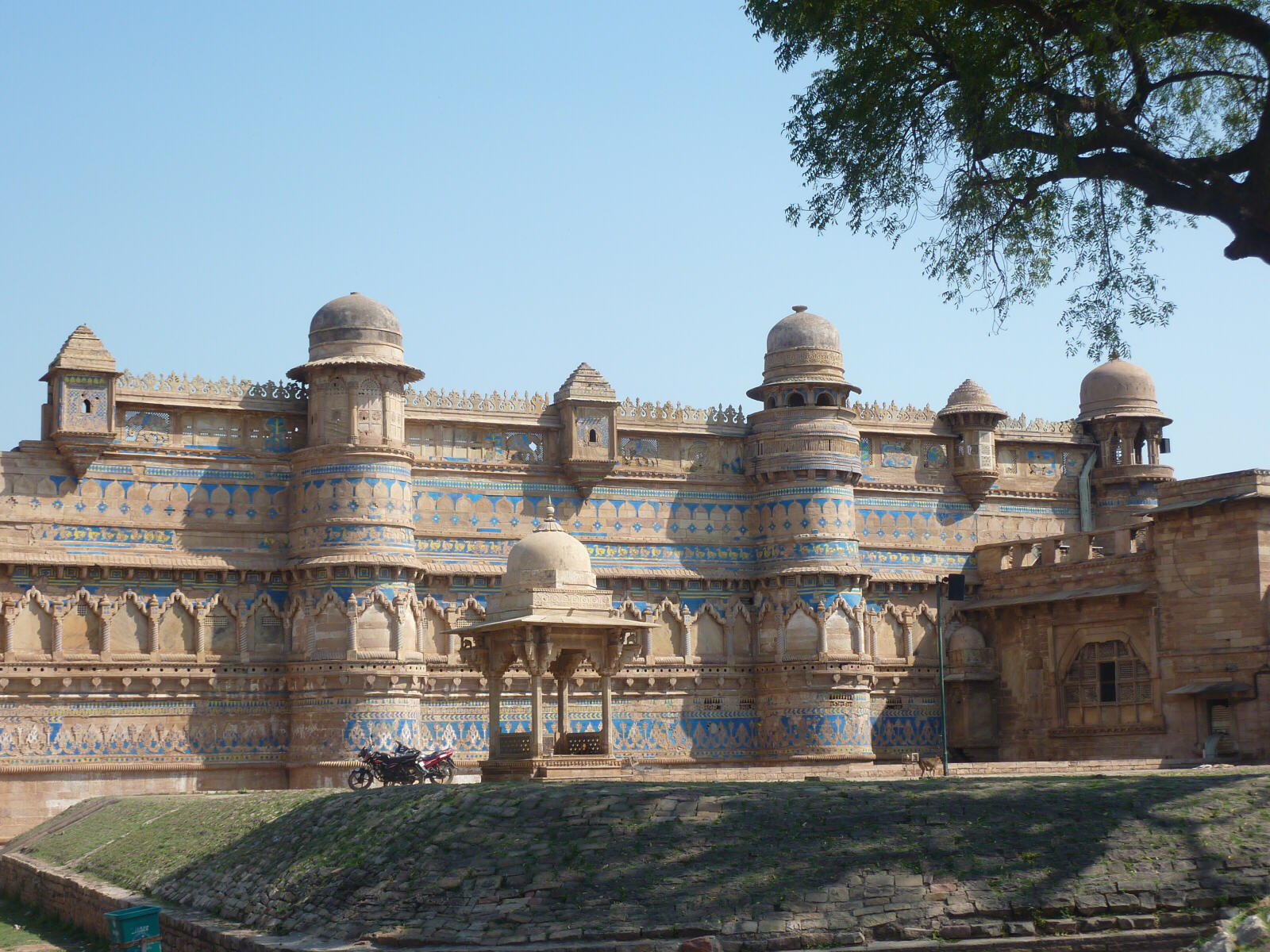
|
We walked along the battlements to Mother-in-law and Daughter-in-law temples, two pretty, highly-carved, almost circular temples on the fort wall, then backtracked round to the dazzlingly white Sikh Gurudwara (temple), approached along an avenue of majestic palm trees, looking more like Monte Carlo than Madhya Pradesh. Lorry-loads of friendly Sikhs arrived to worship at the temple. |
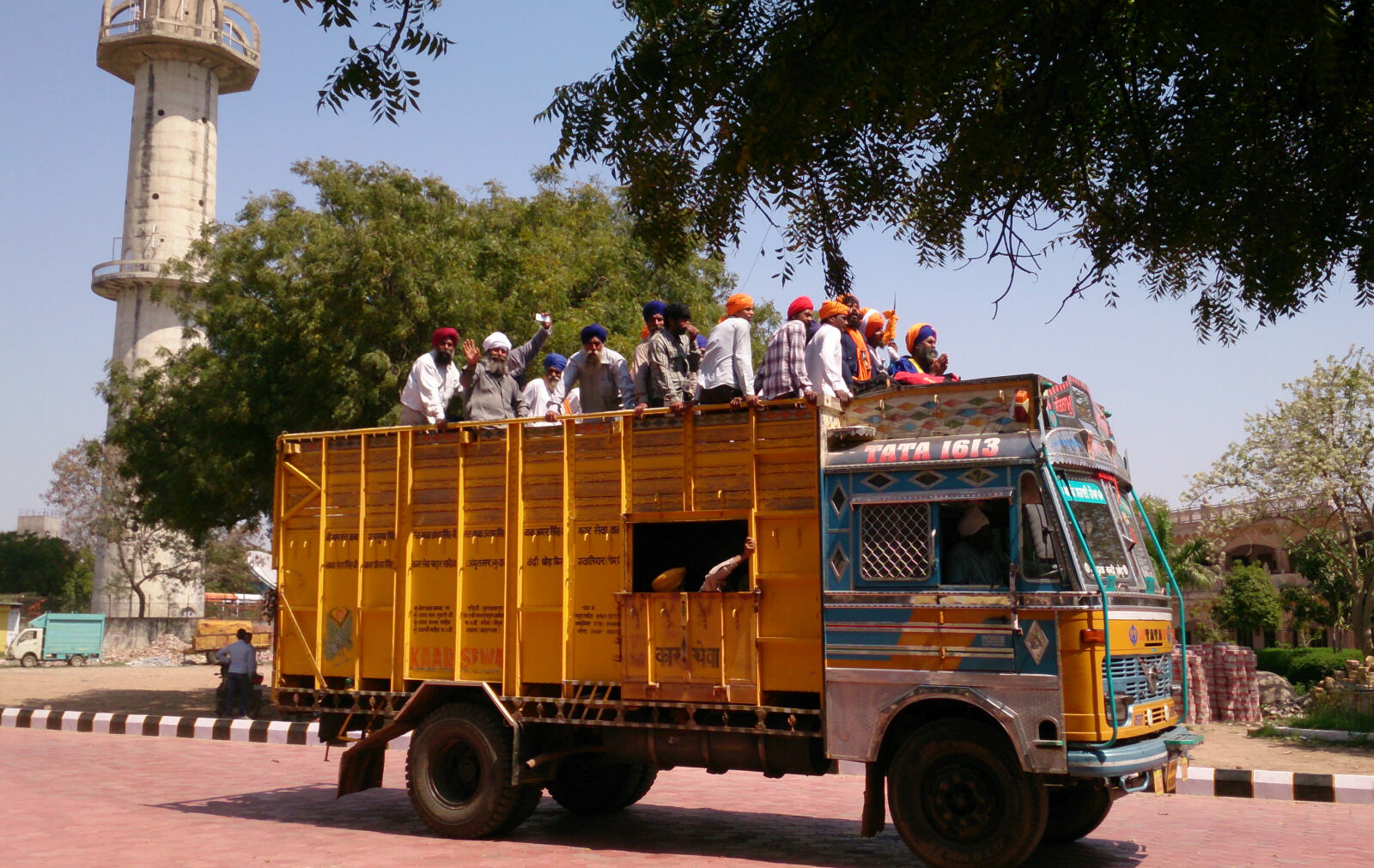
|
Finally we backtracked yet again round to the very old Teli Ki Mandir (temple), with elaborate carvings all over the outside and an unusual south-Indian barrel roof, but smelling like a toilet inside. We returned towards the palace, stopping for a refreshing drink at the Government café, and left the fort by the west Gwalior Gate and a steep walk down to the old town where we eventually found a rickshaw driver who knew where our hotel was. Later we tried to go to the spectacular Jai Vilas Palace, still the home of the local maharajah and his family, but it was closed to the public on Mondays. |
Orchha, Madhya Pradesh
|
Tues 11th. We got the midday train to Jhansi and found ourselves in the middle of a coach full of two large French and Japanese tourist groups. When the train arrived in Jhansi everyone waited while a tropical downpour took place, then 15 minutes later when the sun came out everyone poured out of the station - the tourist groups to their waiting coaches to dash to Orchha for lunch before driving on to Kajuraho, while we went at a more leisurely pace on an autorickshaw for the 18 km to Orchha. There we went and got a room in a palace, the Sheesh Mahal Hotel. We were tempted by the Maharaja Suite for 50 pounds but it was only available for one night so we settled for a ‘normal’ room for 22 pounds, which was very nice with heavy wooden chairs, table and wardrobe and fancy drapes around the windows which looked out over the jungle that surrounds the little town. |
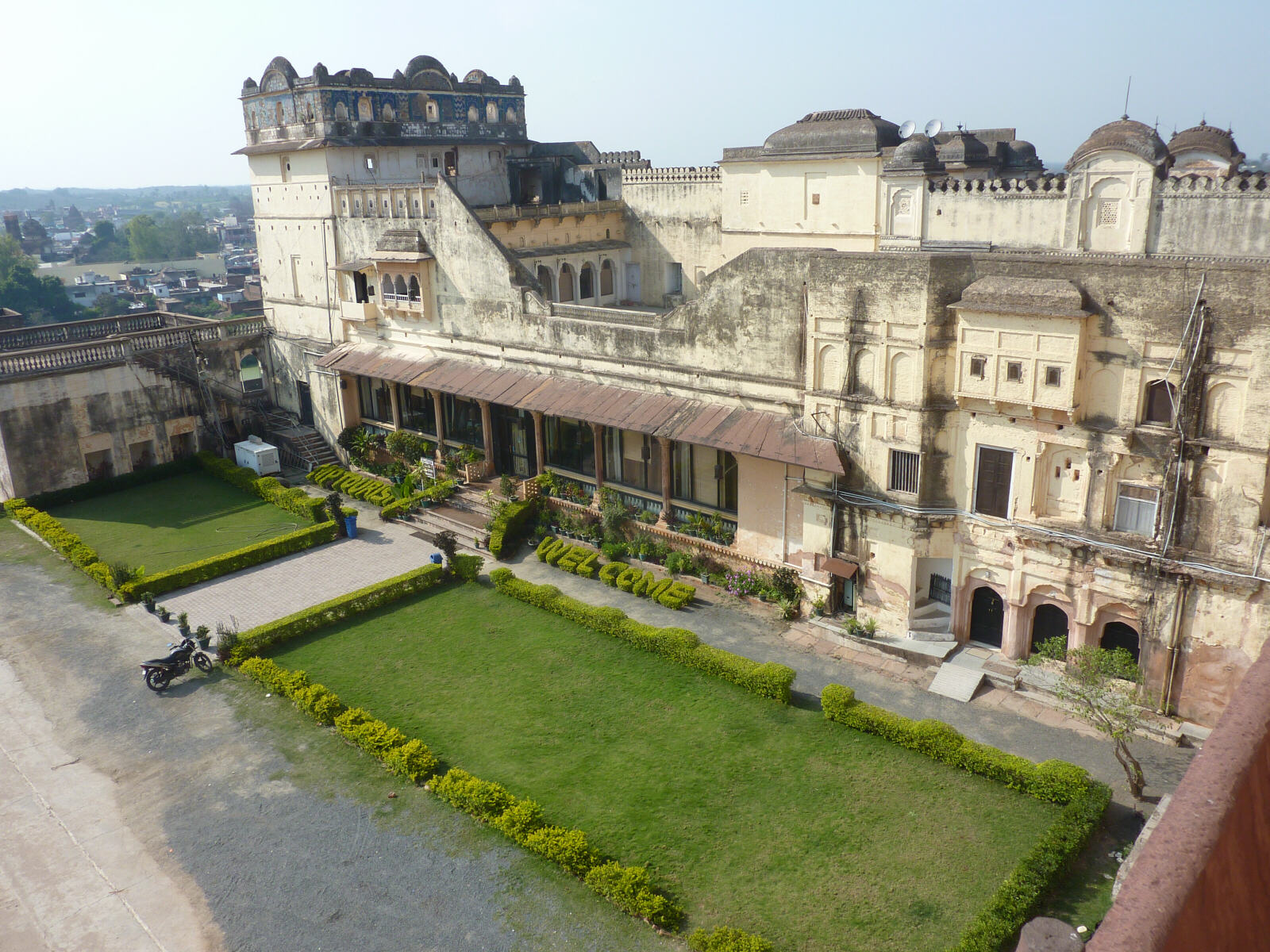
|
Orchha is very compact and we walked down the palace steps, through the arched gateways, across the stone bridge over the river and along the street with shops, internet cafes and rooftop restaurants. |
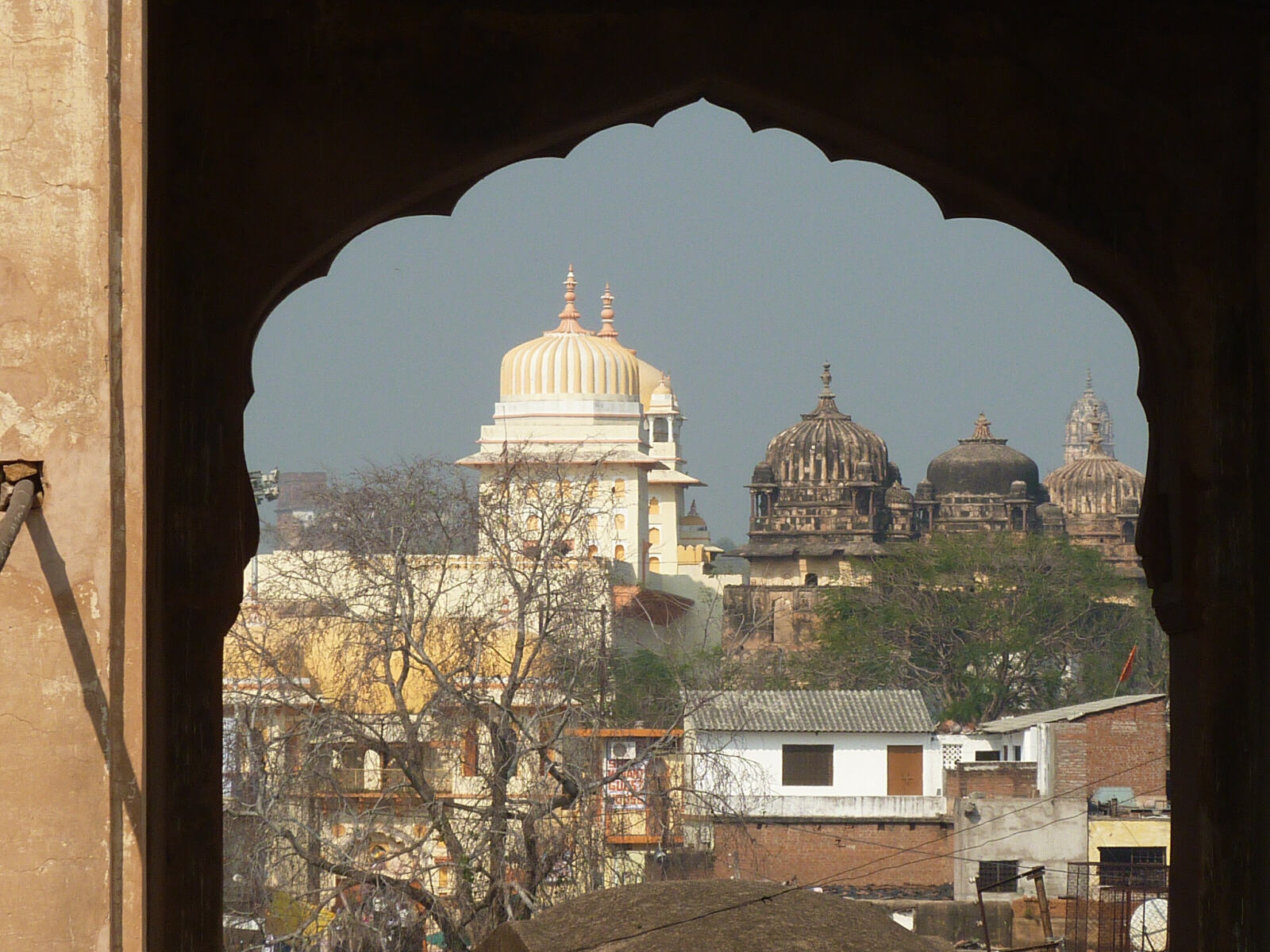
|
The Grey Langur monkeys here are much less threatening than the Rhesus Macaques in Vrindavan. |
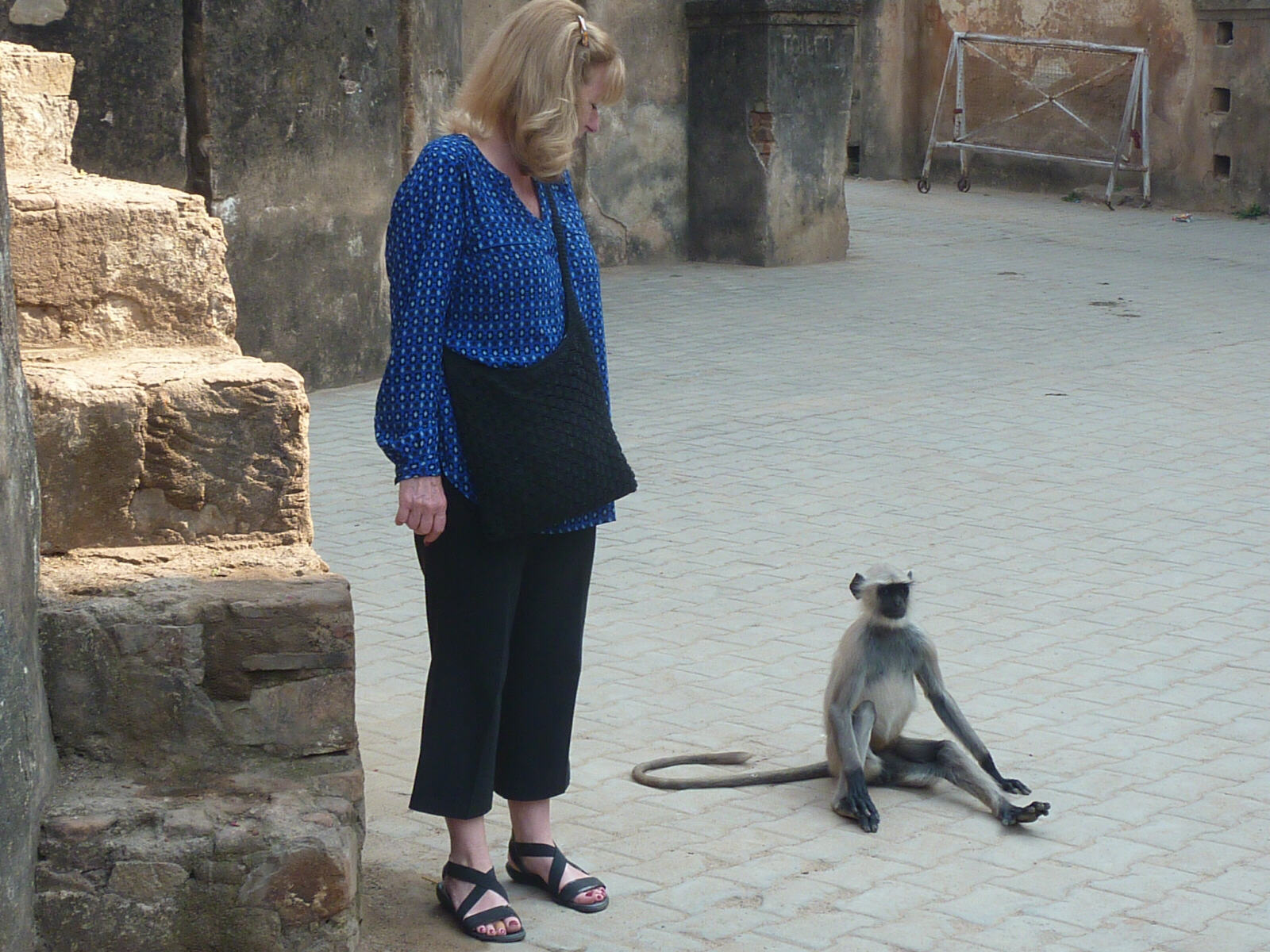
|
We had a drink and snack in one of the rooftop restaurants, then walked out to the Amar Mahal hotel at the far end of town. We had considered staying there but were glad we didn’t – it has a nice modern building around gardens and courtyards but it was a long way from town, twice the price and completely empty because no tour groups were staying today. We walked back and had dinner with tiny glasses of wine (4 pounds each) in the grand dining room of our palace/hotel, accompanied by a traditional music show with a dancing lady. We set out down the palace steps, etc. and went to the main Ram Raja temple, which was a fascinating hubbub of activity with pilgrims sitting, cooking and sleeping all over the square in front of the temple and bands of devotees perambulating round the temple playing drums and horns. We joined the queues (male and female) to go through the temple itself and were pushed and crushed by increasingly frenzied devotees, anxious to get a glimpse of their gods. When we finally got to the front it was mayhem as everyone pressed forward, handed over their offerings to the ‘priests’ who scattered a bit of holy water over the passing crowd, had a quick glimpse of Rama and his consorts colourfully dressed and brightly lit in a room way to the back, then were hustled on by the guards who were trying to control the crowds, who seemed always to be on the edge of rioting. It was amazing. |
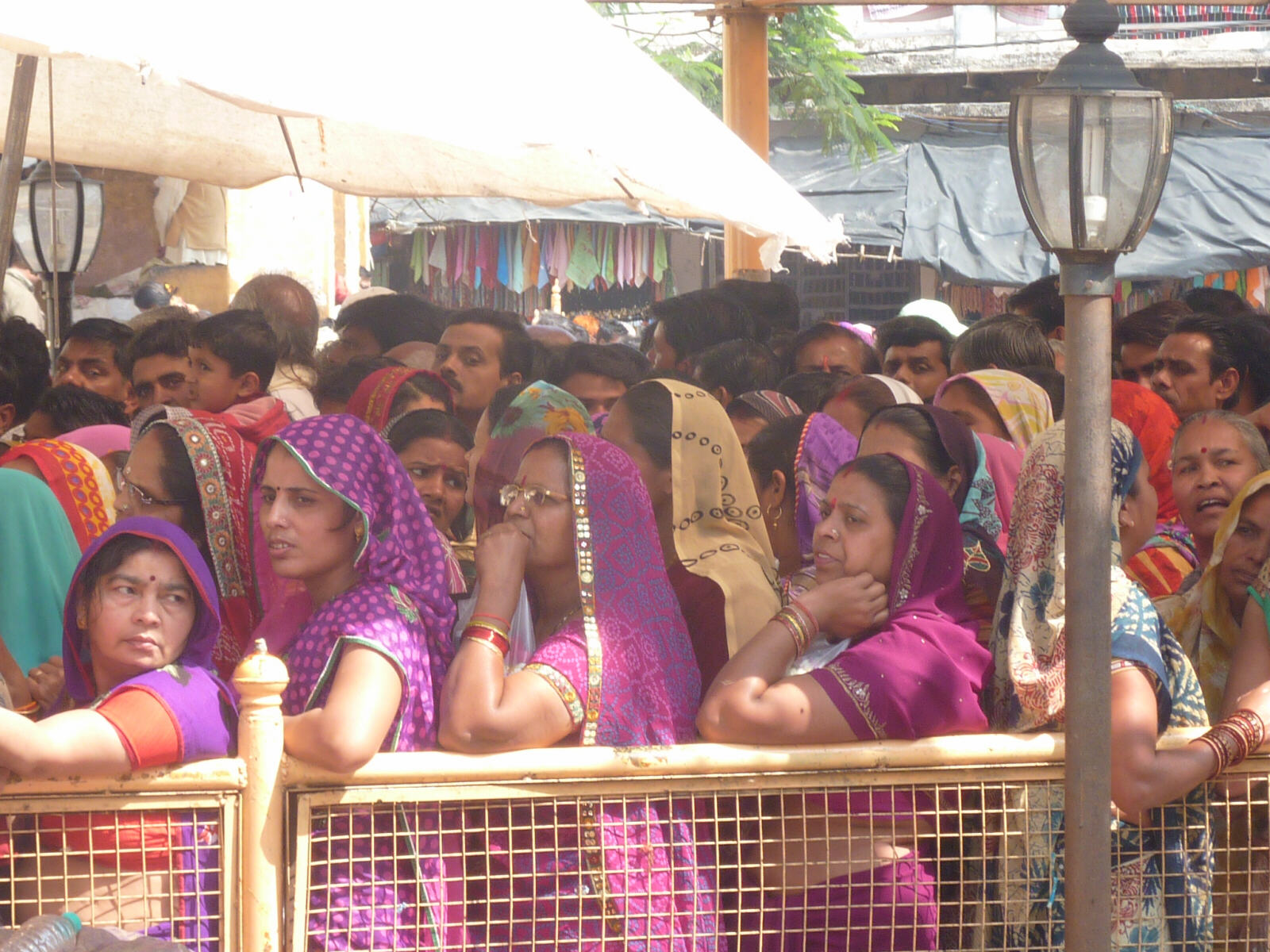
|
In the square outside the temple we strolled around in the throng of pilgrims, holy men, beggars and dancing ‘ladies’ (who Sheila informed me were actually gentlemen). |
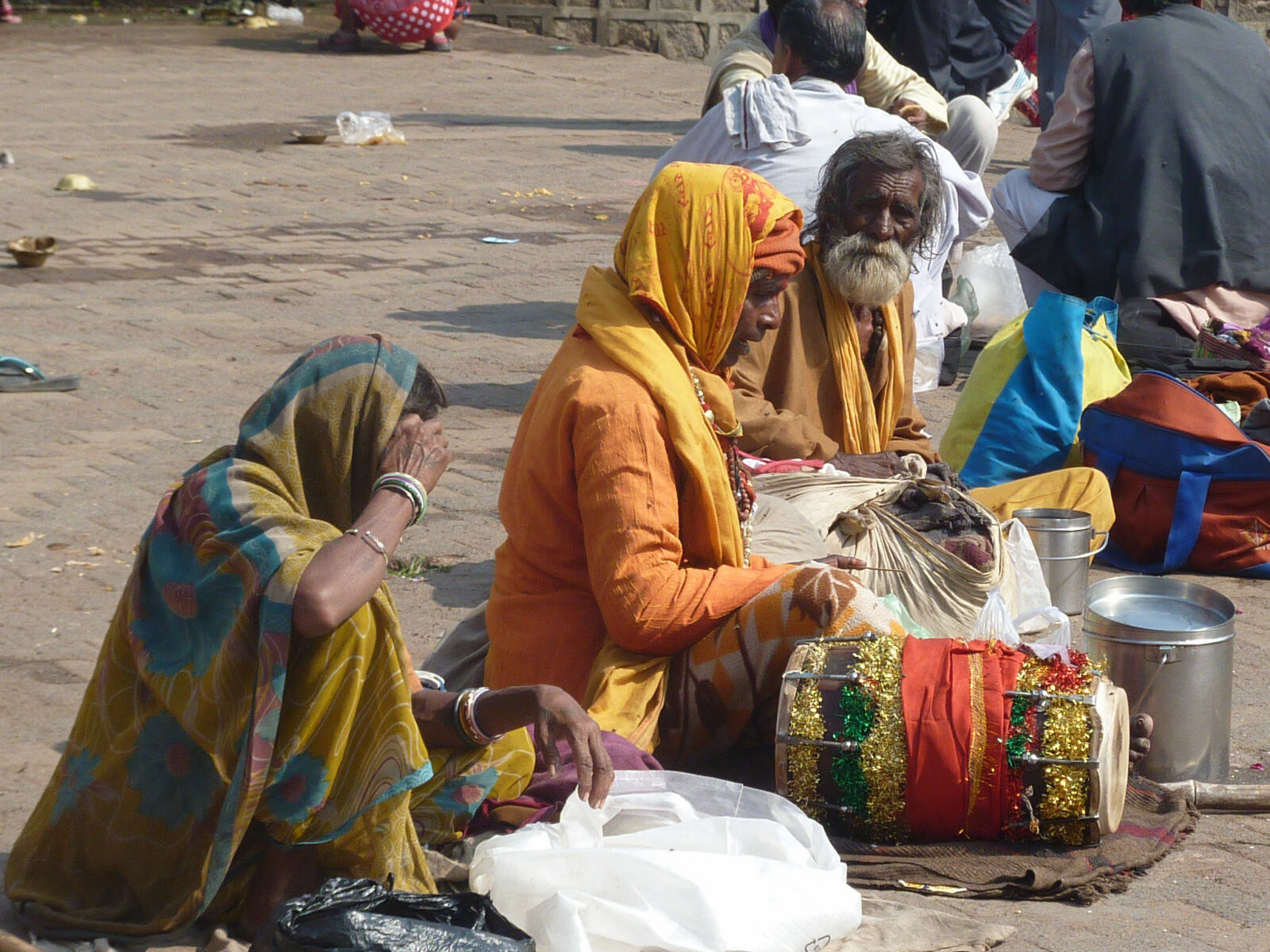
|
As we walked back up the steps and through the courtyard to ‘our’ palace we realized that we were part of the sound and light show, with lights playing on the walls to one side of us and the audience sitting on plastic chairs on the other side. That seemed like the end of a very interesting day, but we woke up about 4am to hear loud music coming from the temple and what sounded like a festival or street party going on. We got dressed and went back down the palace steps, etc. etc. and through the shopping street, deserted except for a cluster of rickshaw drivers, and into temple square, but it was not what we expected. It looked like a battlefield with pilgrims asleep under blankets lying all over the square and the only people awake were a chai-maker and two separate ‘DJs’ playing what was presumably religious music at fantastic volume – to us it was almost painful but Indians seem to be able to switch their hearing sense on and off at will and the pilgrims slept soundly. We strolled back to our palace shaking our heads in bewilderment.
Weds 12th. We had a walk to temple square and it was just as busy, bustling and fascinating as yesterday. The queues to get into the temple were long and frenzied and the police had to beat people back with sticks as they surged forward, pushing and trampling each other. We walked up to the nearby Chaturbhuj temple, a huge rather empty stone edifice with great views over the town and palaces. We walked back over the bridge to the island of palaces and went to Raj Mahal (palace) which was a maze of staircases up to multiple levels of balconies and walkways around two central courtyards, and rooms with well-preserved frescoes. |
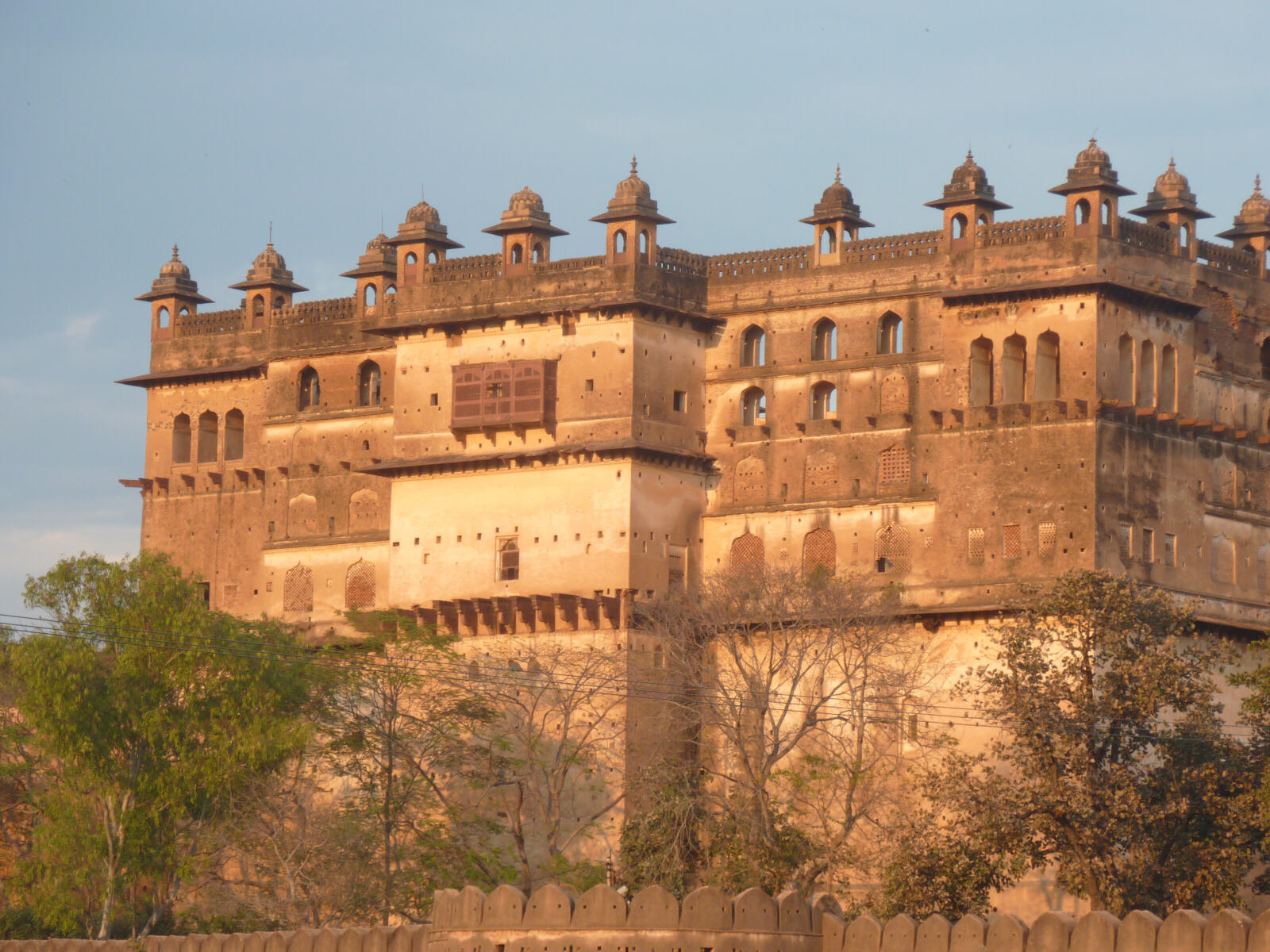
|
In the afternoon we did the rest of the palace tour on the island, starting with Jehangir Mahal, another huge edifice with steep stairs, precipitous walkways and fabulous views. With a bit of imagination you can see how it must have been in its heyday, covered in tiles, paintings, carpets and furniture. After negotiating the maze of stairways we found our way out and walked around to the back of the building where we found an elaborately decorated gateway that was obviously intended to be the main entrance to the palace, which led straight to the central courtyard bypassing the ticket checkers, so we needn’t have bought a ticket at all (especially as foreigners’ tickets are 50 times as expensive as Indians’). At the back of the palace we had a look at the big block of camel stables, then walked down a path through more elaborate arched gates and through the countryside to the riverside Dasio Ka Mahal. Later we had a pre-dinner snack of masala papads at the Bamboo Hut and returned to the hotel for dinner to find they hadn’t got any wine at all, so we had to settle for Kingfisher beer. After dinner we walked through the sound and light show back to Ram Raja temple square, but it was much quieter and more subdued. We found out that the colourful monthly Pukha Nakshatra festival, when pilgrims come in droves from all the surrounding villages to worship Rama, was now over. Luckily for us we got the full experience yesterday.
Thurs 13th. After another nice breakfast at Sheesh Mahal (fried eggs on toast, cornflakes and tea) we walked up to temple square which was still very quiet without the festival atmosphere and continued up the hill behind the temple to Laxminarayan temple, which had well-preserved painted ceilings and great views of the town and countryside around. |
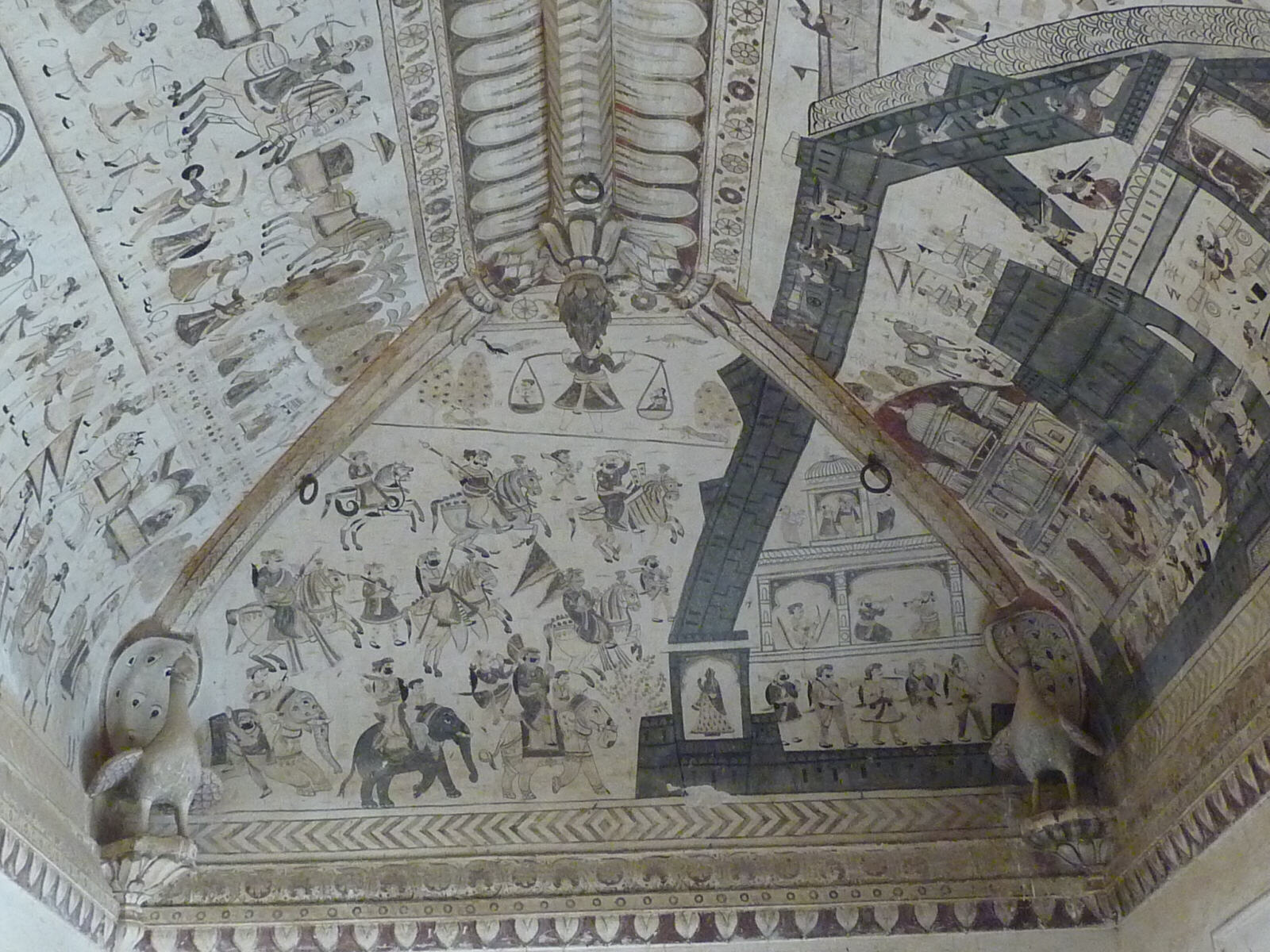
|
We went up some very steep, narrow and twisting stone stairs to the top of its central spire, and came down again even more cautiously. Then it was time to go back to the hotel and meet the rickshaw man to take us back to Jhansi station. |
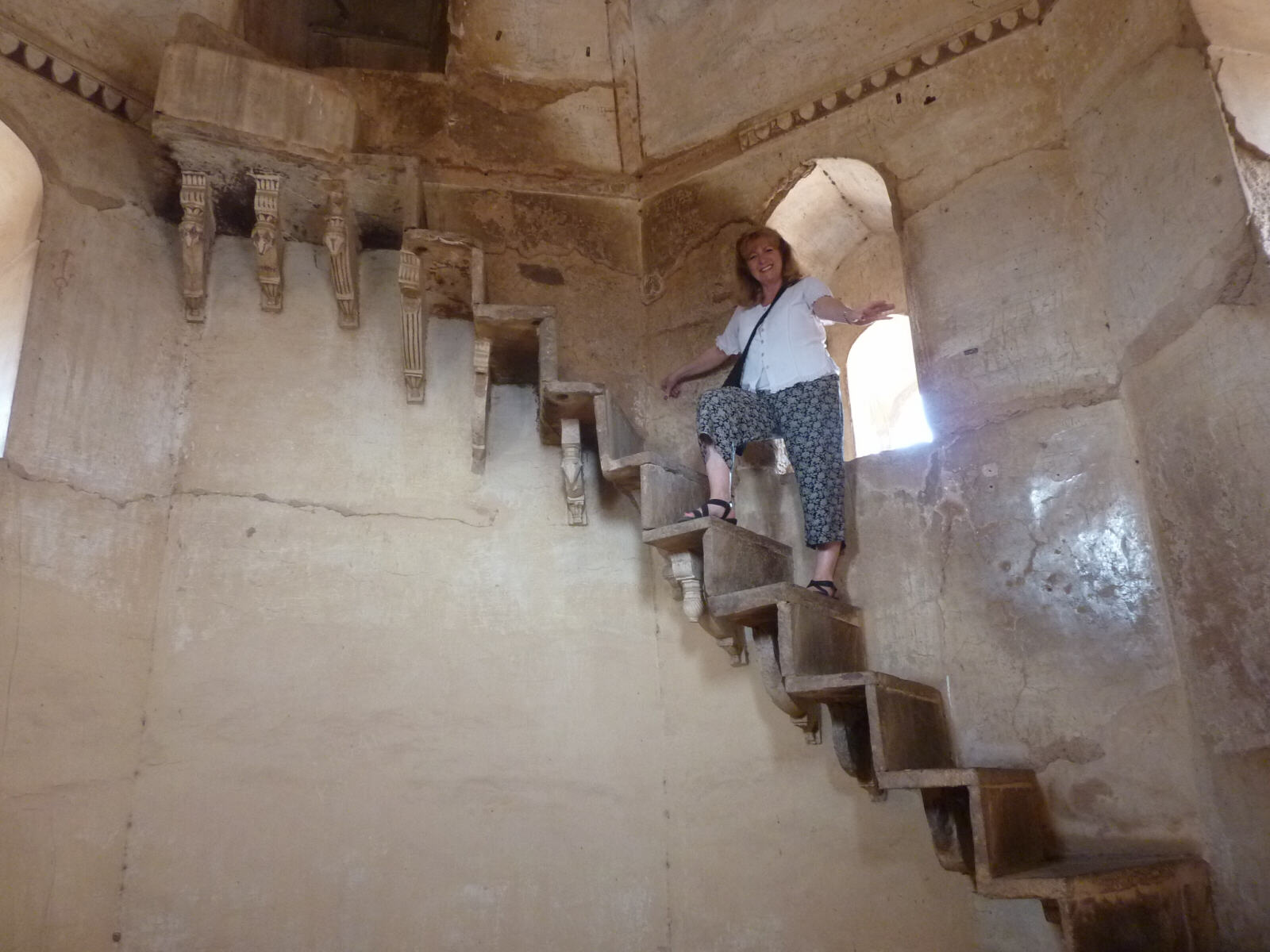
|
Kajuraho, Madhya Pradesh
|
Some of our other trains have been a few minutes late but the Kajuraho train (all the way from Udaipur) arrived a full two hours late which wasn’t a good start. We dozed and read in sleeper class and somehow after the 5-hour journey the train arrived at Kajuraho only one hour late, although I don’t know how because it went very slowly and kept stopping. Kajuraho seems a strange place, it’s a small town a long way from anywhere but there are lots of international hotels scattered around the jungle and they are building an international airport, so clearly it is being marketed effectively for tourists. We stayed at Shri Krishna Jungle Resort, a small new resort-style place with detached ‘bungalows’ around a central garden. The room was nice but the bed seemed to have been built upside down, with the mattress underneath the plank that was supposed to support it. It was the hardest bed we’ve ever slept in, and that’s saying something when you've been to China. The resort was also some way from anywhere so the nice autorickshaw driver who brought us from the station tried to take us to a restaurant but the rickshaw broke down. He called a friend and they tried to repair it but in the end his friend took us to the Gandhi Café which was just closing because it was 10pm by now, but they kindly stayed open and we had very tasty chicken lababdar and a couple of Kingfisher beers.
Fri 14th. We did the full temple tour with our nice rickshaw driver from last night. There are about 18 thousand-year old temples in three groups around the small town and we did the lot. They are all very impressive, varying in size but all similar style, with very elaborate carvings on the outside, some of which are very erotic which I wasn’t allowed to look at for too long! |
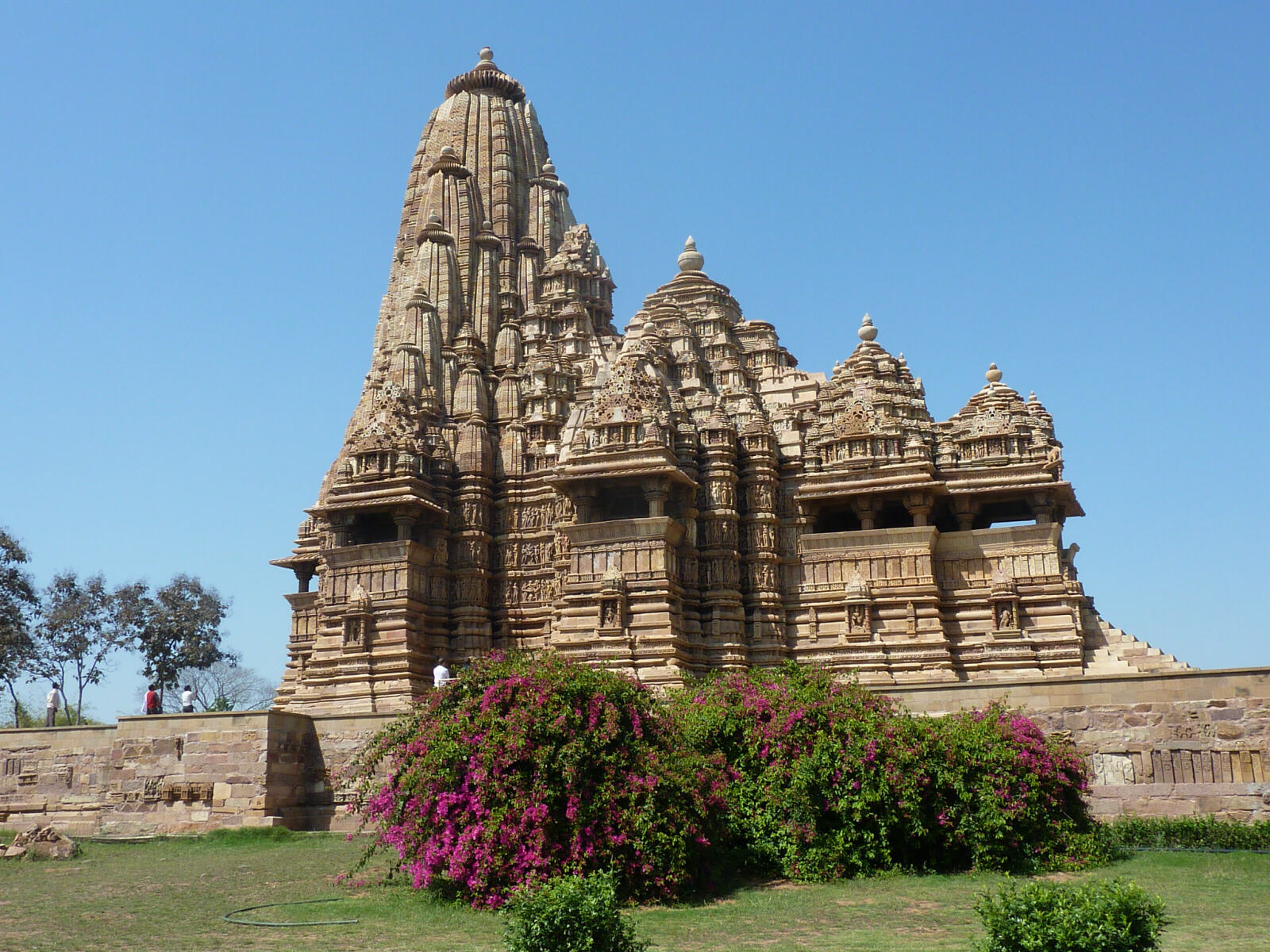
|
Khajuraho is a small town and some of the temples are in the countryside among interesting farmsteads. |
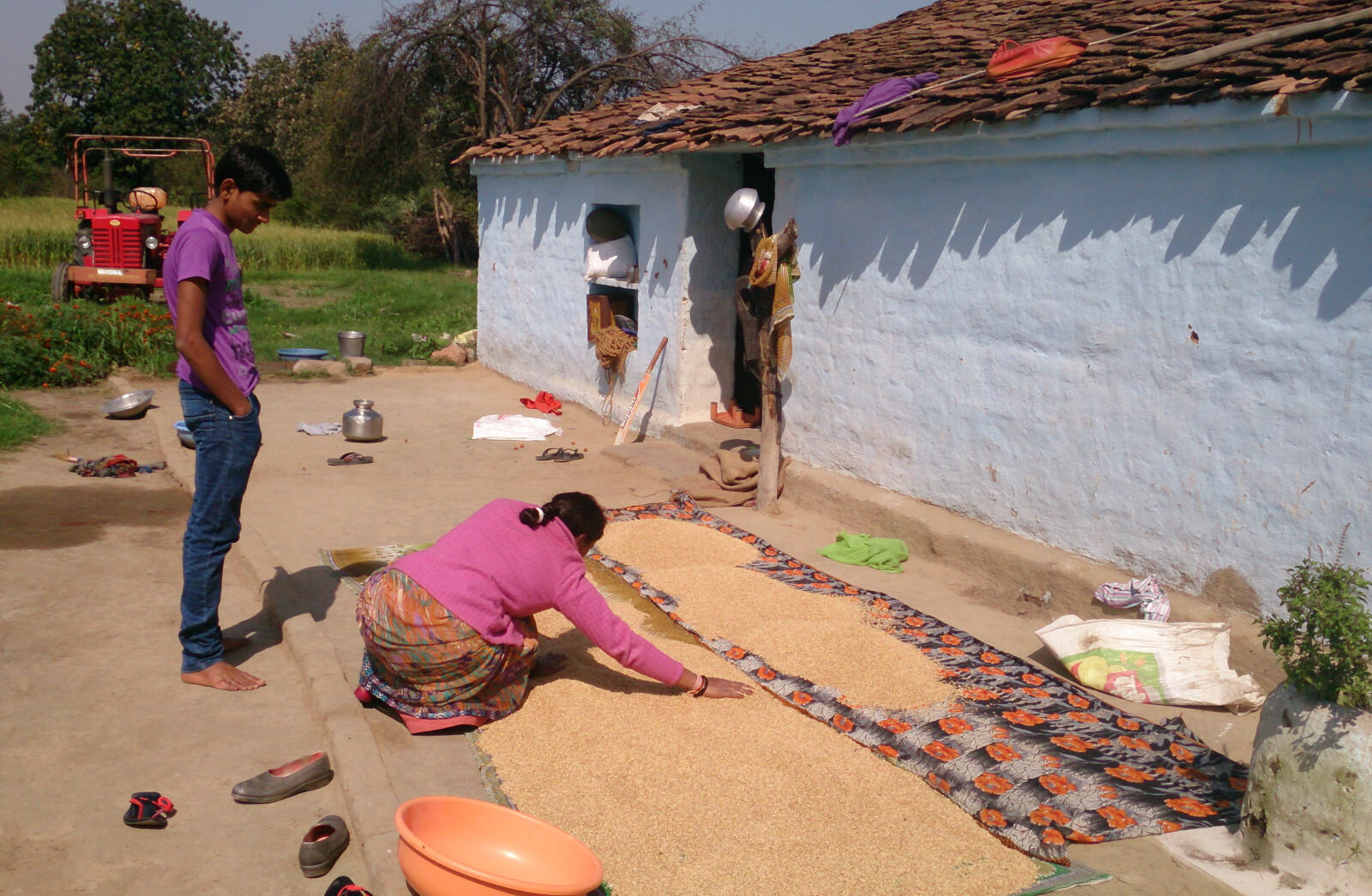
|
Between the eastern and western group of temples we went walking round the maze of streets in the old town, which is still divided into separate quarters for different castes. We met the driver’s ancient granny who lived in a tiny mud-walled hut but can’t go anywhere else because culture demands mothers live with their daughters not sons and hers were not well; although she was tiny and frail she stridently told our driver off for not visiting her often enough! |

|
After the western temples we still had some time so we decided to go to Raneh waterfall. This was an expensive excursion costing 800 Rs for the rickshaw (as per the government price list), 500 Rs for the two of us to get into the ‘tiger park’ and a mandatory 60 Rs plus tip for a guide. We had a look at the waterfall which was nice, but the most impressive part was the photos of how it floods in the monsoon, the whole of the canyon filled to the brim with raging water. We then went for a ‘forest walk’, in the autorickshaw! We went along a dirt track and saw some deer, vultures and monkeys that weren’t trying to steal our possessions, but nothing more exotic. The tour was good fun, even though the rickshaw was not quite up to scratch and we had to push-start it each time we stopped! |
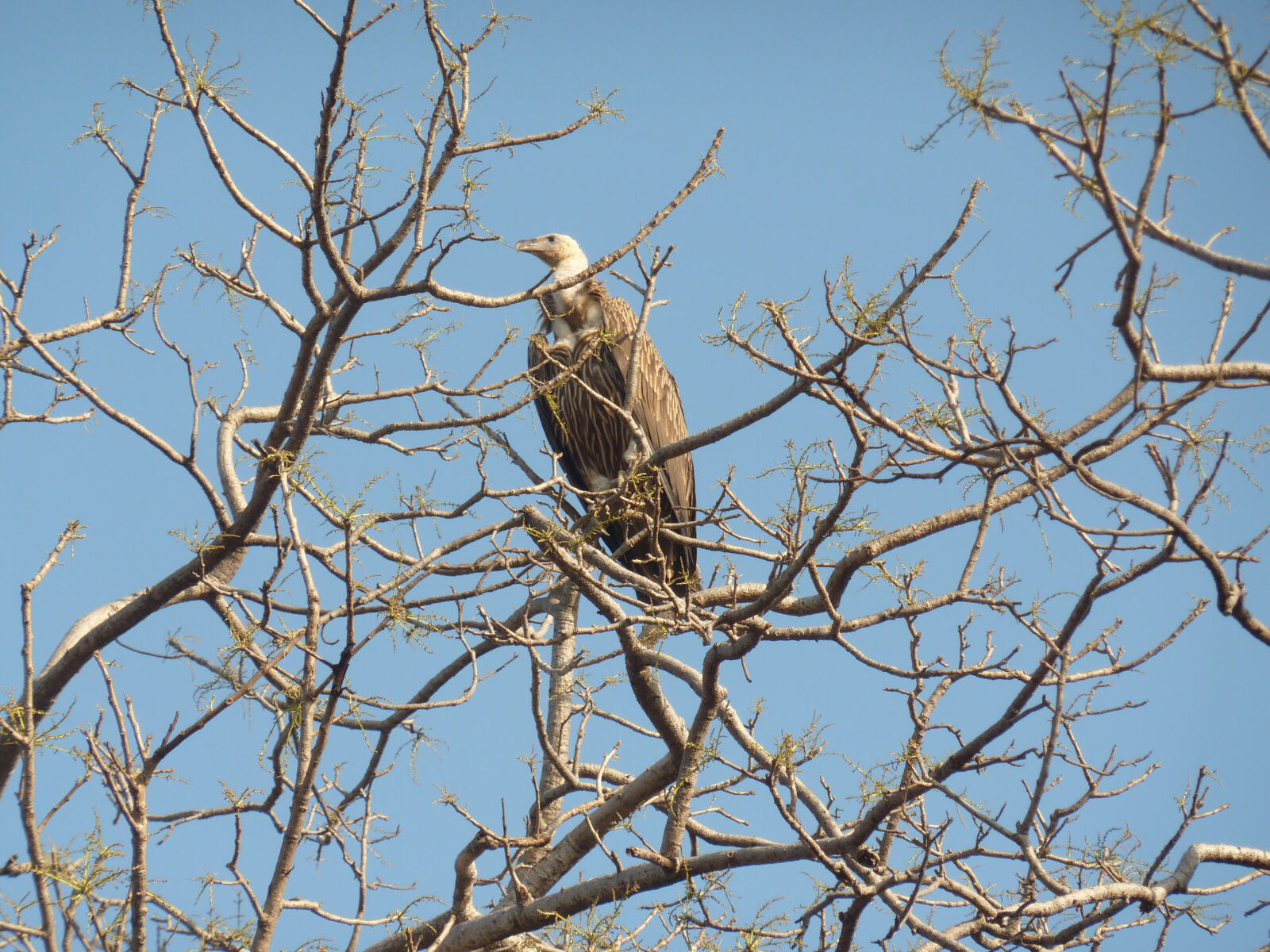
|
Back in the town there was a 'festival market' bustling with all sorts of stalls and produce, especially the spice market where the chili-dust made our eyes water. |
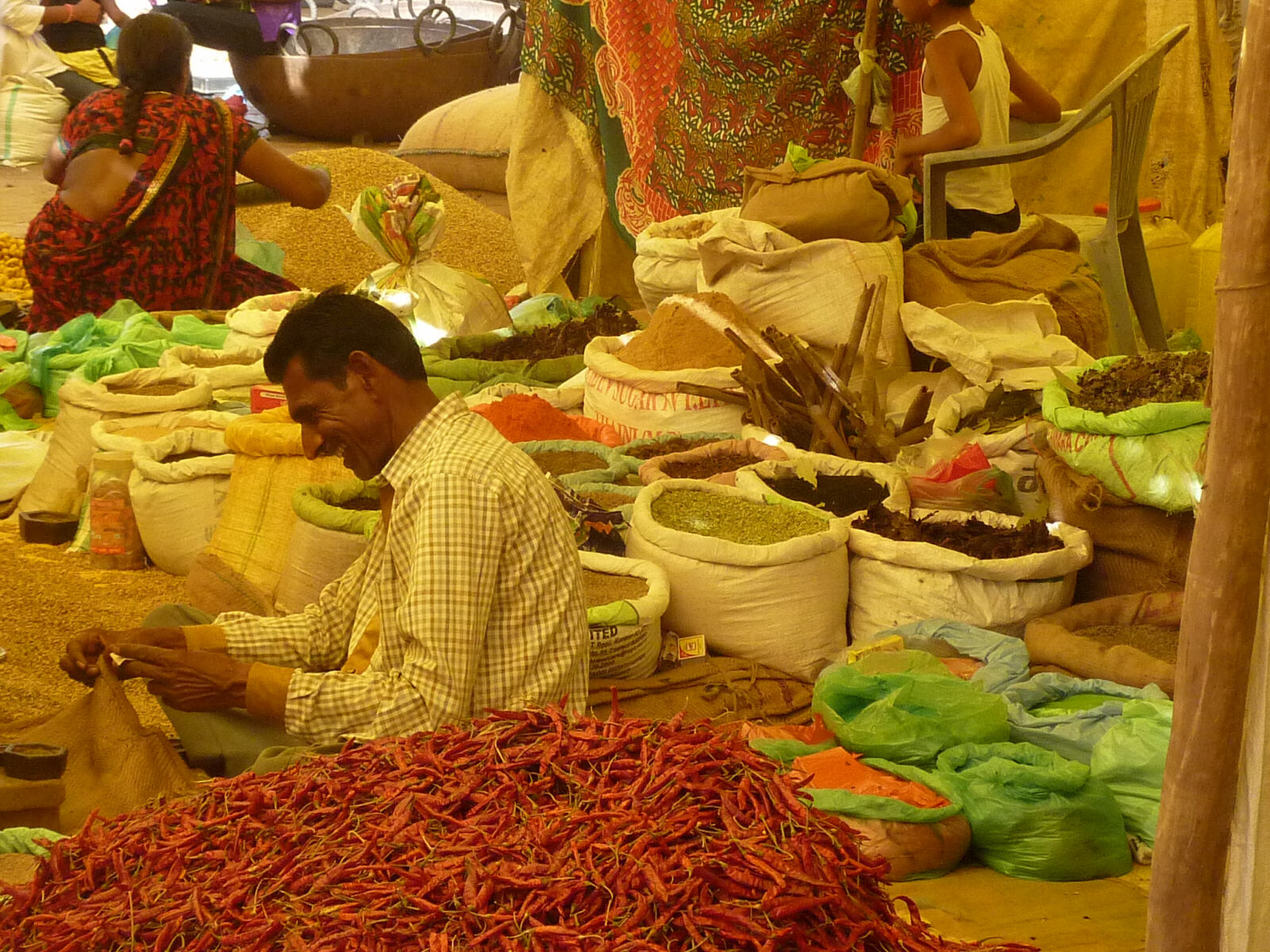
|
We arrived back at the resort tired and dusty and had a cup of tea, then our driver took us to the Gandhi Café at no extra charge, and we had exactly the same as last night. Khajuraho is fascinating but rather hassly; a lot of rich tourists obviously come here and we were often followed by children demanding rupees and pens. |
Chitrakoot, Madhya Pradesh
|
Sat 15th. There is no train to the next places we want to go, so when we were arranging it with Mr. A back in Udaipur we were easily persuaded to have a car and driver for this section of the journey. It was bliss! After the autorickshaw’s concussion-inducing lack of suspension and clouds of dust it was lovely to be cocooned in the air-conditioned capsule of a large, comfy car with Sahil our careful and friendly driver. As we neared Chitrakoot, Sahil started giving us the full guided tour, turning off the road to visit Gupt Govari, a sacred cave with an underground pool you paddle through; Satian Suya, a temple by a river with garish statues of giant chariots outside and monkeys and geese milling around; and Ram Darshan, a sort of modern Ramayana exhibition. |
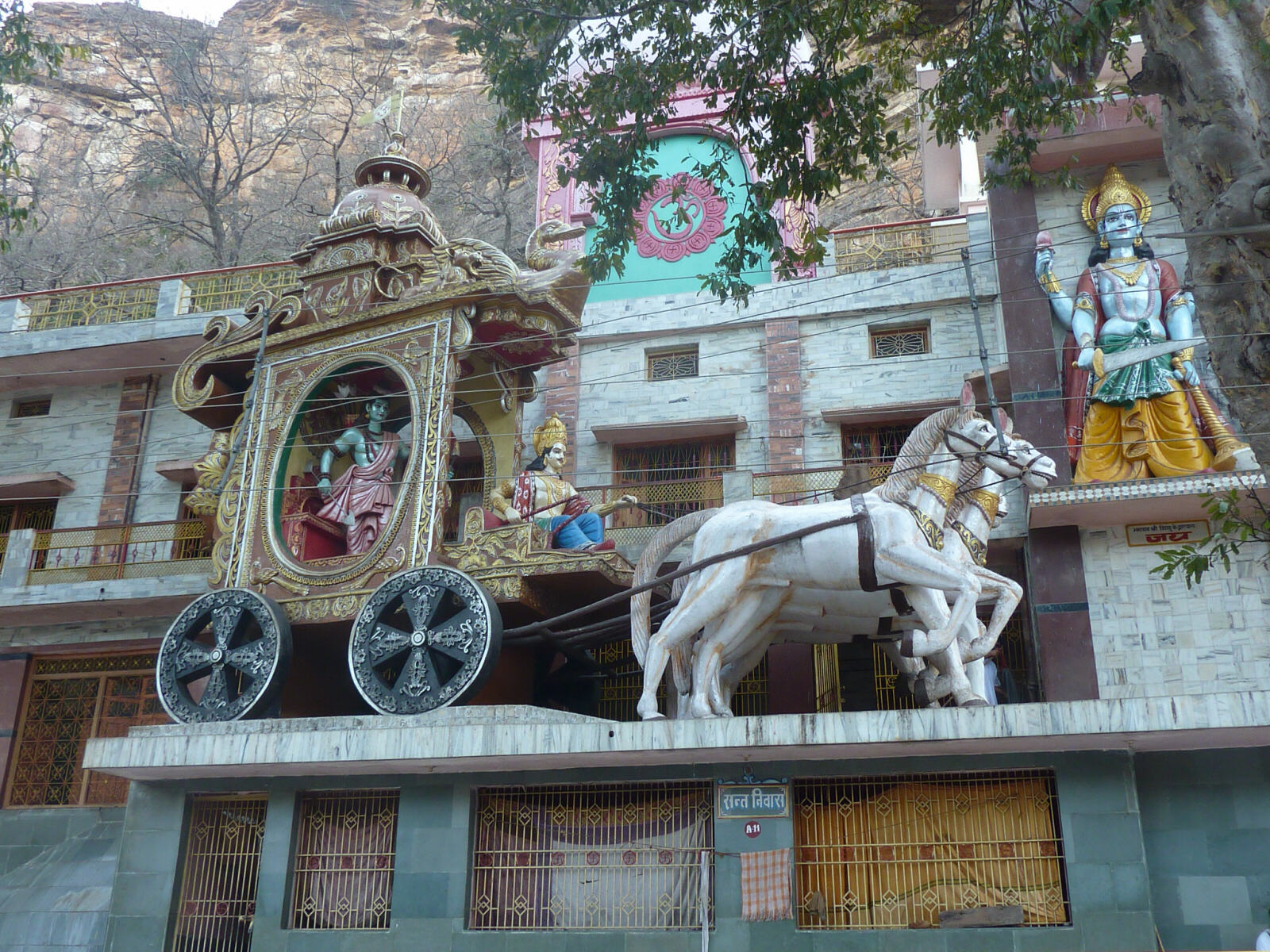
|
When we reached Chitrakoot town we checked in to the MP Tourist Bungalow, a very pleasant two-storey place (so not really a bungalow) around a central courtyard with colourful flowers. These state-run hotels used to be awful but now they seem much friendlier and cleaner, and seemed good value (although Sheila got bed-bug bites which were lurid red and itched for days). We then drove up to the base of Hanuman Dara, perched on a hill, but we only got 50 steps up the several thousand steps that faced us before taking a photo and turning back. It was now dusk and we walked from the hotel across to the nearby Raj Ghat on the Yamuna river with Sahil and went for a boat ride (500 Rs). First we went away from the town in a quiet stretch of river, then back to the ghats where the evening ceremony was in progress with large ‘candelabras’ of flickering candles, drums and chanting and little candle boats on the stream, with the backdrop of temples and old palaces. It was very atmospheric. We had a nice dinner at the hotel (pure veg and no alcohol because this is another holy place). |
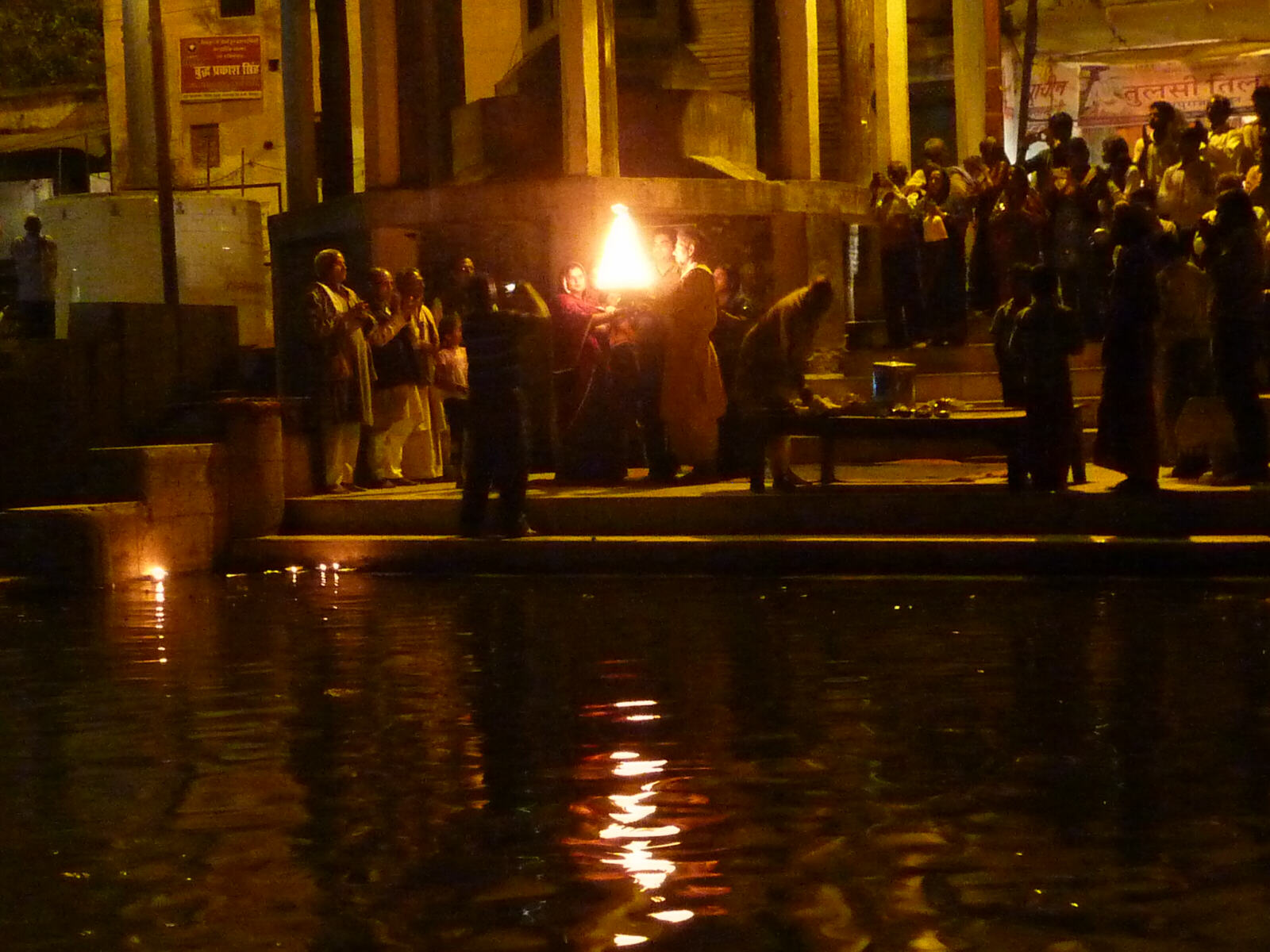
|
Allahabad, Uttar Pradesh
|
Sun 16th - Sun 17th. We continued our ride in the comfortable car, leaving before 8am and arriving in Allahabad across the big new bridge at 11am. We had booked another state tourist bungalow but instead of the old one in the town centre we arrived at the brand new (actually half-finished) Triveni Darshan UP tourist hotel right on the bank of the Yamuna River. The half of the hotel that’s finished is very nice and we got a room with panoramic windows and a balcony overlooking the river with sailing boats drifting past, the big new bridge to one side and the historic old two-tier bridge (trains on top and road underneath) on the other. |

|
The Holi festival (festival of colours) had started, which features people (especially children) throwing ‘colour bombs’ (packets of coloured powder and/or liquids) over each other and especially over tourists. A couple of years ago in Delhi we ‘played Holi’ and got completely coloured which was good fun at the time but ruined our clothes, so we decided to try to avoid it this year. Therefore we had a couple of days off, relaxing in our lovely room watching the boats go past, and having nice dinners in the hotel. We were the only guests but were very well looked after by the friendly staff under the supervision of Rajesh, the nice UP tourism man. Our plan to get a boat and go slowly down the Ganges to Varanasi seemed to be a non-starter, partly because the boatmen were having several days off for the festival, but also because Rajesh arranged for us to use his car and driver. We were trapped in the hotel by Holi and the distance from the town so we weren’t able to explore any other options. Most of the shops were closed, including the bread shop, so we couldn’t even have toast for breakfast. |
Varanasi (or Banaras/Benares), Uttar Pradesh
|
Tues 18th. We had an uneventful drive through the Kumbh Mela site where the Ganges and Yamuna Rivers meet, over the Ganges and along the surprisingly empty Grand Trunk Road (lorry drivers are still sleeping off the festival) to Varanasi (pronounced Varanassi not Varanaysi) in the car Rajesh arranged, keeping the windows tightly closed. At one village boys ‘played Holi’, throwing coloured water which left an interesting pink pattern all over one side of our white car, which apparently can only be removed with strong chemicals. At one point we met an elephant walking down the road and Sheila had to stop for a quick elephant ride! |
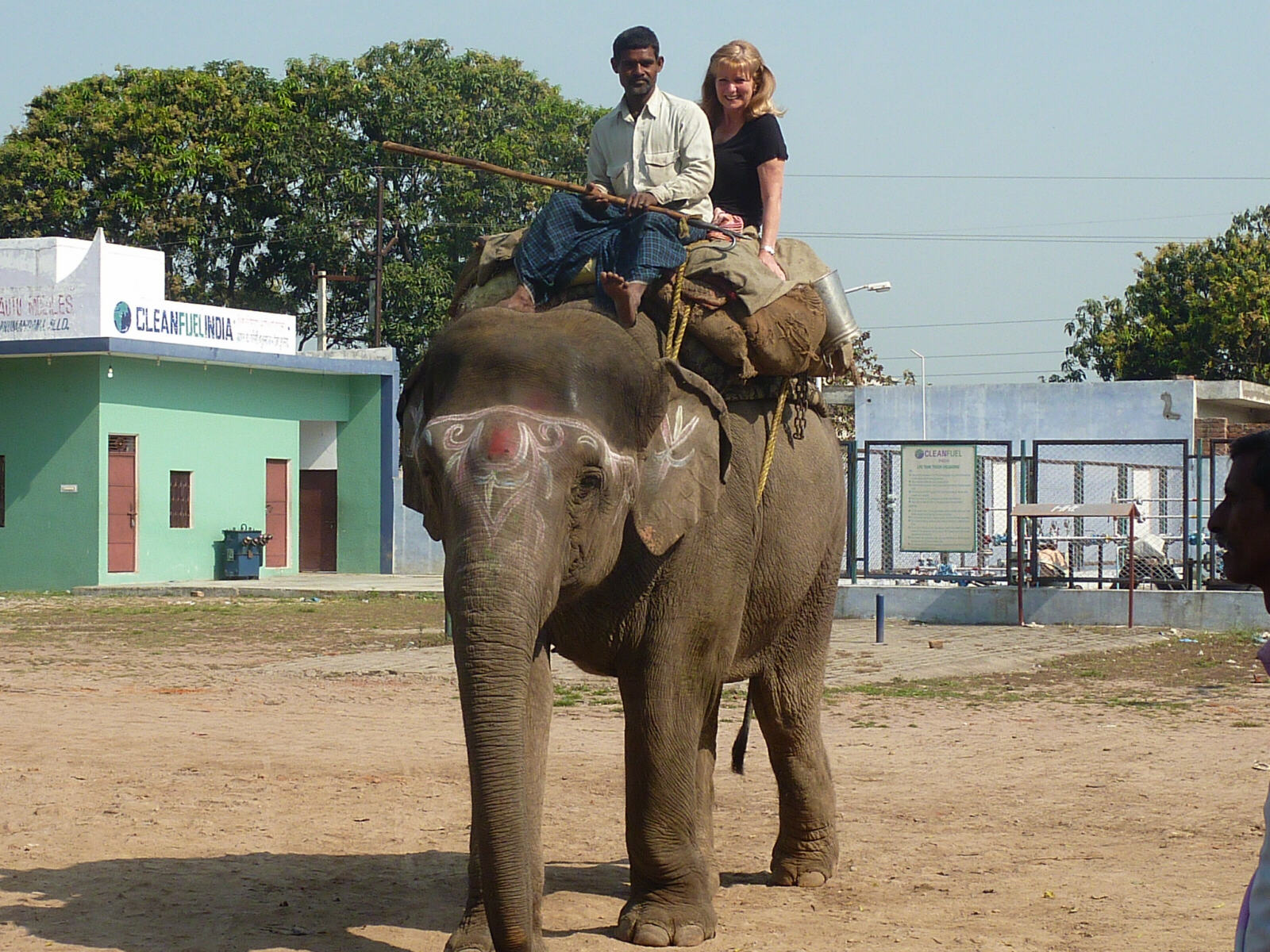
|
We went to the Buddha Hotel and thanks to Rajesh’s recommendation got a really nice room with double-aspect windows, balcony and a bathtub (although the water ran so slowly we could never get more than an inch of water in it). The staff there were all lovely friendly people and nothing was too much trouble for them. When it cooled down a bit outside we went down to the bathing ghats on the Ganges but there wasn’t much happening. We had a look at a couple of very nice but very expensive ghat-side hotels and had a beer and a snack at one of them, then got an autorickshaw back through the even crazier than normal streets to the hotel.
Weds 19th. We expected so much but our initial impression of Varanasi was a huge disappointment. The drivers were rude and aggressive, driving straight at you on their motorbikes with horns blaring continuously. The bathing ghats, a so-called holy place, were a series of toilets and the stench of human urine follows you everywhere, while you have to watch every step to avoid the cow-dung that litters the steps and walkways, and all the while we were bitten to death by mosquitoes or something similar. The ghats were dead, with only a few people bathing or going on boat rides here or there. We discovered later that we had picked the wrong day and the wrong time – because of the festival no street-cleaners had been working for days, and we turned up in the afternoon when most people were snoozing. We walked half-way down the ghats from Assi Ghat to Meer Ghat then turned inland and wandered through the fascinating labyrinth of alleys behind them. The back streets were very interesting but there was a feeling of tension, with armed police on every corner because of ‘community conflicts’. We stopped at Ganpati Guest House on Meer Ghat and had a nice 'comfort lunch' in their restaurant of soup, salad and mashed potato with fried onions, garlic, mushrooms and cheese. We went back to our Buddha Hotel, a haven of peace from the madness in the streets. In the evening we fought our way across Lahurabir Crossing, the ‘roundabout’ near the hotel, and went a little way up Station Road to Lemon Grass restaurant where we had a superb Chinese meal and a couple of Kingfisher beers.
Thurs 20th. Straight after breakfast (fried eggs, scrambled eggs and a boiled egg!) we got an autorickshaw to Sarnath, 10 km outside Varanasi, an important Buddhist pilgrimage site. In a blissfully peaceful park there is a big 2,000 year old stupa marking the spot where Buddha preached his first sermon, and nearby there are the ruins of various monasteries and an adjacent deer park where you can feed the deer through the fence. All the monuments have this sign on them, which neither Sheila nor anyone else took any notice of! |
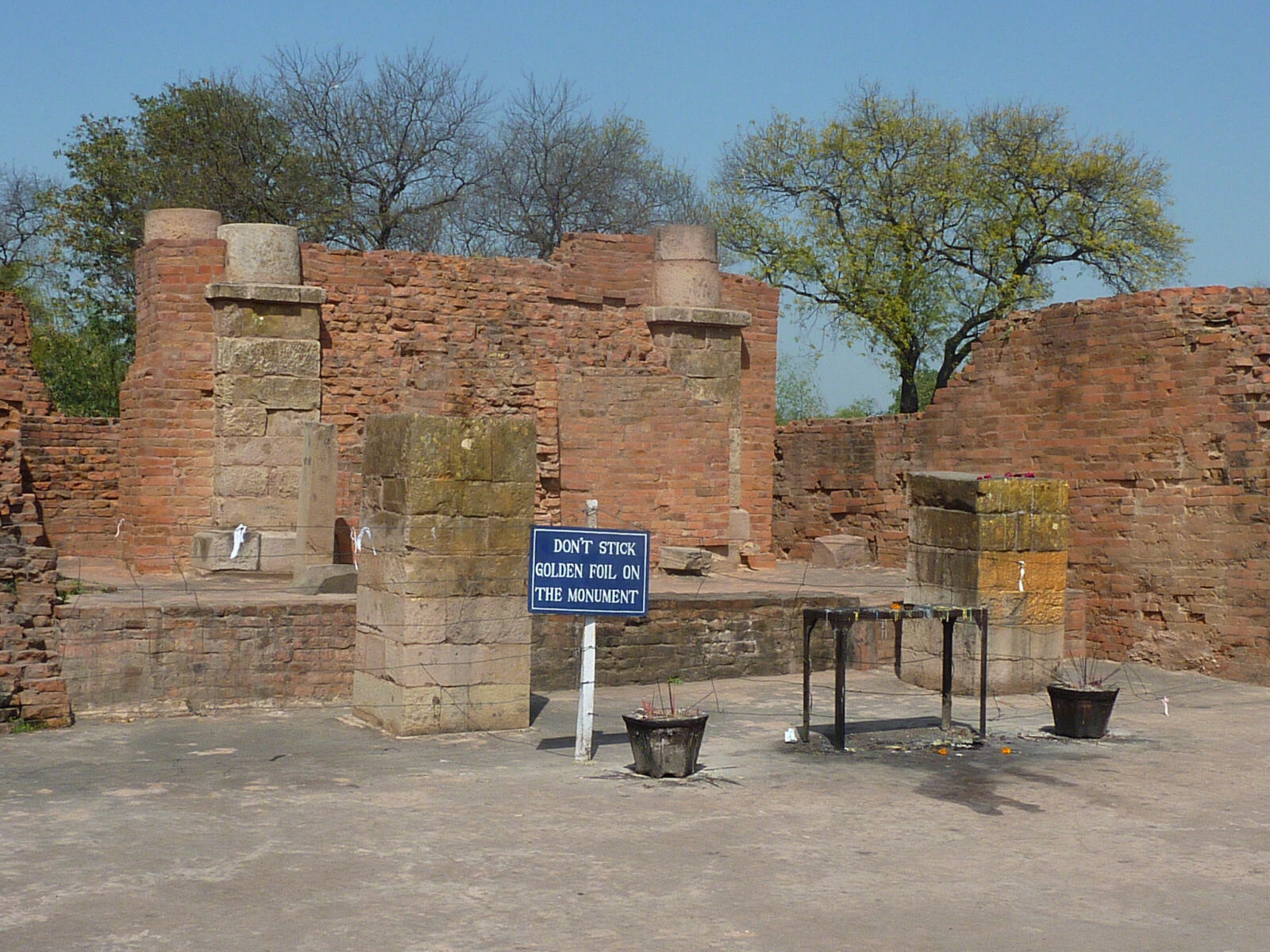
|
Nearby is another temple with a Bodhi tree grown from a branch of the tree in Sri Lanka that was grown from the original Bodhi tree that Buddha sat under, and in the nearby museum is the very impressive and well-preserved capital from Ashoka’s pillar featuring the four lions which has been adopted as India’s national emblem and is on all the banknotes. Back in Varanasi we went down to the main ghat and walked along to Ganpati Guest House for another mashed potato late lunch. Once more we walked through the seething back streets but this time we turned back towards the ghat and allowed ourselves to be talked into a boat ride (100 Rs per person per hour plus tip) with a very nice boatman who explained everything in good English. After rowing up and down the ghats as dusk fell, he navigated us through the crush of boats to the front as the evening puja ceremonies took place, with a row of Brahmin priests and much chanting, ringing of bells and waving of candles. |

|
The candle-holders are extremely heavy, and the ceremony lasts for a long time, so the priests are stronger than they look. |
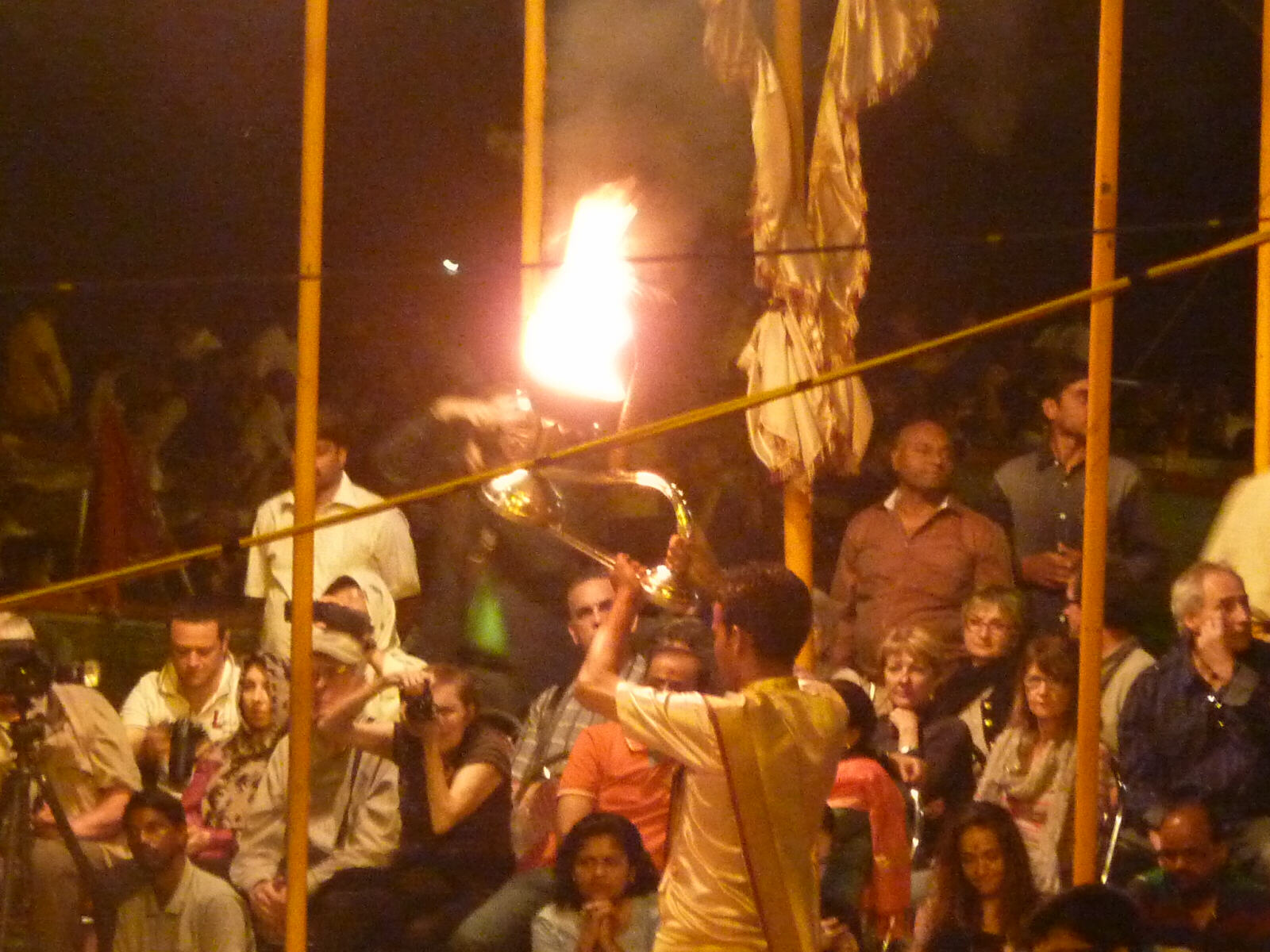
|
It was amazingly atmospheric and exactly how we expected and wanted Varanasi to be. |
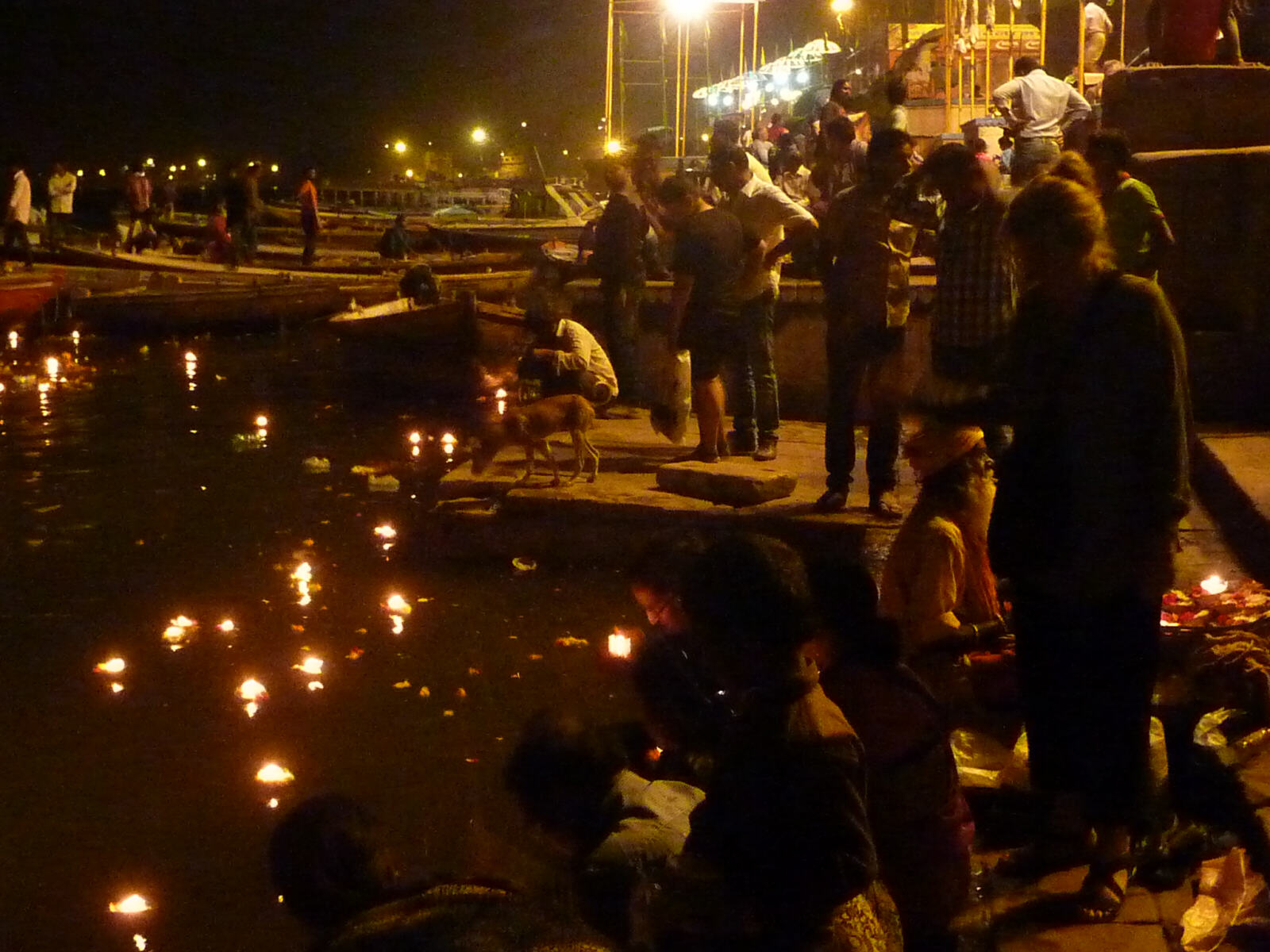
|
In the evening we went to the lounge bar at Lemon Grass for beer and snacks sitting by the big fish tank. Now that the street cleaners are working again and the rubbish is in piles instead of strewn everywhere and the ghats are full of people, colour and atmosphere, we like Varanasi much more than yesterday.
Fri 21st. We dragged ourselves up before 5am and cycle-rickshawed through the almost empty streets to the ghat for the dawn boat tour. |
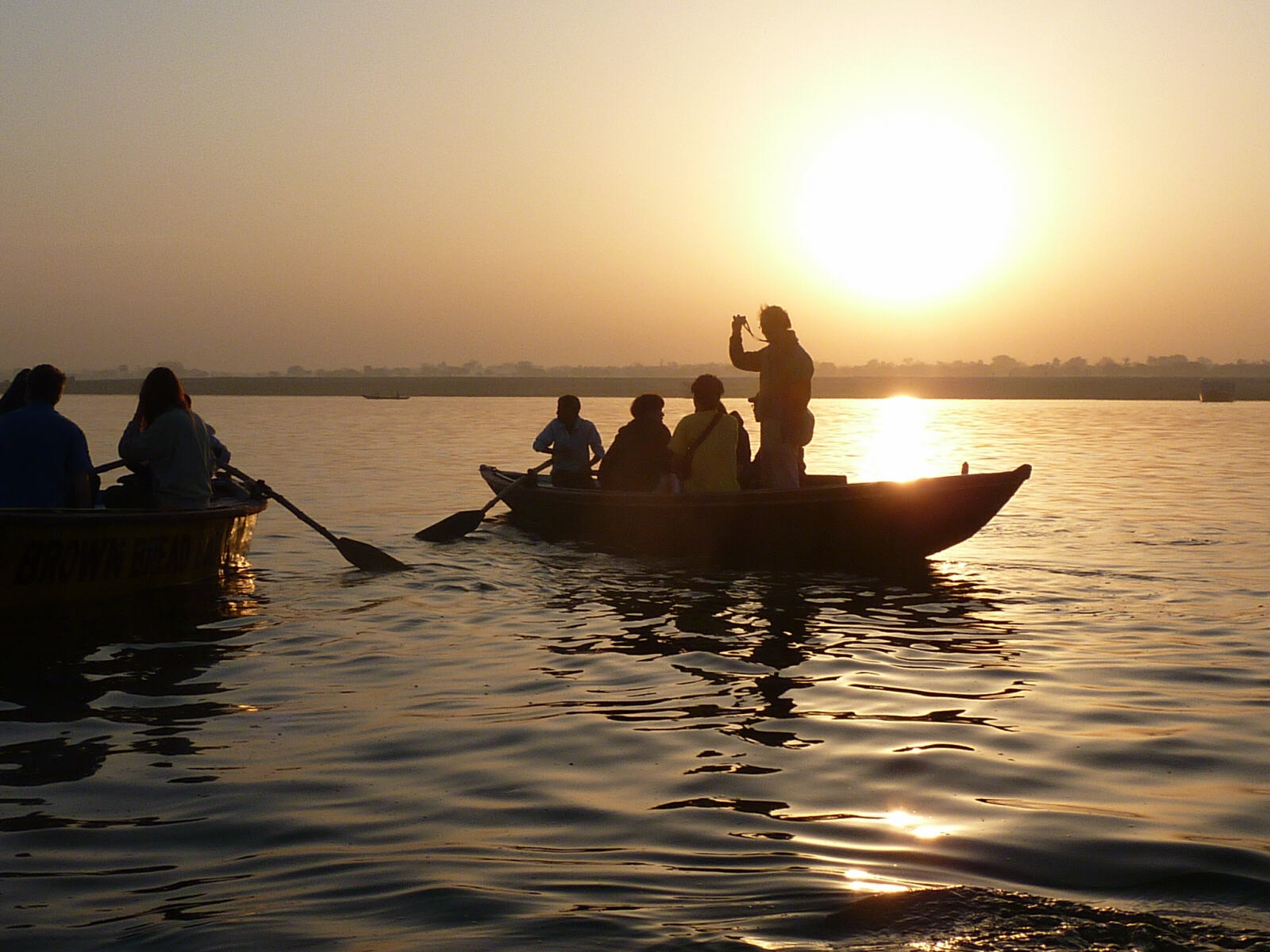
|
This was also very atmospheric as the sun came up bathing the temples and palaces in a warm glow. |
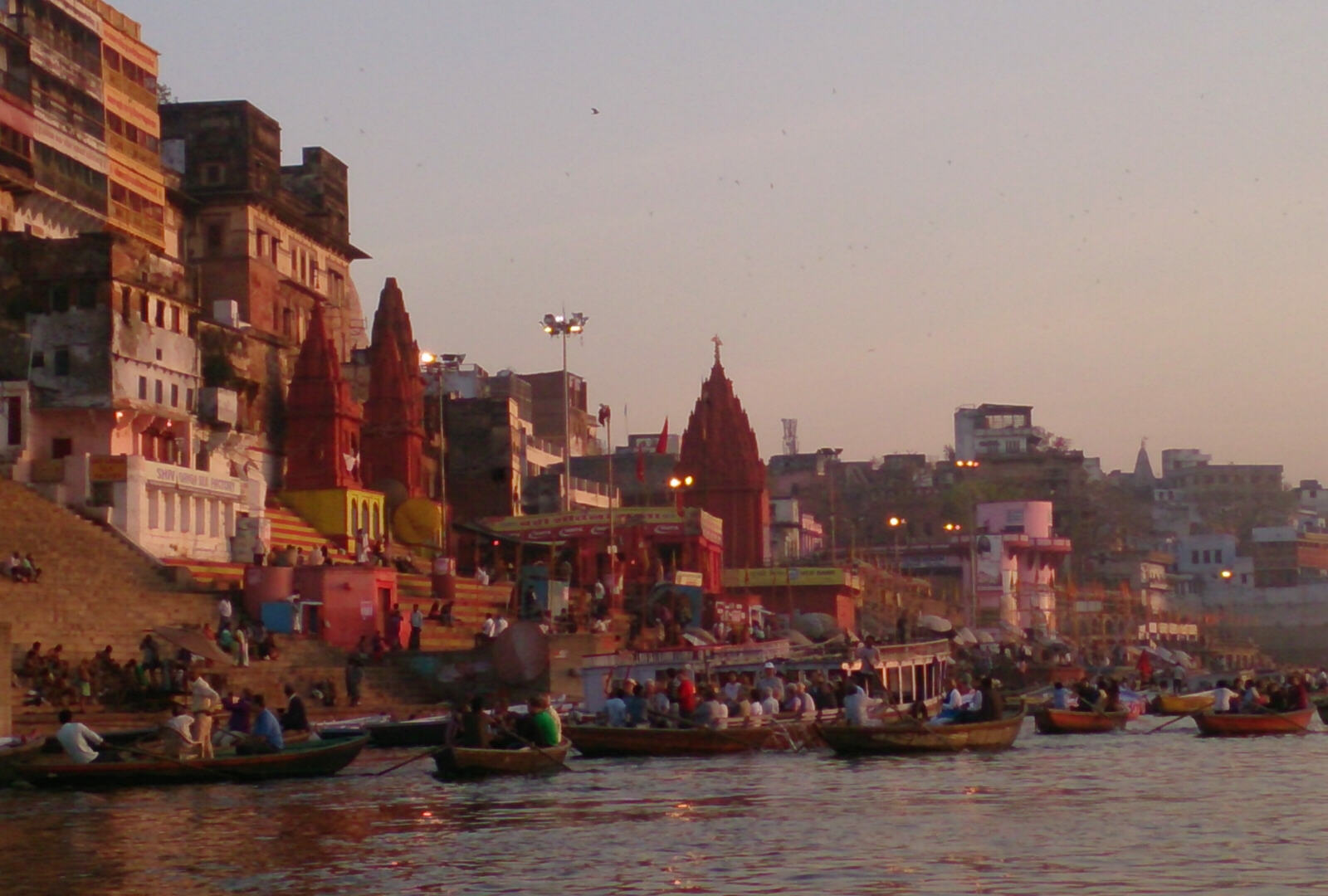
|
We went with the same nice boatman who pointed out interesting features such as the monsoon flood marks where the water had reached way up the walls of the buildings behind the ghats, so that it was almost impossible to imagine so much water (see the black marks near the red line on the right-hand building). |
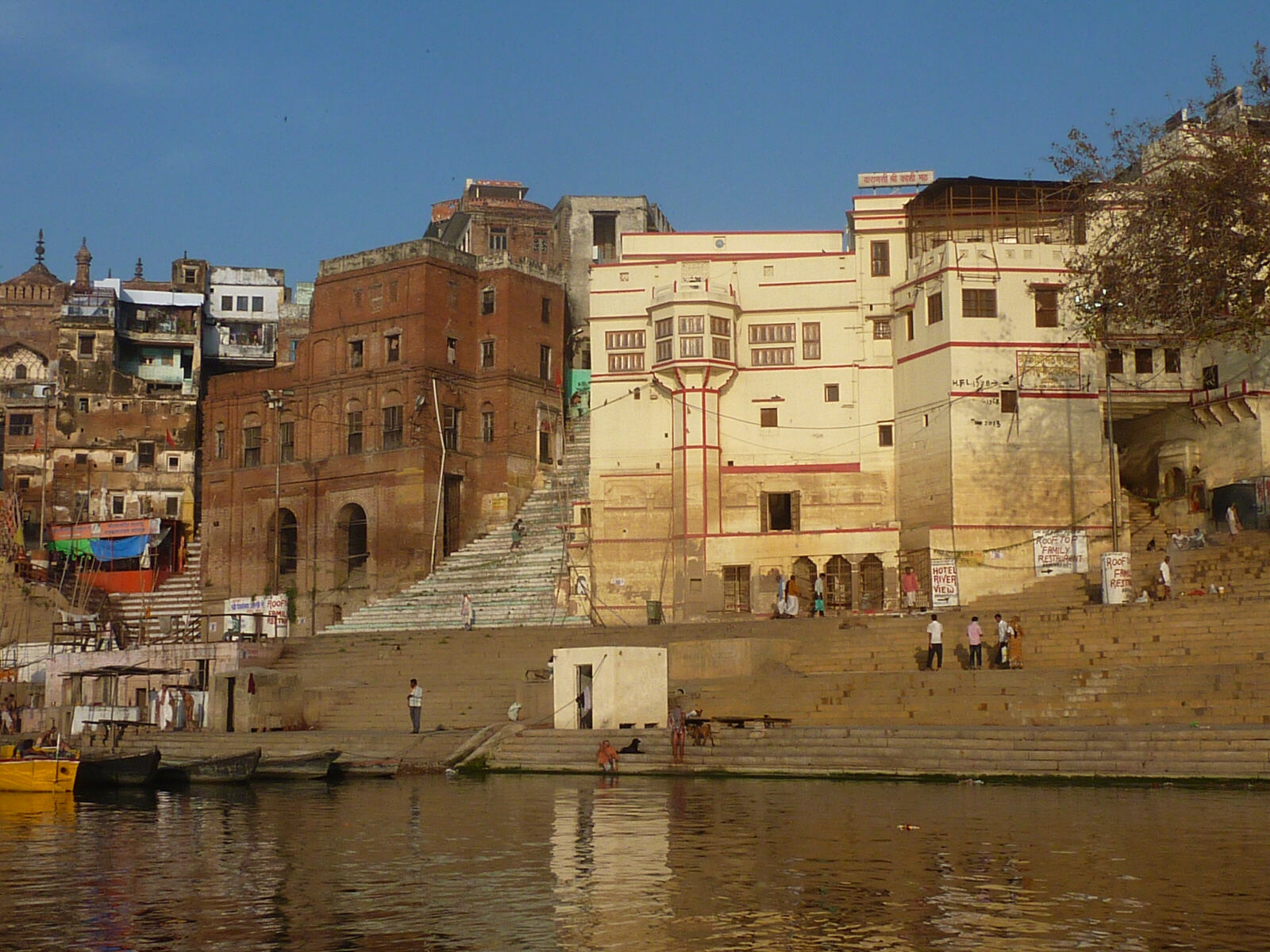
|
We didn’t linger by the burning ghats but our boatman explained the procedure and that certain categories of people are not burned, specifically children under 10, pregnant women, lepers and people who died of Cobra bites; they are wrapped up and weighted with stones and sunk in the river. He also pointed out a couple of hotels that had been smashed up by order of the government because no new buildings at all have been allowed on the ghats since 1985, and these had been built without ‘planning permission’ however rich the owners were. After the boat ride we wandered around for a little while watching the hubbub of bathing, clothes washing, worshipping and goodness knows what else, all happening elbow to elbow on and in the water’s edge. |
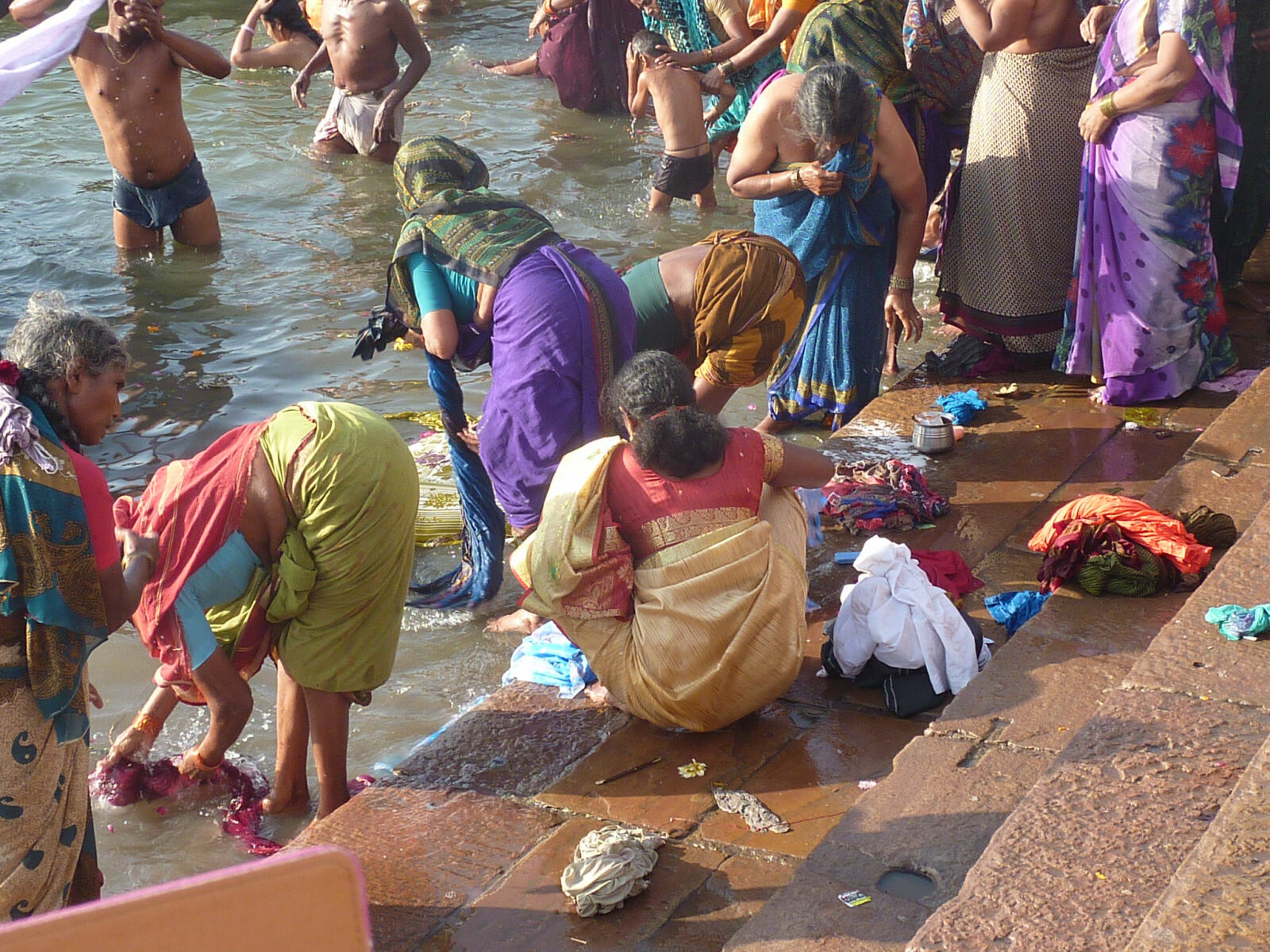
|
A morning worshipper found a 'window of tranquility'. |
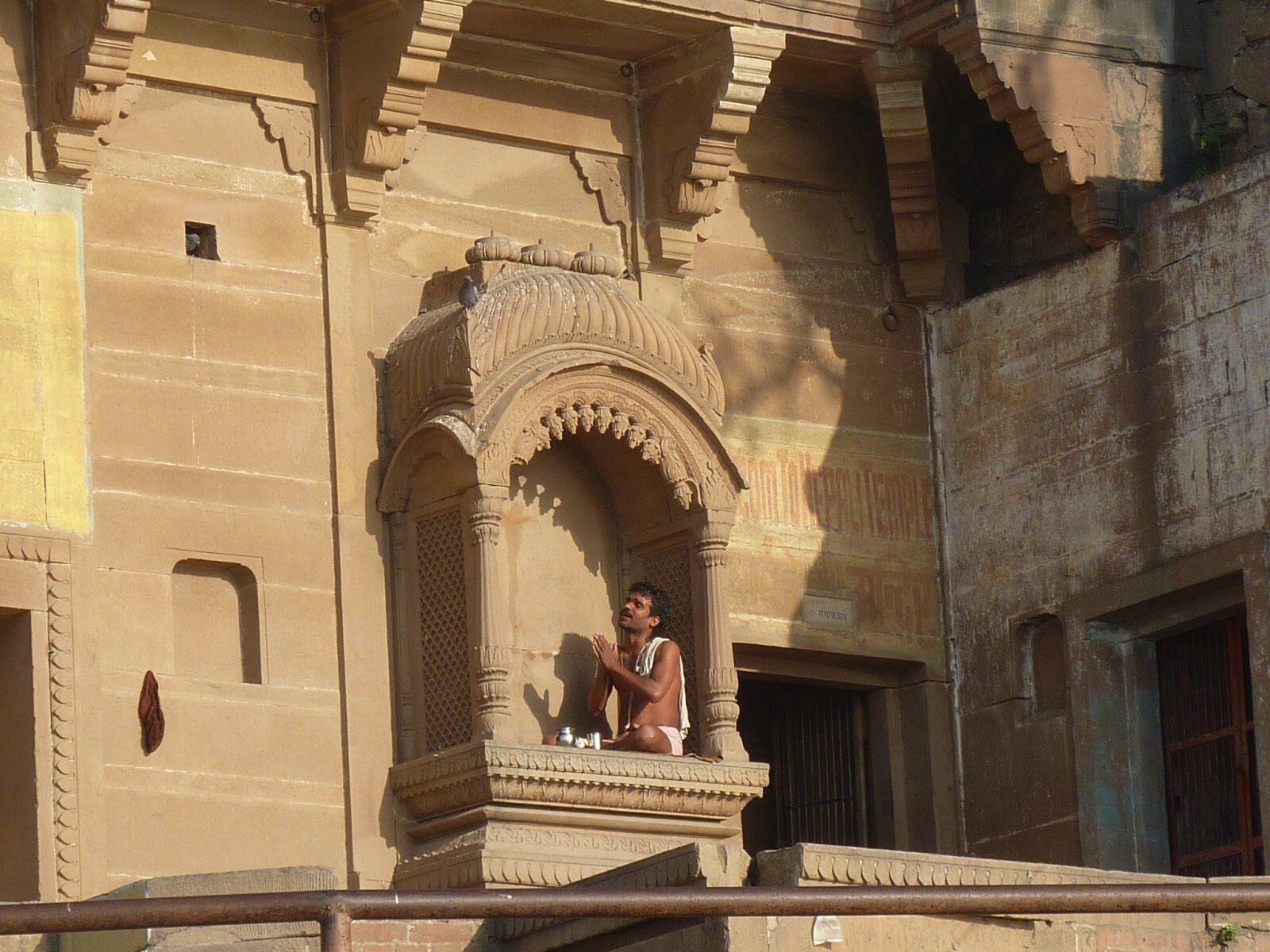
|
We returned to the hotel with a hearty appetite for breakfast. In the afternoon we went to the Muslim silk ‘factory’ which was a neighbourhood of houses which each seemed to have been built around a silk spinning machine which completely filled up the downstairs rooms. As we walked round the narrow streets a deafening clatter from the antiquated machinery came from every window and doorway, all hard at work although Friday is supposed to be the Muslim holy day. We went to the obligatory silk shop but didn’t buy anything.
Then we went in the autorickshaw a very long way round and across the river to Ramnagar Fort, a rambling, crumbling dusty old place still owned and totally neglected by the Maharajah. It has a museum of the Maharajah’s possessions including several classic 1930s and 1940s American cars, all covered in 50 years’ worth of dust. We insisted on going back across the Ganges on the nearby rickety rackety pontoon bridge which was much quicker but the autorickshaw driver was not too happy about it. |
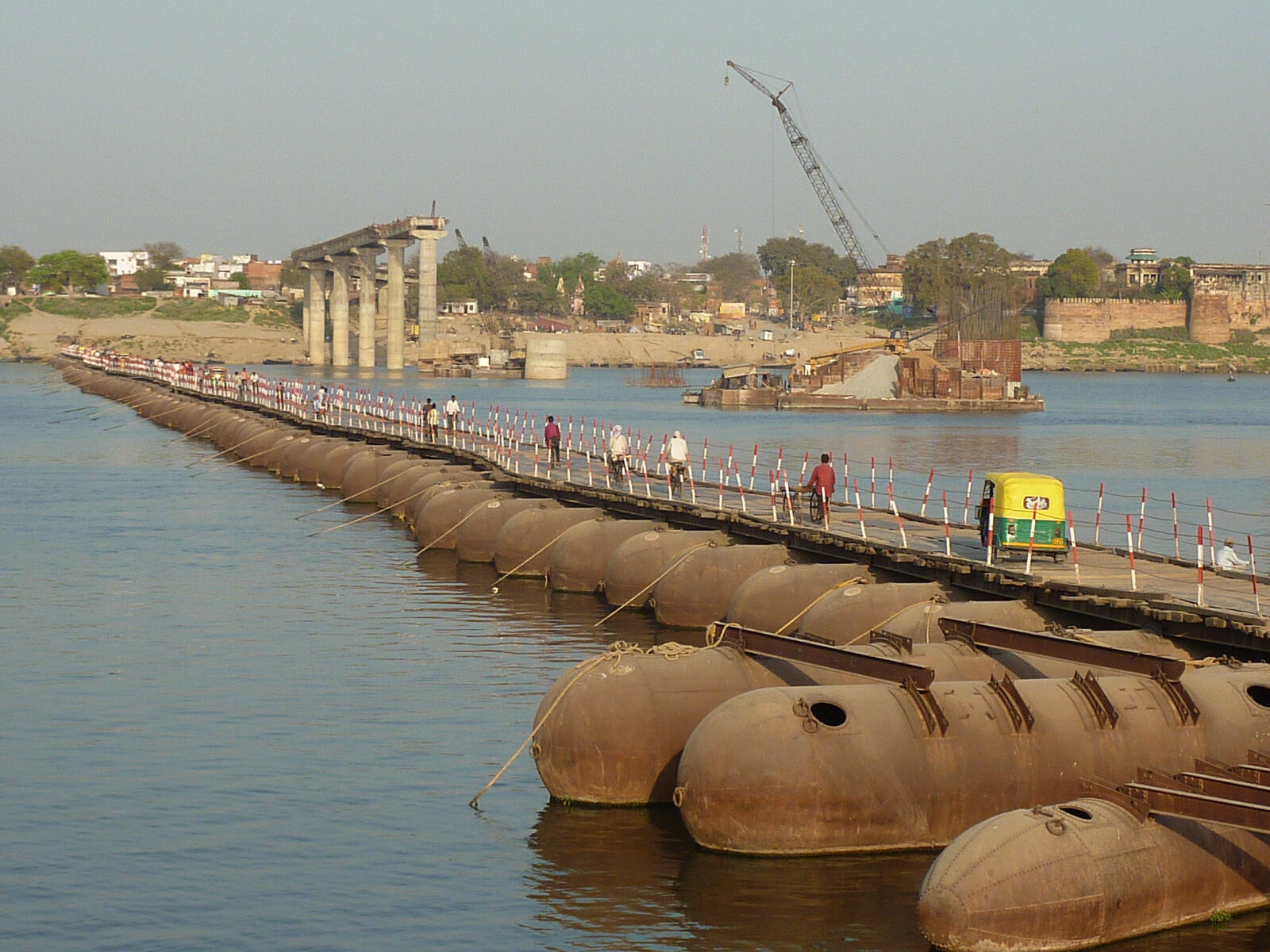
|
Sat 22nd. After a lazy morning we went to the station to get what was advertised as the 4:15pm train to Calcutta. It had come all the way from Dera Dun in the mountains and finally arrived about 5pm. However the first driver had finished his shift and the replacement driver hadn’t turned up, so we sat there for over an hour before the train got moving. We had a ‘sideways’ upper and lower berth in 2A class (2-tier air conditioned) and it was very cozy when we’d spread out our bedding, drawn our curtains and the hubbub of the other passengers died down. |
Calcutta (Kolkata)
|
Sun 23rd. We slept well and woke refreshed, apart from more bed-bug bites that appeared on Sheila over the next few hours, presumably from the much-used train blanket. We sat by the window watching the paddy fields go by and the amazing variety of vendors go up and down the train - chai and coffee, black tea, lemon tea, bread butter boiled egg, shoe polisher, cone of mixed onion, nuts etc, samosa, coconuts, newspapers, shopping bags, chocolate and sweets, cashew nuts and peanut brittle, trinkets including combs, mobile phone covers, squeaky toys etc., bottles of water and so on. A sweeper came by carefully sweeping all the rubbish to the end of the carriage, then swept it out of the door as we continued on our way. He was followed by a man spraying perfume on the curtains and a man with spray and mop cleaning tea stains off the floor. The train was now four hours late and finally after 18 hours it came to rest a few kms outside Calcutta. Nothing happened for a long time then passengers began deserting the train and we followed them, down the tracks to a nearby station where we got on a local commuter train and rode into Howrah station, with Sheila realizing her long-held dream of standing on the footplate hanging out of the doorway like a local. We were back in Calcutta, more or less completing the ‘grand tour of India’ that we started here eight years ago. We got a trusty old yellow Ambassador taxi from the prepay taxi rank and went to the Fairlawn Hotel in Sudder Street, still a wonderful old family-run colonial style hotel, a Calcutta institution and preserved historical building, where we stayed eight years ago on the first stop on our first visit to India. |
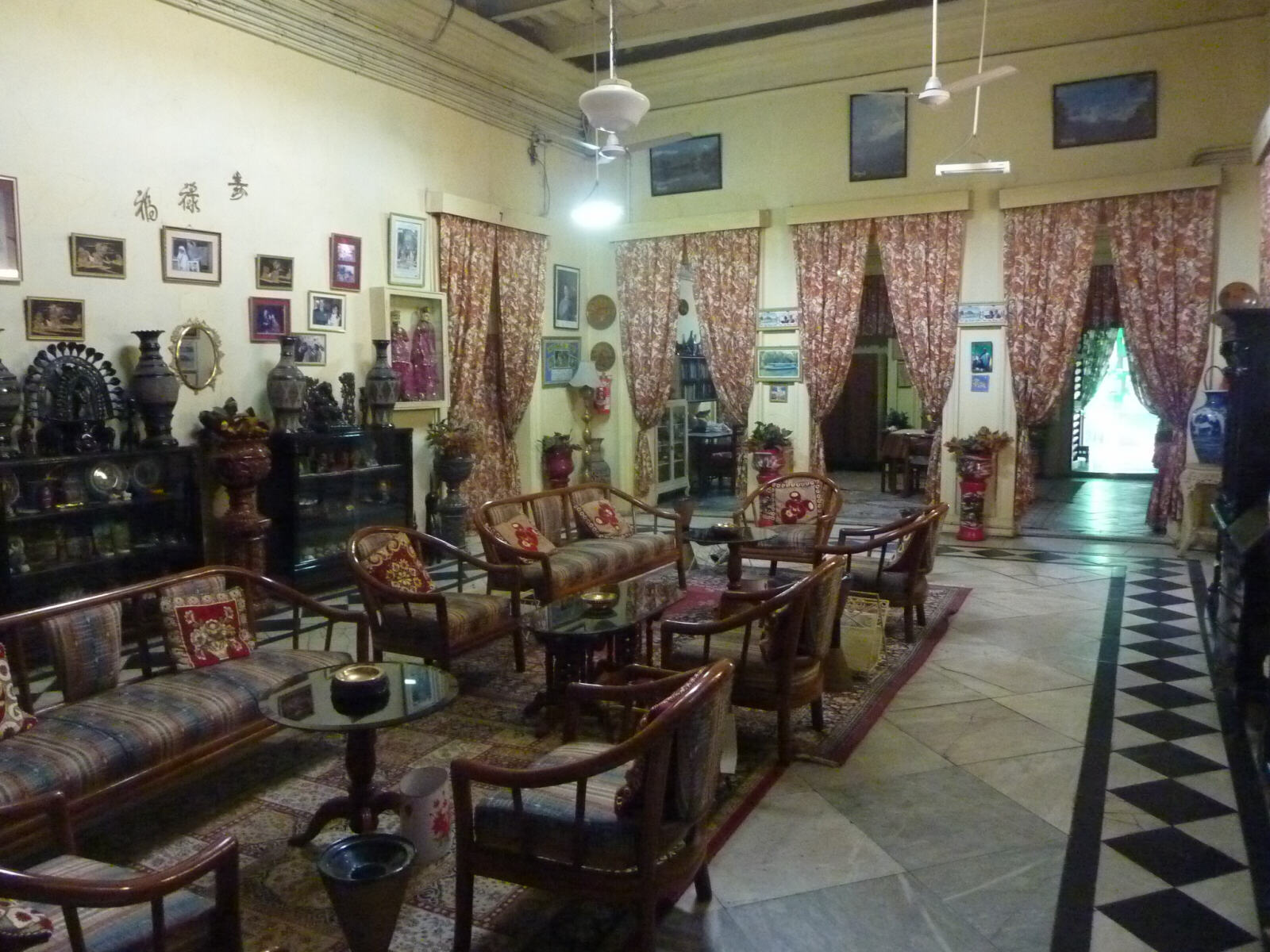
|
We had lunch of more ‘comfort food’, mashed potato and fried onion and pizza, just across the road in the Blue Sky café, a popular, crowded travellers’ café with an extensive and varied menu. In the evening we had a look at the restaurants around the junction of Mirza Ghalib Street and Park Street and chose Trincas which had a live band and singers that were loud but not totally deafening, and had a nice Indian meal with red Sula wine.
Mon 24th. We went for a bit of shopping on Elgin Road and then in the New Market, then for lunch at Blue Sky café. It was obviously a quiet day for this egg seller in the market! |
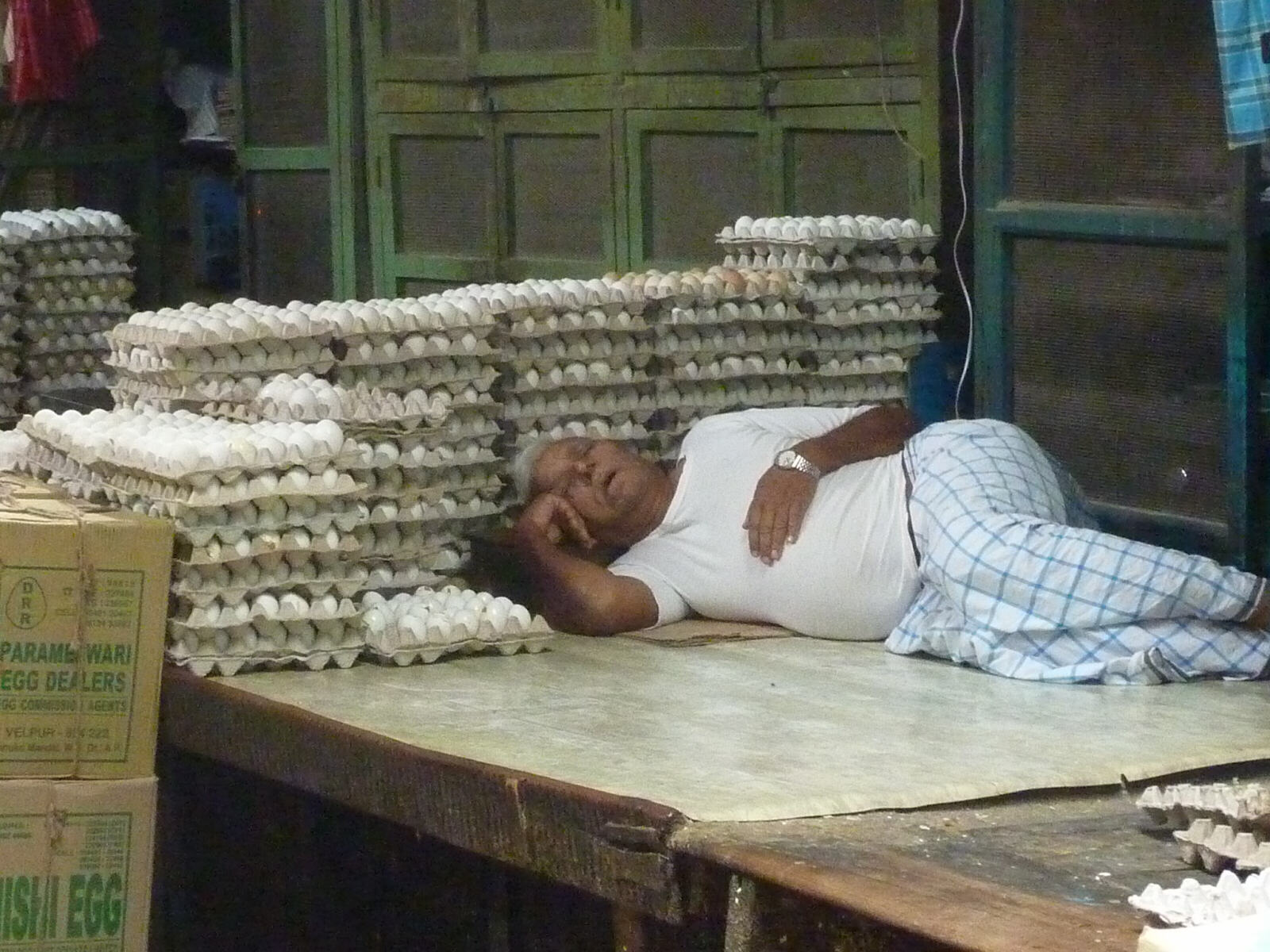
|
While Sheila napped I had a coffee and cake at Flury’s coffee shop, a Calcutta institution since 1927. In the evening we had a very nice Chinese meal at Jimmy’s.
|
The Sundarbans, West Bengal
|
Tues 25th. We both ate and drank exactly the same at Jimmy’s, a restaurant where we’ve eaten before and thoroughly enjoyed it, but Sheila had a really bad stomach for 24 hours while I was fine – just one of those inexplicable things that happens. Sheila would have liked a quiet day to recover but we had made arrangements to go on a tour to the Sundarbans mangrove forest and tiger reserve. We were at the travel agent’s office on time at 8am along with most of our fellow travellers, but one person didn’t turn up so we waited for half an hour before setting off in a little minibus. The driver kept stopping and going really slowly, obviously waiting for the late traveller who was coming on a motorbike to catch us up. Once the last guy, a rather stoned-looking hippy, was on board, the driver went like a madman but we still missed the ferry so they had to hire a boat to take us to the next island. Then we had a long journey on flat-bed cycle-rickshaws to another jetty .... |
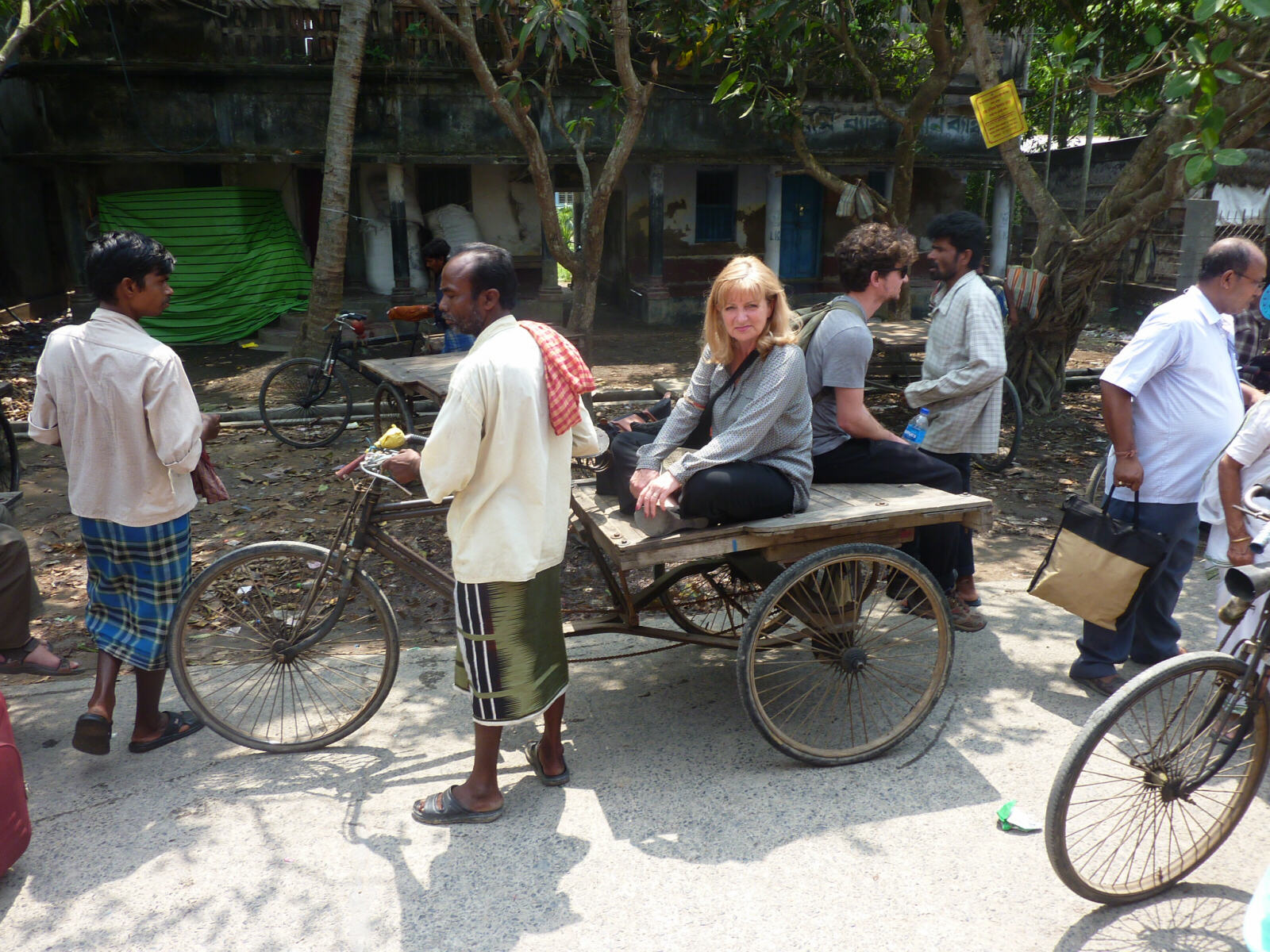
|
.... and a final ferry (which wasn't quite as crowded as this one!) to our island.
|
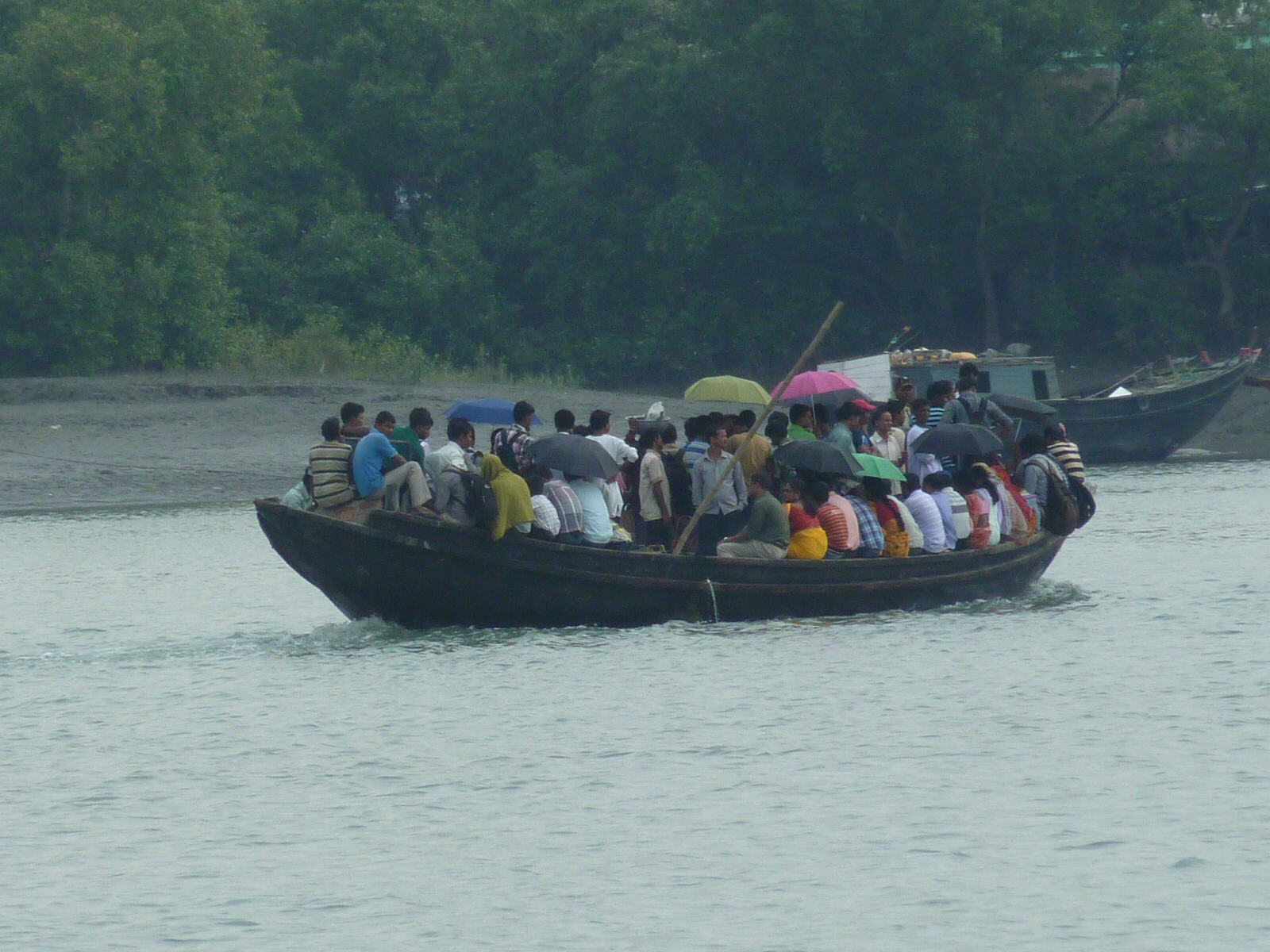
|
We checked into the ‘eco-village’ of thatched huts and I went on the village walk through the surrounding fields while Sheila went to bed to recover from the journey. |
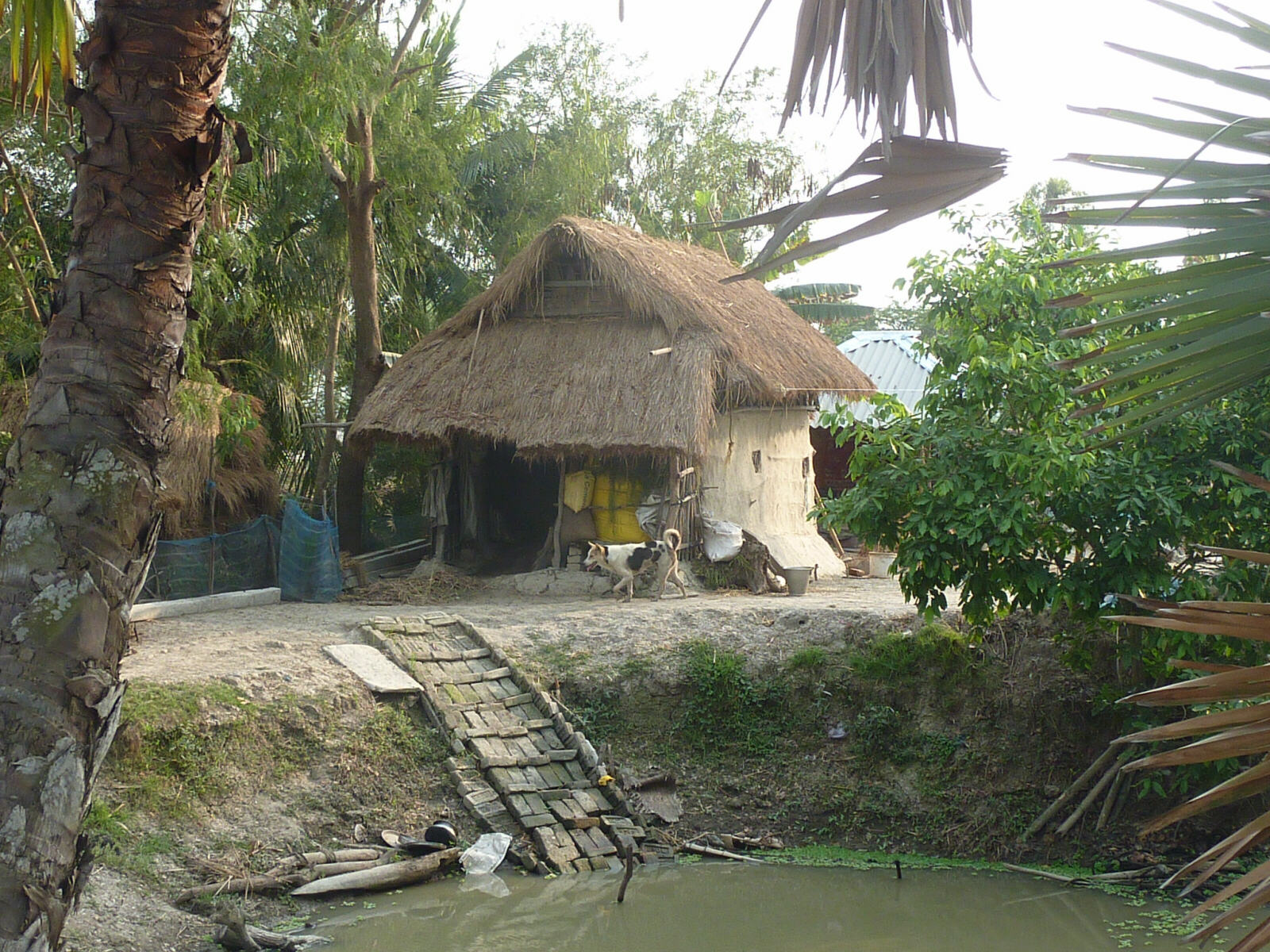
|
An ominous black cloud approached and we all ran back to the eco-village as the storm hit – the heavens opened, thunder and lightning crashed round us and the wind was terrific. Rain came in through the thatched ceiling of our hut, drenching the bed and bedding and leaving Sheila trying to sleep in a puddle covered in a soggy wet blanket. The storm blew away the bathroom window and the water pipe attached to it so there was no running water, demolished the kitchen hut so there were no cooking facilities, sunk one boat and grounded the other and turned the ground into a thick clay bog so after a short walk my shoes had ‘platform soles’. There was nothing else to do so I made friends with a nice gentle dog but then its friends got jealous and jumped all over me with muddy paws and dirtied the only clothes I’d brought, and then they had a big snarling fight with each other while I tried to separate them. Sheila remained totally oblivious sleeping in the puddle in the bed. The team eventually managed to cook some dinner but the evening entertainment was cancelled and there was no cock fight (thank goodness) which meant there was no chicken (the loser) for dinner. Nevertheless it was a pleasant evening sitting and chatting with Ray and Mary, a very nice couple from California, and the other guests. After trying to dry out the bedding we slept surprisingly well on the damp mattress despite the nearby temple's all-night drums and music. The exceptional storm and the damage it caused were reported the next day in the national Times of India.
Weds 26th. Sheila woke up feeling much better, so we went for the boat ride through the mangrove forest. |
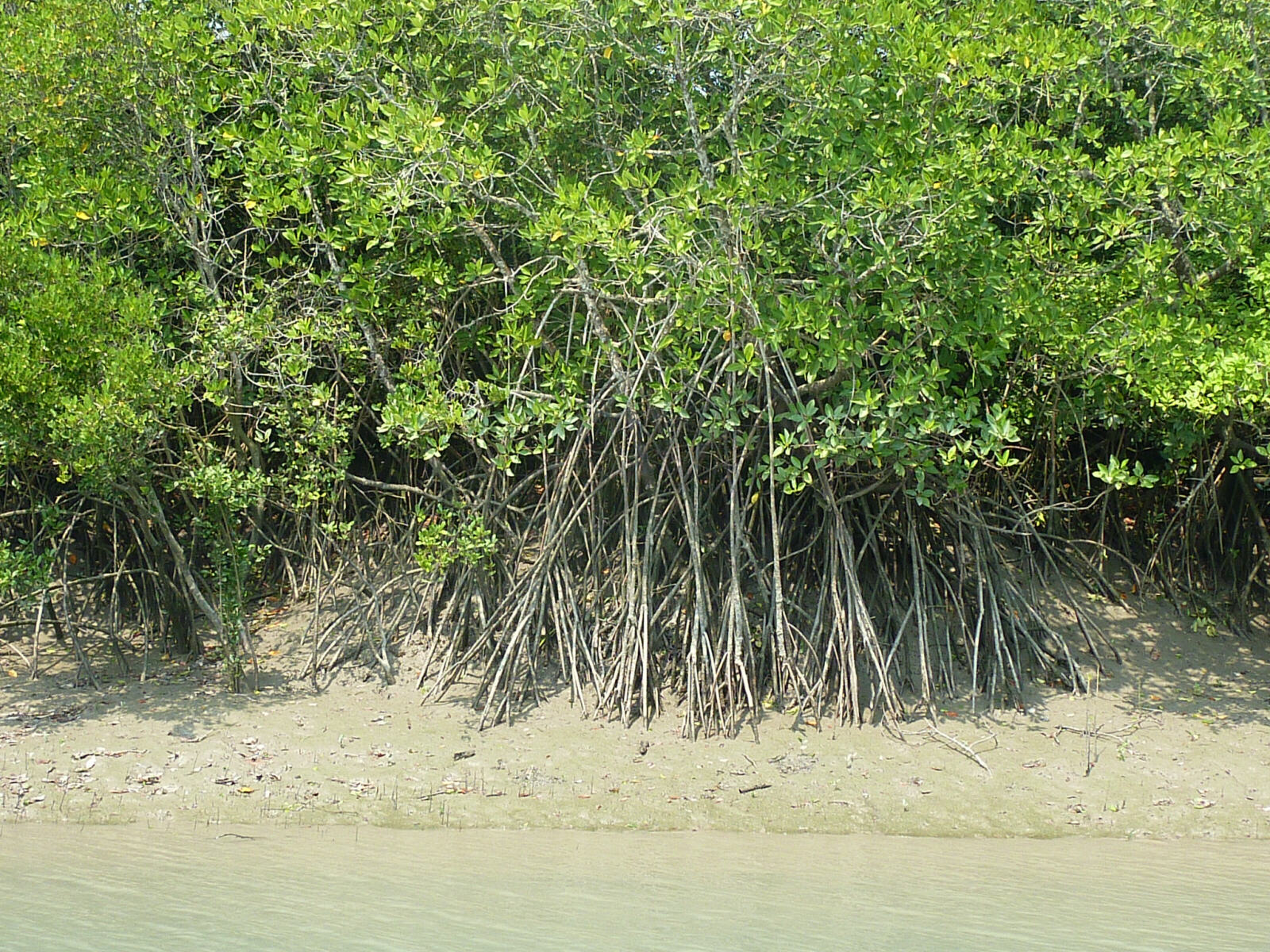
|
They had to hire a boat because ours were both out of action, but that one broke down and they had to hire another one. This meant we started the boat ride about three hours late, when most of the wildlife was having its midday snooze. We did see this rather prehistoric-looking Adjutant Stork. |
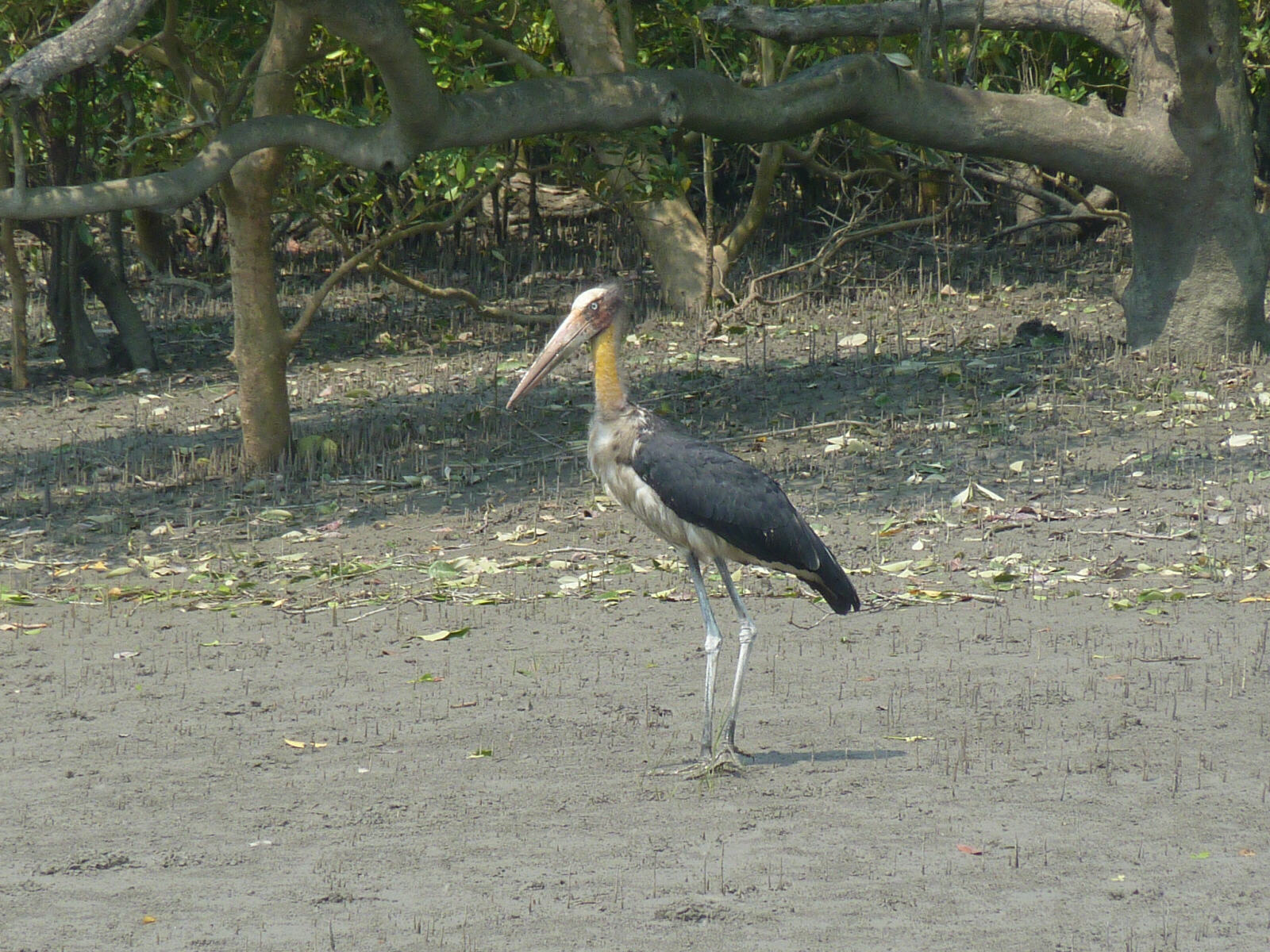
|
Nevertheless it was very pleasant cruising through the creeks, although the closest we got to a tiger was some tracks in the mud (and this poster!). |
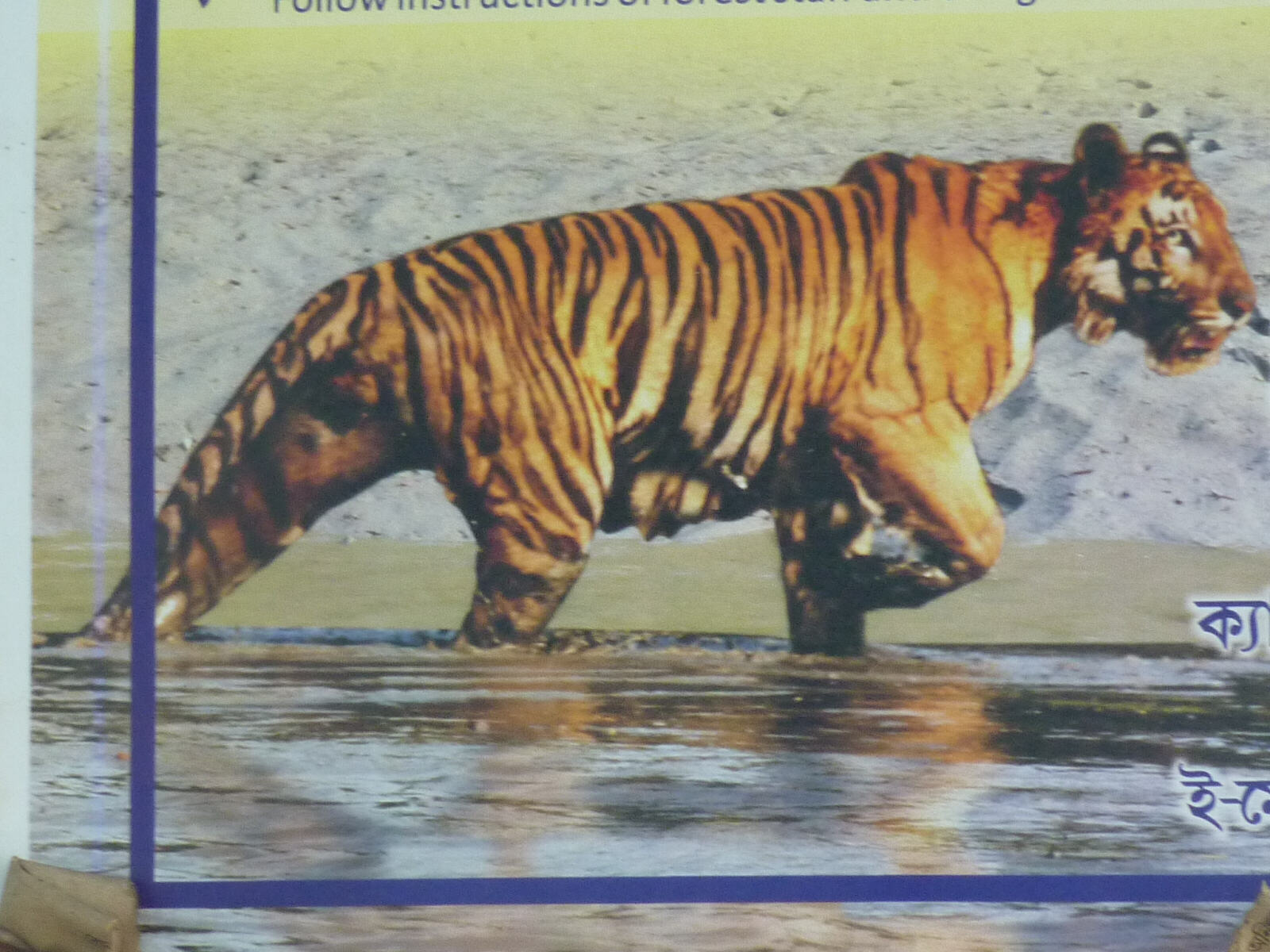
|
Sunset in the Sundarbans. Although the trip was a disaster, funnily enough we all had a very good time thanks to our guide and the lovely people who were on the tour with us. |
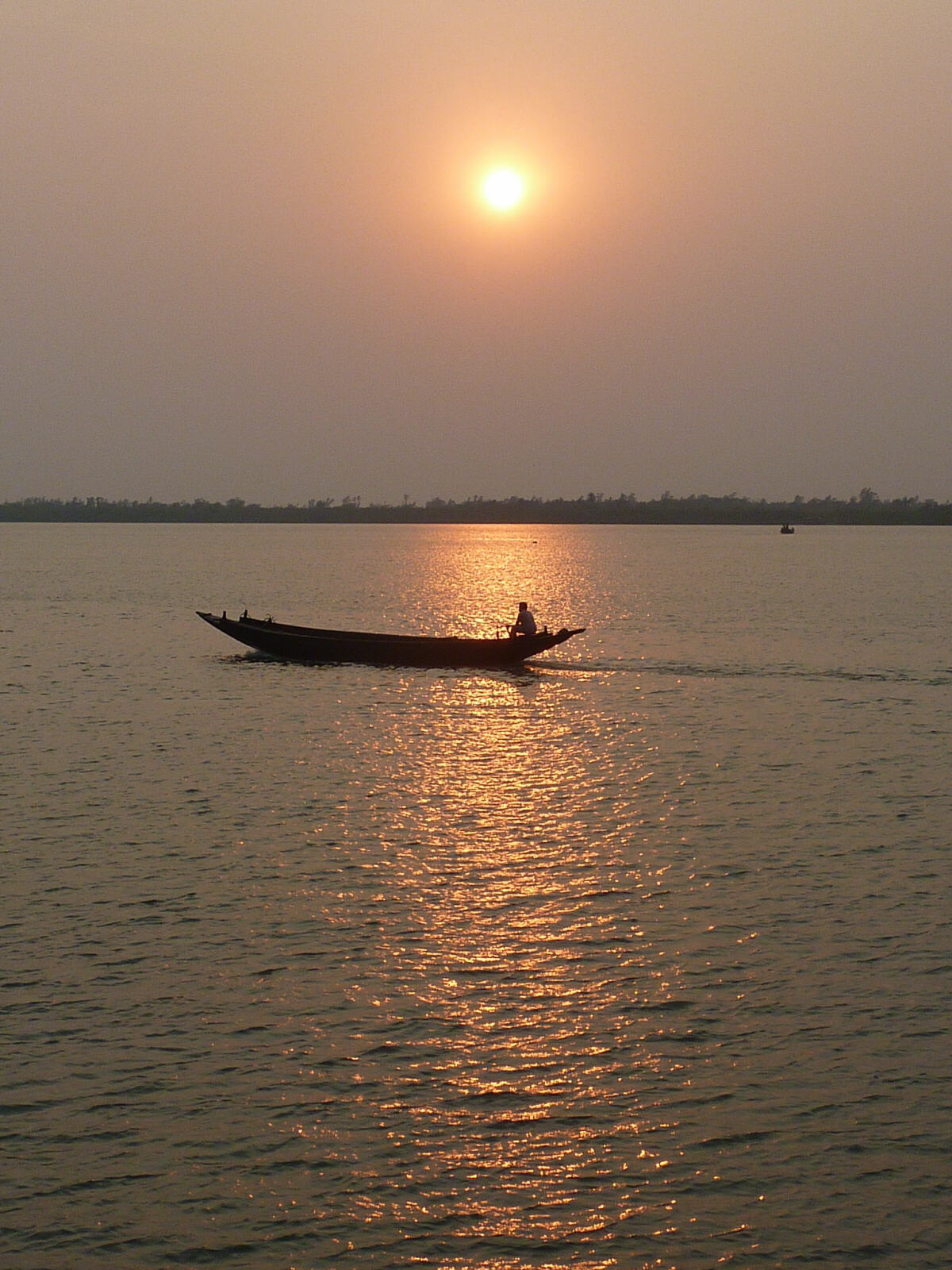
|
We left via a ferry, flat-bed cycle-rickshaws and another ferry, all of which Sheila enjoyed much more than yesterday, to the minibus and drove back to Calcutta. This time we checked into the Astoria Hotel on Sudder Street, another favourite we’d stayed at before, and had beer and peanuts at the bar across the street. |
Calcutta again
|
Thurs 27th and Fri 28th. It’s getting too hot to walk about much so we had quiet days in Calcutta with a bit of shopping, lunch at Blue Sky café and dinners at Trincas and Jimmy’s. This time we had no bad after-effects which was reassuring. Late on Friday night we went by Ambassador taxi to the airport and flew home via Doha.
One passenger had hand baggage that would seem unusual to anyone from outside the Middle East! (A hunting falcon.) |

|
If you would like to see more of our travels just click the map.

|